Kenya Fieldwork Experiences
Shaye Arwood Bio
Shaye Arwood is an MPH student in the Division of Epidemiology and Biostatistics, and a Global Health student. Shaye is conducting her APE in Kisumu, Kenya with Anza Mapema, a support group for gay, bisexual and other men who have sex with men (GBMSM) support organization founded by the Nyanza Reproductive Health Society (NRHS). Shaye will be developing a database for tracking participant activities at Anza Mapema and analyzing that data a to look at
associations between attendance at activities and frequency of clinical visits and frequency of HIV testing, and among HIV positive participants viral load. Shaye will also be engaging in community and outreach activities designed for HIV risk reduction.
Shaye Arwood Blog
Week 1 Blog
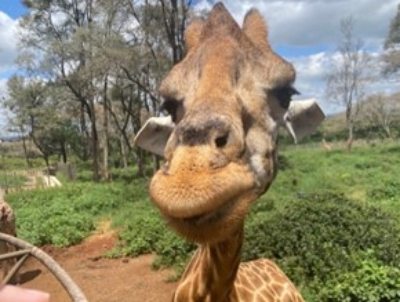
The flights to Kenya were long and exhausting, but the moment I stepped outside in Nairobi, it was all worth it. Sophie and I flew together and landed pretty late on Thursday night. We found Chief right away waiting for us outside and met up with Eglė, the third UIC student. The drive from the airport was pretty quick, but all of us spent the whole trip staring out the window and asking Chief a lot of questions. When we got to Chief’s house we saw that his wife had set up a big dinner for us, which was delicious.
The next day we got to sleep in a little and then headed to the Giraffe Center. We got to get up close and personal with the giraffes and even hand feed them. This one giraffe, Daisy, spent a solid five minutes rotating between Sophie, Eglė and I, to get the maximum amount of snacks. The giraffes were a little impolite cause they would reach their head across the walkway and stick out their super long tongue to try and snatch the bowl of snacks from your hands, but it was pretty funny. There were also a bunch of signs up that said, “Watch out for giraffe headbutts” because apparently if you tease the giraffes they will get very mad. Luckily we all walked away without injuries.
Week 1 Continued
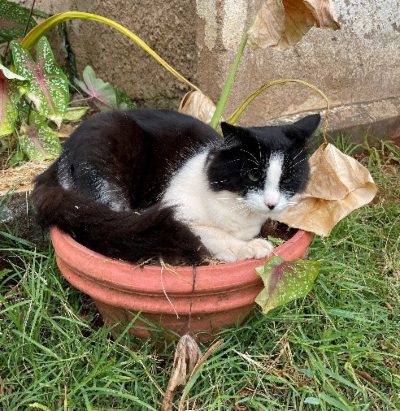
We also went to buy our Safari sim cards, or in Eglė’s and I’s case, a Kenyan phone to use while we’re here. That night for dinner we got to try ugali and fish stew, and I was blown away by how delicious it was. I never thought I’d be craving fish stew, but I definitely am now. The next day we got up early and hit the road for our six-ish hour drive to Kisumu. I was awake the entire time, staring out the window at all of the giant rolling hills and farmland. We even stopped a few time for pictures, like when we saw a big heard of zebras.
We finally made it to Kisumu and got to meet our host families. Sophie and I are staying with Betty and Koliya (though I think it’s really Tsotsi the cat’s house). We settled in pretty quickly thanks to how welcoming everyone was. Our first night we even went to a big birthday party with Betty and did quite a bit of dancing. Then we had a couple days to relax and get used to our home stays before we started work.
Week 1 Part 3
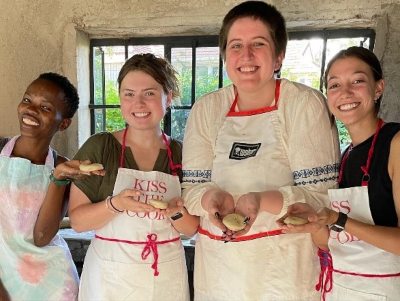
On Sunday, we went over to Eglė’s home stay, Lucy’s house. Lucy’s oldest daughter, Terry, really like cooking so we asked if she could teach us to make some things. We spent a good few hours learning how to make Chapati together. Terry was very patient with us, especially at the beginning when we were all struggling to roll out the dough right. Once we finally came to cooking the dough in a pan over a charcoal fire, I had to watch Terry flip the Chapati a dozen times before I finally worked up the courage to try it myself. By the end of the day, though, I would say we were all experts in Chapati making (thought definitely not as good as Terry).
Our first day of work was really exciting. Tom picked us all up in his truck and Sophie and I got to drop Eglė off at SWAP where they are working. Then we headed to UNIM where we both got a tour of the building and got to meet all of the staff. Sophie came with to Anza Mapema, where I’m working, to get a tour too. The first day was mostly spent getting to know everyone and settling into the work. I’ll be working closely with Edwin, who’s in charge of the Activities branch of Anza, and he’s made me feel right at home. He also helped me find a piki bike driver who will be picking me up and taking me home from work everyday. My first ride on the piki bike was so fun, it makes the ride to and from work exciting.
Week 2
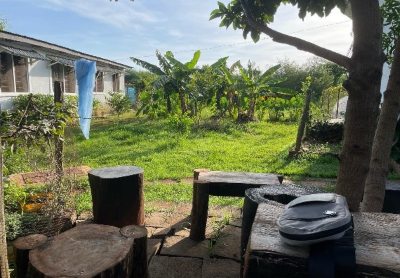
This weekend ended up being packed full of fun activities. On Saturday, we relaxed for a while in the morning and then headed to Java House. The menu is huge, and full of some American foods to remind us of home, like big messy burgers. One of our coworkers, Cate, joined us for lunch and then insisted we go to Dunga Beach. She was impossible to refuse, so we all took piki bikes, which are also called boda boda’s. Once we got to the beach we hopped onto a big wooden boat for a private tour of the lake. Our tour guide pointed out all the landmarks to us and told us all about the different animals hiding in the plants on the lakes shores. We also got to see how tilapia is farmed in big floating docks with nets full of fish. We walked out onto the docks for a little bit, but the walkway is very narrow, and we only lasted for a few pictures before we jumped back into the boat.
Week 2 Part II
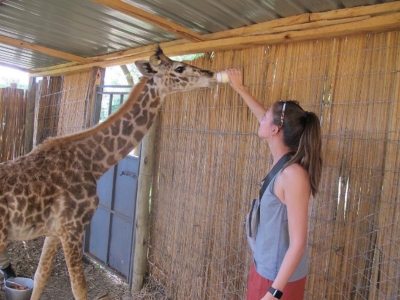
On Sunday, the three of us, and Cate, finally made it to the Impala Sanctuary. Right away one of the zookeepers, George, came up to us and offered to give us a guided tour. George brought us to the jaguar first and called her over to us by name. He let us get super close so we could pet the jaguar through the fence. He showed us all the animals, telling us their names and about their personalities. We got to feed some of the monkeys’ little pieces of fruit (carefully though, because they were sassy). Then he told us it was just about time to bottle feed the seven-month-old giraffe, so we figured we would get to watch. Instead, George ushered us into the giraffe exhibit where we each got to bottle feed the very hungry giraffe. It was so exciting to be so close to the giraffe, even closer than we had been at the giraffe center in Nairobi.
To end our day, we met up with another coworker, Ed, and went to a restaurant that was super close to the lake. We sat outside and relaxed for a while before it started to downpour, and we moved inside a big pavilion. Then we ate the best roasted pork I’ve ever had with lots of kachumbari (a mix of tomatoes and onions) and ugali.
Week 3
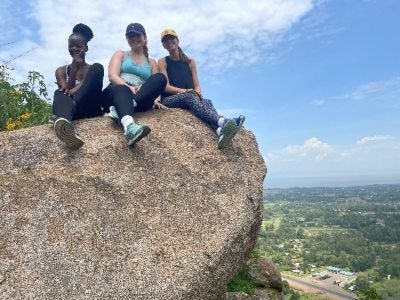
These past three weeks have gone by so quickly, and I can say I have officially settled into Kisumu. We have been on so many different adventures and tried all sorts of new food. Over the weekend we joined four of my coworkers on a hike up at Kisian Hills, which was supposed to be a big hill, but turned out to be a very rocky mountain. The path was very narrow, full of big boulders we had to climb over, and lots of thorny plants, but the view was worth it. We struggled our way up in the blazing sun but got to see all of Kisumu from the top. We had a little picnic with lots of snacks and music and relaxed for a while before starting to even harder journey down. Then we ended our day at Dunga Hill Camp, which is a big outdoor restaurant on the edge of the lake that has a huge stage with live music and dancing all night long.
Week 3 Part II
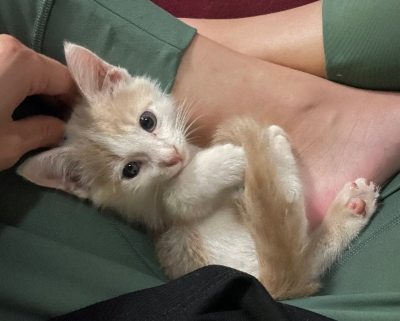
The next day we went to Java House for a big breakfast. We did a lot of relaxing to recover from the long hike and cool our sunburn inside. Sophie and I were in for an adorable surprise when we got home cause Koliya decided to bring a ginger kitten home since he’d been wanting one for a while. The kitten’s name is Harry Duke of Sussex, and he is so small he fits in one hand. But he is feisty and seems to think that hands are meant to be chewed on. Tsotsi is not a fan of Harry and is actively ignoring him, but I’m sure they’ll be friends eventually. Another exciting part of our house is that hippos love to come into our backyard at night. They come withing like fifty feet of the house and just graze around the backyard, completely unbothered by the three barking German shepherds Betty and Koliya have.
Regarding the new foods I’ve tried, the list is pretty big but there’s a few highlights. The other morning Sophie and I wandered to the kitchen to find an interesting looking food being boiled. We had never seen it before, but Koliya informed us that it was Ox tongue, and we were having it for dinner. Neither of us had ever had ox tongue before, and I was very curious about what the texture would be like. It was cooked all day long, and then served in a soup with vegetables and big noodles. The soup and ox tongue were quite possibly one of the best things I have tried so far on this trip, and I may need to convince Koliya to teach me how to make it before I leave. We also tried chicken gizzard, which Betty is a professional at cooking. The gizzard is considered one of the choice pieces of meat, according to Koliya, and it was definitely flavorful.
Last Friday, Anza Mapema hosted a huge event called Cultural Friday, which I was super lucky to get to help plan and be a part of. The theme was celebrating pride and diversity in the arts, which coincided perfectly with June’s pride month. Cate picked out fabric and had outfits made for Sophie, Egle, and I so we could dress the part for the celebration. The event consisted of karaoke, lipsyncing, dancing, modeling, face painting, coloring, food and more. The morning consisted of running around trying to set up all the different activities, and somehow Sophie ended up being a very in-demand face painter. We spent the whole day getting to know a lot more of the participants at Anza Mapema, and posing for many selfies.
Sophie Young Bio
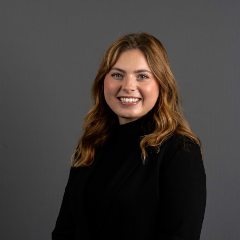
Sophie Young is an MPH student in the Division in Epidemiology and Biostatistics and is also a Global Health Student. Sophie is conducting her APE in Kisumu, Kenya with the Nyanza Reproductive Health Society (NRHS). Sophie will be working on data analysis of laboratory and WASH-standard related records for local sites, assisting with qualitative interviews and focus groups, and researching the background and risk factors for bacterial vaginosis and various reproductive health issues for vulnerable populations in Africa, specifically for women.
Sophie Young Blog
Blog 1
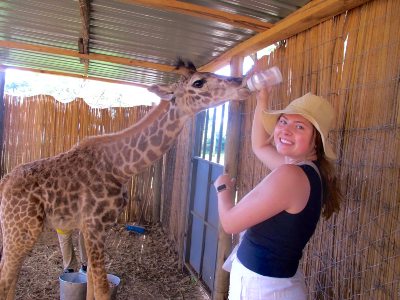
Our first few weeks in Kisumu have been very exciting! We began our trip in Nairobi, where we were able to hand-feed giraffes, tried our first slice of Kenyan pizza, and visited the mall to shop around. We then made the (rather long) journey from Nairobi to Kisumu, stopping for pictures along the way. We were able to see an expansive tea field where Kenyan tea is grown and harvested, and also saw some zebras along the side of the road. The drive was very scenic,and we could feel the weather quickly growing warmer. Since settling in Kisumu, we have had many exciting adventures. We met Betty and Kolye- who are very welcoming and have made our stay more than comfortable. Their charming cat Tsotsi is always up to something and has quickly become a fan favorite in our house. There are also three dogs, but you have to be careful- they love to jump and have very muddy paws. We attended a birthday party and tried Tusker for the first time. Last week, I started my position at NRHS with Dr. Otieno. So far, I have been able to observe the amazing work everyone here is doing, and have been able to assist in focus groups, laboratory work, and data analysis. I find the work both exciting and meaningful. Everyone at NRHS is very kind and have been so generous in sharing their work with me. Onthe weekends, we have been up to lots of adventures! We have tried many local restaurants and have loved the food so far. A colleague took us on a boat trip around Lake Victoria and we got to stand on the fishing cages out in the middle of the lake- they are huge to support the booming Tilapia business. We also dined with friends at sunset with a view of the lake-although we did get caught in a nasty rain storm. At this point, I think we have visited all of the malls in Kisumu and have made many purchases- they have the best jewelry and hand-made bags. The highlight of the trip so far has been our visit to the Impala Sanctuary. Our guide George is an employee at the sanctuary in charge of the animals. He took us all around the park, pointing out each animal and their name, and making sure to help us get amazing photos.We then got to bottle-feed the baby giraffe there, whose name is Ross. He’s seven months old.So far, Kenya has been a warm and inviting place and I can’t wait for more exploration.
Karissa Frazier bio

Karissa Frazier is a second year MPH student in Community Health Sciences and also a Maternal Child Health and Global Health student. This summer, Karissa will be living in Maseno, Kenya, just outside of the city Kisumu. In order to complete her applied practice experience, she will be working with the Maseno University School of Public Health assisting in the completion of a community health assessment for the Maseno area. Karissa is very excited to be able to learn about different global communities with a hands-on approach while learning about Kenya and all it has to offer from her host family and the friends and colleagues she meets along the way!
Karissa Frazier's blog
Karissa's blog post
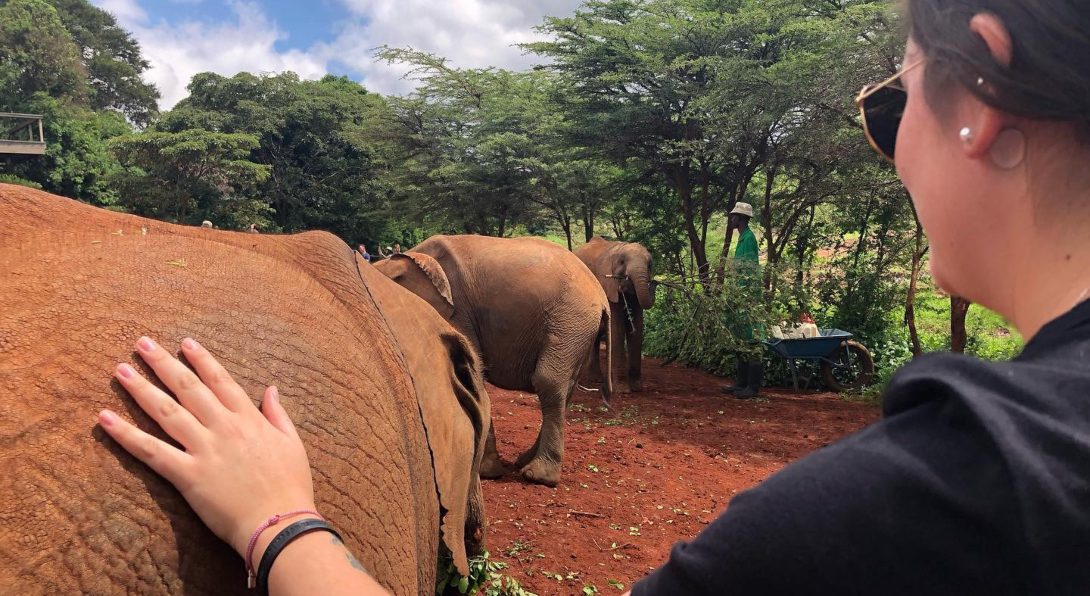
This first week has really tested me so far. Trying new things, meeting new people, trying to learn bits and pieces of a language I’ve never spoken before. It is a lot. But I am having fun and embracing the changes. This first week has been jam packed with new and exciting adventures. We (my travel companion and applied practice experience project partner Erica and I) arrived on a Thursday night in Nairobi. We were staying with a friend of Dr. Bailey’s named Chief. He was so kind and really made us feel at home in Nairobi. On Friday, myself and the four other students doing their field practicums in Kenya went to the Elephant Sanctuary and the Giraffe Centre. It was so fun to be up close and personal to these beautiful and elegant animals. We got to pet the elephants and even feed the giraffes. We were all laughing so hard because the elephants kept farting!
Karissa's blog post
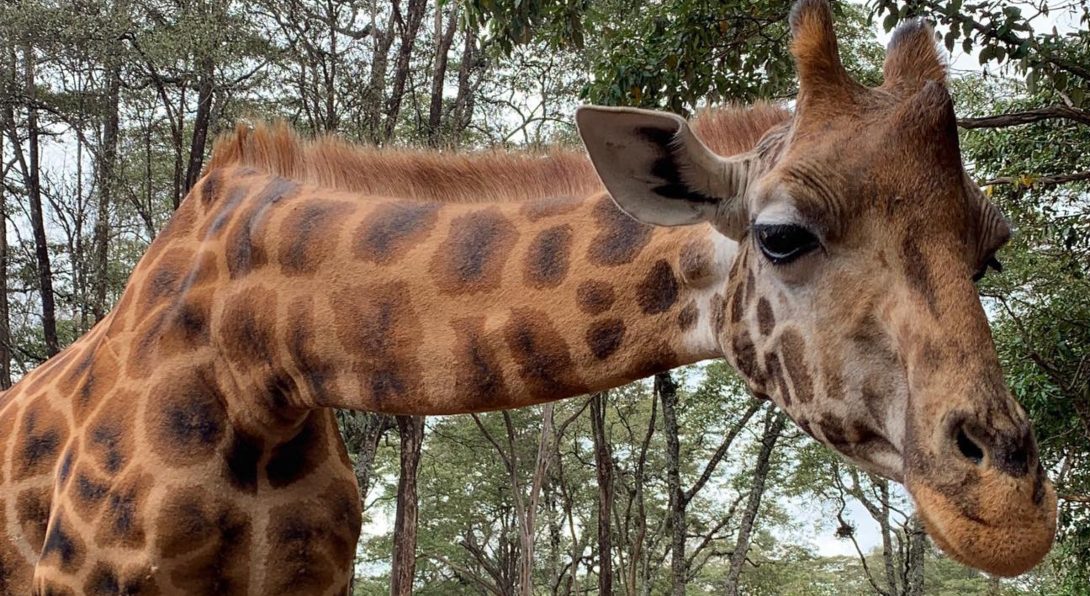
We also fed the giraffes by our mouths, so we got a nice slobbery kiss from the giraffes too– it was hilarious. It was an experience I will never forget. That night Chief and his family made us a huge feast and we got to meet and talk with some of Chief’s friends. We all played cards, laughed and had so much fun on our last night in Nairobi.
Karissa's blog post
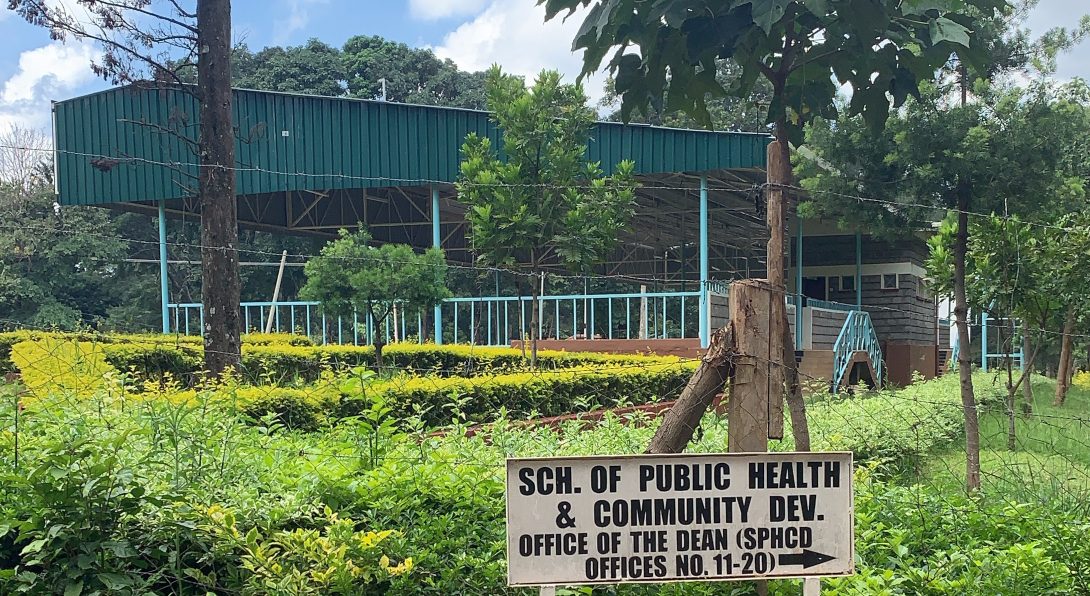
The next day we embarked on our long journey to Kisumu. It took us about eight hours to drive from Nairobi to Kisumu. We dropped the three other students in Kisumu and Dr. Bailey drove Erica and I to Maseno. Maseno is about a 30-minute drive by car and this is where Erica and I’s homestays are. He dropped me off first and I met my wonderful host family. I am staying with a professor of nutrition named Asenath Sigot. She is quite possibly the sweetest woman I have ever met, and it is safe to say I love her dearly. We became fast friends. I also got to meet Doris and Alex, her two housekeepers. Sunday was spent relaxing and trying to adjust to the time difference and sleep off the jet lag.
Monday was our first day of work at the University and Asenath’s son, Bethwel kindly walked Erica and I to the School of Public Health within Maseno University. Unfortunately, I was not feeling the best, as the Malaria medication had not agreed with my stomach, but I was able to make the 30-minute trek to the university. The meeting went very well despite my earlier sickness. We met with the Dean of the School of Public Health, Pauline, and one other faculty member from the School of Public Health, Louisa. We also were able to meet with a post-graduate student named Jerimiah as well as Dr. Bailey and our dear friend Gabby from UIC! At the meeting we discussed the work we would be doing over the next 9 weeks and agreed upon what was needed from everyone to move forward. They gave Erica and I a place to work and were so hospitable. After the meeting we headed back to Kisumu with Dr. Bailey and Gabby to buy a WIFI router and explore. Erica and I walked around a local market in Kisumu and quickly found out we were out of our element. Luckily, Paulina had given us the number of one of their post-graduate students at the School of Public Health and she was able to help us get a ticket for a Matatu back to Maseno. A Matatu is a small van that makes various stops and is a popular means of transportation for Kenyans. Marcy, the student, helped us buy our ticket and made sure we were on one of the ‘safer’ Matatu’s. We were so grateful for her help and kindness; we surely would not have been able to navigate our way back home without her. The Matatu only cost us 200 Kenyan Shillings which equates to 2 US dollars. Not bad for a 50-minute ride home.
Karissa's blog post
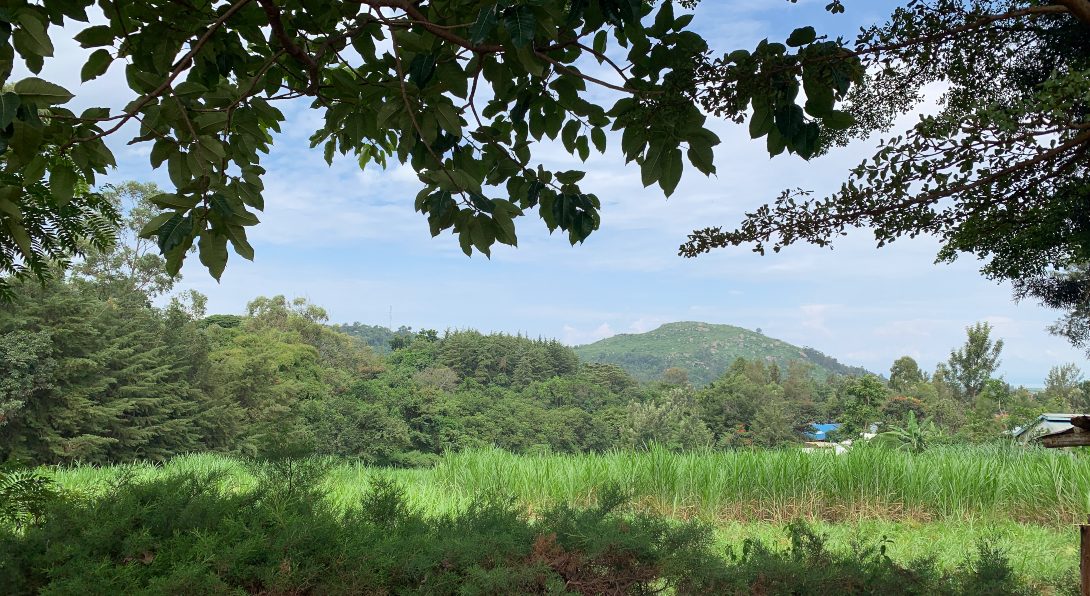
Over the next few days it was just Doris, Alex and I at Asenath’s house because she stays in Kakamega for work Monday – Thursday’s. I got to know Doris and Alex a bit better but I mostly stayed to myself. I luckily brought many books to read with me to Kenya, because after work I have lots of free time. I think that will be a common theme while I am here. On Wednesday, it was a Holiday, EID, so Maseno University was closed. Erica came over to my homestay and we had a relaxing day where we read and talked. It was much needed as we were still feeling the jet lag and lack of sleep.
Erica and I managed to find a short cut while walking to work and can now navigate our way without assistance. We always meet in the morning and walk together into work. We are trying to learn some of the greetings as we see lots of people on our way into the University. Most people are very nice, but just like anywhere you get a few people shouting various things at you that you just learn to ignore.
I am not entirely sure what I expected when I came to Kenya, but I was pleasantly surprised with how green and beautiful it is. And minus a few (dozen) bug bites, insomnia and malaria pill complications it has been a great first week. My host grandma is really amazing, and we get to talk about all sorts of things, from the amazing work she is doing, to her time as a student, our families and everything in between. I have also, for the most part, enjoyed the Kenyan cuisine; Asenath has a beautiful garden so we have been able to eat some of the fruits, they are delicious! She reminds me of my own grandmothers so it’s a little slice of home whenever I get to talk with her! My showers here are a little different, even from some of the other students because our house does not have working running water…but I am making the most of it. My shower consists of a bucket of hot water and a wash rag… I think I have a system worked out now so I should be a pro by this time next week.
One morning this week, I woke up and there was a huge cockroach on my mosquito net. I am generally not the best with bugs, but I did not want to embarrass myself in front of Doris, so I picked up my shoe and swatted at it. It fell to the floor and it looked dead. I checked on it a few times and it still looked dead, so I went to brush my teeth. When I came back to my room I looked, and the cockroach was gone. It is safe to say that I panicked. I went into the kitchen to try and explain the situation to Doris, but she didn’t quite understand. I brought her to my, room, and we found the bug and chased it all around the room. After what seemed like hours, Doris defeated the bug. We laughed really hard about it.
Doris introduced me to a few of her friends that live close by to the house. They were all so sweet and kind. One of them was an older woman who spoke no English at all. Doris was our translator and I ended up showing them pictures of my family and friends. She was so interested to know about how old everyone was. I decided it would be fun to take a picture of us on an instant polaroid camera so she could keep it and remember our fun conversation. I had Alex take a picture of the three of us and she loved it and had the biggest smile on her face, it made my heart so happy.
This weekend all of the UIC students are heading to the Kakamega forest so we are all looking forward to that. Erica and I are heading into Kisumu where we will meet up with the other students and get to experience Dunga Hill!
Karissa's blog post
We started off the second week with a trip to the Kakamega forest. Before the trip could actually begin Erica and I needed to go to Kisumu on the Friday for a meeting and to hang out with our other student friends in town. My host grandma’s son, Ben, drove Erica and I into Kisumu which was extremely nice of him. We had our meeting and discovered we were in for A LOT of work, but that was future Erica and future Karissa’s problem. We met up with one of our friends, Gabby, and they took us on our first Boda-Boda (motorbike). We did not fall off so I would call that a success. We arrived at Dunga Hill where we ate too much food and listened to the beautiful band playing live music. It was a really relaxing and nice way to end the first week.
Karissa's blog post
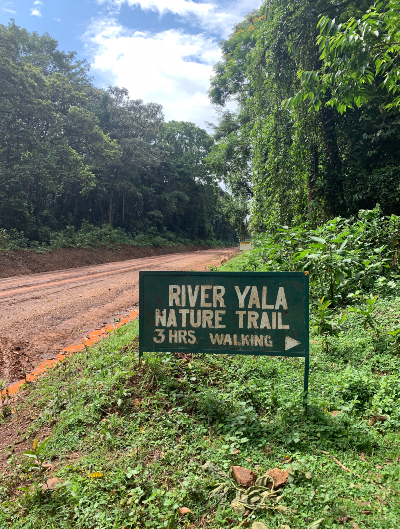
We spent the night at Gabby and Katie’s homestay, and we left for the Kakamega forest the next morning with Dr. Bailey and Stephanie. The car was a little cramped, but we arrived at the forest in just over an hour. The hike was truly beautiful, I have never seen so many trees in my life. It was a little harder than expected… mostly uphill and the coolest hike I have ever done. I only thought I was going to fall down the mountain every other step. There was really no trail once we got to the base of the big mountain (hill?) so we had to climb with our hands and feet. There was one point where I almost fell, and most likely would have tumbled down the mountain if it were not for the heroic efforts of one Gabby Lodge- they saved my life and I am forever indebted to them.
Karissa's blog post
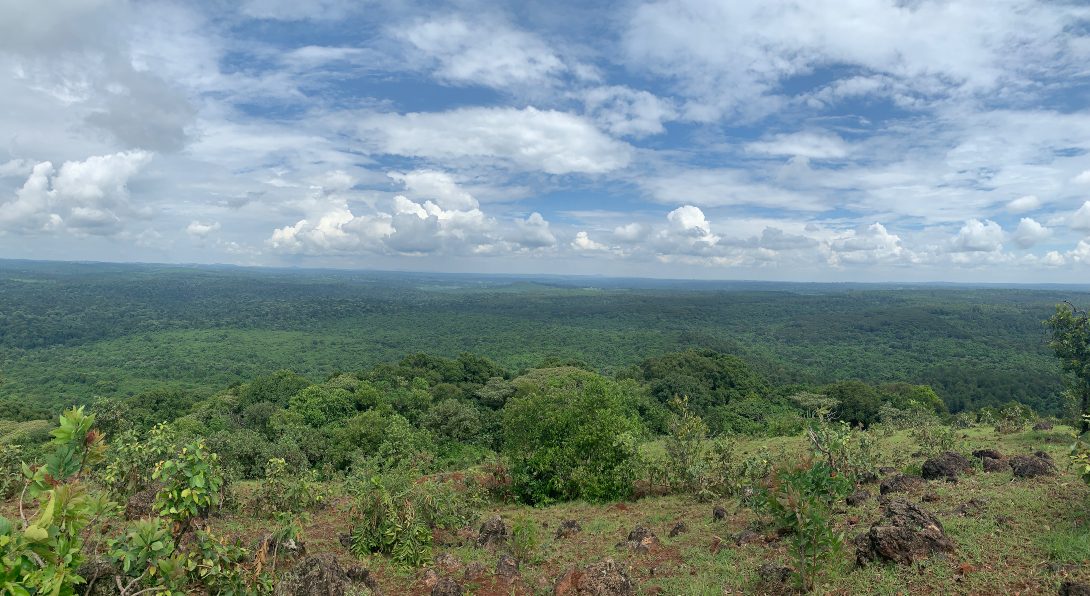
Once we got to the top it was amazing, we were out of breath, sweaty and feeling accomplished. The views were 100% worth it! We had lunch and then we went on a different hike, we got a little bit lost but eventually found our way back to the main road. I was surprised to see guava trees in the middle of the forest! They reminded me of my grandma!
Karissa's blog post
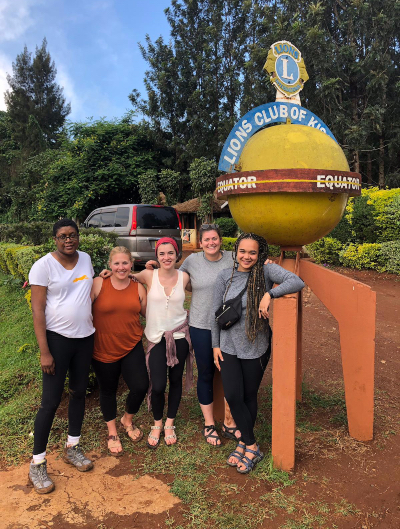
On our way home we were able to stop at the equator which is literally right down the road from where we stay in Maseno. We took a quick picture and finally went home. When I got home, I was covered in mud and exhausted. Erica spent the night because we had a lot of work to do on Sunday.
Karissa's blog post
Erica and I slept in and finally embarked on our journey to start and complete two questionnaires for the proposal. They needed to be done on Monday in order to be reviewed for submission to the board of ethics. We needed to create a household questionnaire and a women’s questionnaire. They included categories spanning from health perceptions, sexual history, pregnancy, nutrition, sanitation, overall health, chronic diseases and much more. We finally completed both questionnaires around 11 at night. Dr. Bailey was able to give us feedback and we finished the final products that night. The night, however, did not end here.
When we went into my room, we were both laying in our own beds (my room has two twin beds in it, perfect for slumber parties) when Erica said ‘I think I just saw something run across the room’. I was like yeah you are probably right, and I looked at the floor and this small dark creature darted across my floor. We are not good with bugs/small animals, so it was safe to say that we were freaking out. We were trying to find it to see what it was and if we could get it out of my room. We ended up getting a good look at it and it was a small mouse. It was hiding in the corner for what seemed like hours, so we decided we needed to lure it out of room so we could fall asleep without fear that it would eat our faces off (dramatic I know, but that’s where my mind went). I had digestive crackers so we set up an elaborate plan to move it into the hallway where we would be safe (HA). The mouse outsmarted us, and we were never really sure where it went but we think it was out of the room. We went to bed around 1:00am.
We did not end up having our team meeting (Team: Erica, myself, Dr. Bailey, Dr. Pauline Andang’o (The Dean of the School of Public Health at Maseno University, and Dr. Louisa Ndunyu Faculty at the School of Public Health at Maseno University) until Wednesday. The whole week was basically Erica and I unsuccessfully trying to figure out how to map out our potential study areas using GIS software. This was unfortunate for us because we do not take our GIS class until the spring. Through countless hours of trial and error, many YouTube videos and online forums we finally figured out how to get our maps into the software and create 200×200 meter grids on top of them. I do not think I have ever been so proud in my life.
On Friday, we were invited to attend a health training for local teachers for deworming school children. This is headed by the Ministry of Health; they give lots of medication for worms to schools in the Kisumu County and have this training so they know exactly how and when to administer the medicine. It was really cool to see how community health forums work in Kenya. Although this was not directly apart of our field experience it was really neat to be involved and to observe, everyone welcomed us and was so friendly! Later that afternoon Erica and I headed into Kisumu to meet some of the other students so we could head into Nakuru for the weekend.
Karissa's blog post
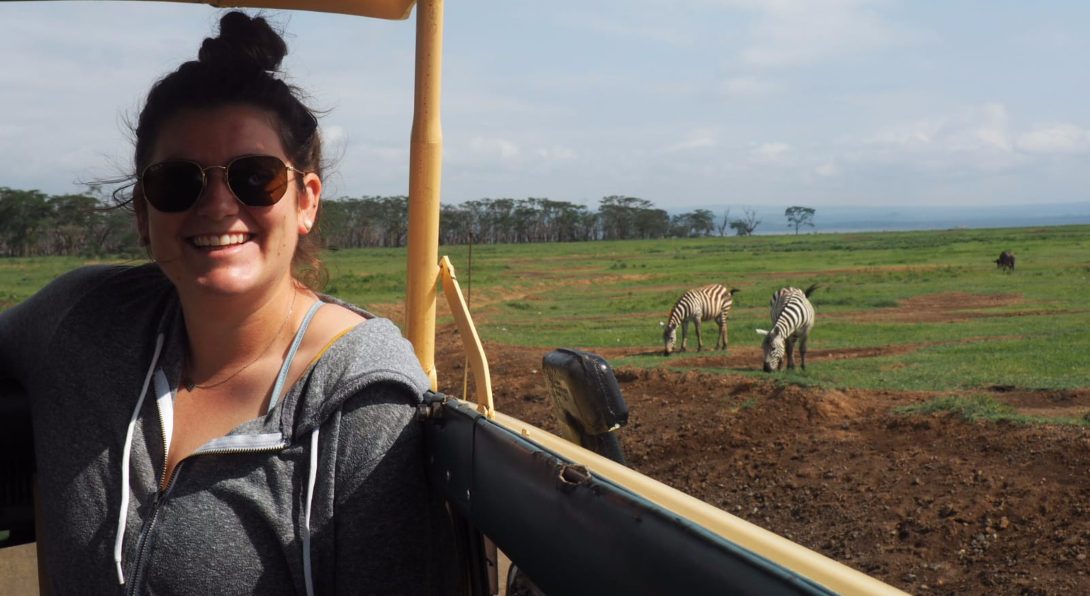
Before we met up with our friends, we went to Dr. Baileys clinic, UNIM and he gave us a great tour of the facility where we got to meet most of the staff and learn about their projects. We met the other students near a grocery store in town to try and find the right bus to take into Nakuru. Nakuru is a city in the Rift Valley and a little over three hours away from Kisumu. At this point of our trip Erica and I became quite savvy with transportation as we took a Matatu from Maseno to Kisumu, a tuk-tuk to UNIM and then we took a Coach Bus with Colin and Katie to Nakuru. This is all very cheap transportation, the long coach bus ticket only cost about 6 US dollars. We got to Nakuru where we stayed in a very affordable hotel and went straight to bed, as we were getting picked up early in the morning for our safari in the Lake Nakuru National Park.
Karissa's blog post
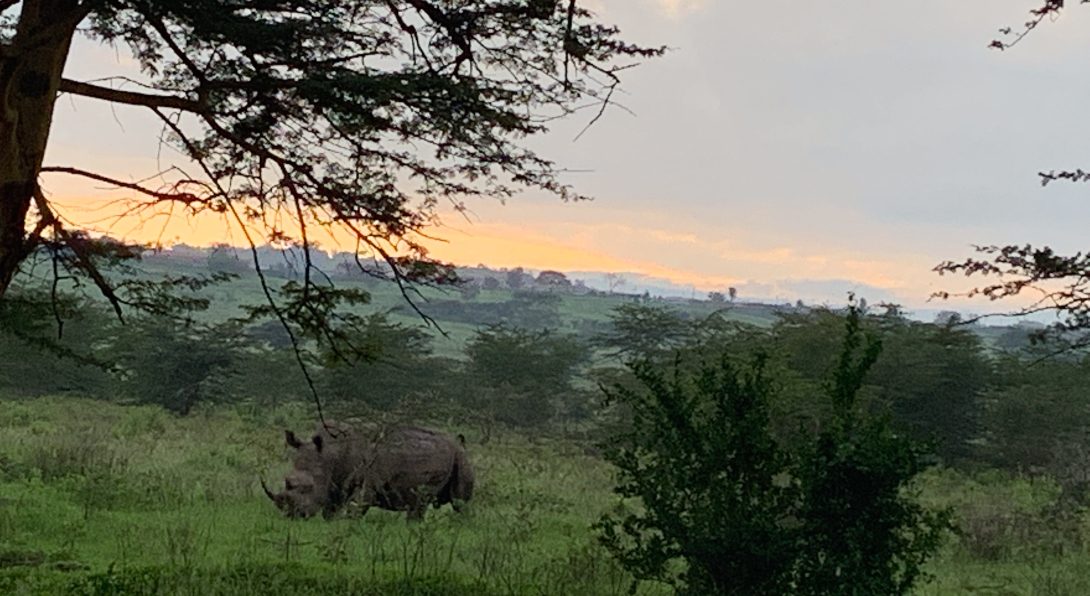
Saturday morning, we got picked up at 6:30 am and were driven to the national park. It was very close to where we were staying and only took about 15 minutes. We spent all morning driving around the park in a safari vehicle with the top raised up, so we were able to stand. It was such a beautiful morning and we saw so many animals. We saw zebras, giraffes, water buffalo, both white and black rhinos, flamingos, tons of different birds, antelope, gazelles, impalas, warthogs, a tortoise, jackals, baboons and monkeys.
Karissa's blog post
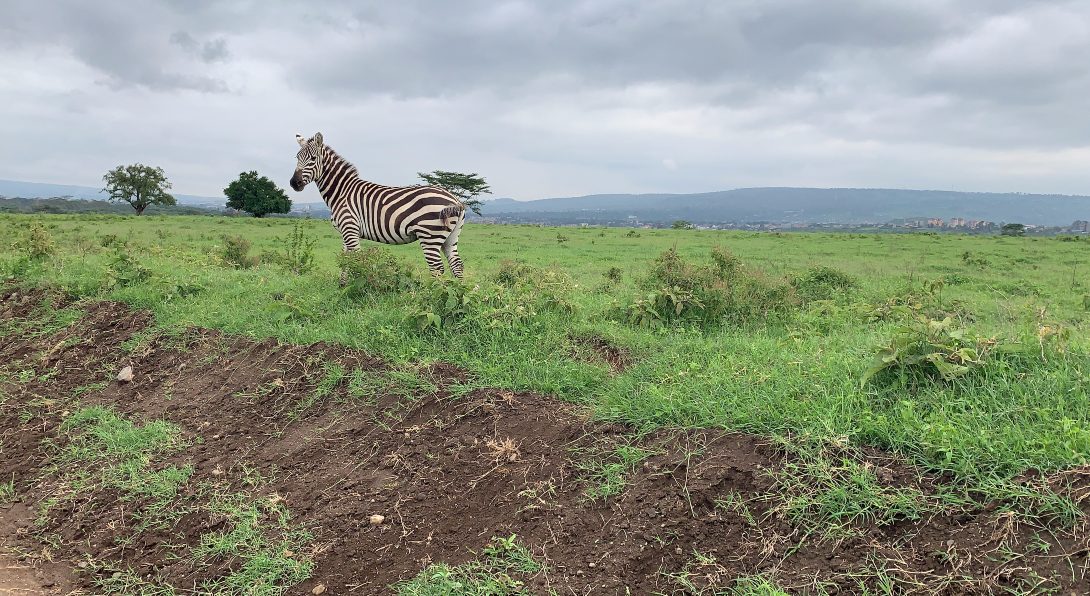
I am sure I missed some animals, but it was so neat to see all of those animals living in harmony. We did not see any of the big cats, leopards or lions but overall the day was a great success. We stopped for lunch at one of the resorts in the park and it was a nice break to the day. Around 7:00 pm our tour ended, and we stopped at a gift shop on the way out. Everything in the shop was hand made by members of the surrounding community. They had more figurines, trinkets, paintings and other art decorations than I have ever seen in my life. I am proud to say that I am the new proud owner of a few treasures, but most importantly a pair of Ebony elephant bookends. I was proud because there were no prices in the store, so you had to bargain your own price. This was difficult but I think I did a good job considering it was my first-time bargaining. After the barter session we were starving and noticed there was a KFC in town, so we stopped there and had some fried chicken. KFC is really the only American food chain we have seen in Kenya so far. It was such a long day that we were all exhausted once we got back to the hotel, we chatted for a little and looked through our pictures from the day before heading to bed.
Karissa's blog post
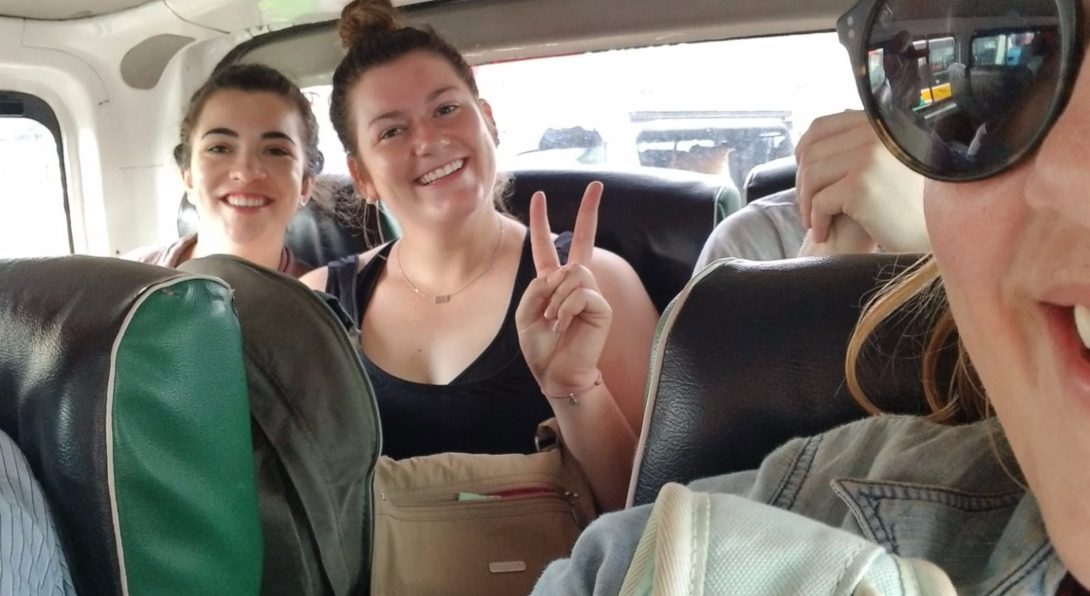
The next morning, we did not really have a plan. The hotel provided breakfast, so we ate there then decided to venture into town and try and find a way home. We thought it would be simple enough to find a bus to take us back to Kisumu, but we were sadly mistaken. Our mistake was we didn’t realize it was the last day of a school break for most Kenyan’s so tons of students were all heading back to boarding school. All of the buses were full. We tried to find other bus stations but after walking for about an hour we were unsuccessful. A very nice man saw us (looking lost I’m sure) and offered to take us to find a way home. It was looking like a matatu was going to be our only way home. This was not ideal because matatu’s wait to leave until all the seats are full and they normally pack the matatu’s to the max capacity- you may think this means everyone has a seat, but you would be wrong– this means that people sit on laps, they crouch on the floor space and sit 5 persons in 3 seats. As this was our only option, we jumped in the back and waited an hour before we left. It was cramped to begin with, but we stopped and picked people up whenever someone was standing on the side of the road. At the highest capacity we had 21 people in the 14-person van! We finally arrived in Kisumu in one piece and needed some food and to get out of a car. We had lunch at a place in town called the Laughing Buddha, which was a relaxing and fun way to end the weekend. This however was not the end because Erica and I needed to get back to Maseno. Because we did not want to ride in another matatu we opted to take a tuk-tuk back, it is a little more expensive, but we thought it would be worth it. As it turns out we were wrong because although it was just Erica and I it was a very bumpy ride and took much longer than a matatu would have. There are no stop lights or stop signs in Kenya, so to control vehicles speeds there are speed bumps EVERYWHERE – so it was an… experience. It was an adventurous weekend to say the least!
Karissa's blog post
This week Erica and I did not have much work to do since we were waiting for the Ethics Board approval for our proposal. Pauline and Louisa set us up with some students who were on their attachment (fieldwork) and we were able to shadow them in the field. Their project was very similar to our proposal but on a much smaller scale. They had a community household survey and were planning on getting 12 questionnaires filled out in 3 days. Our team consisted of two students from Kabarak University in Nakuru who were staying in Maseno for the summer, Kennedy and Betty, and our friend we met previously who is a student at Maseno University, Jeremiah. Most importantly was our team lead, the community health volunteer named Edward. Edward is a pivotal part of the team as he knows all the households in the community as well as how to get there and who lives there. Without him and all the community health volunteers it would be near impossible to navigate a community. Community health volunteers generally have 100 households they are responsible for. They check in on the general health of each member of the house, give referrals and pass on any health-related information to the community members.
Karissa's blog post
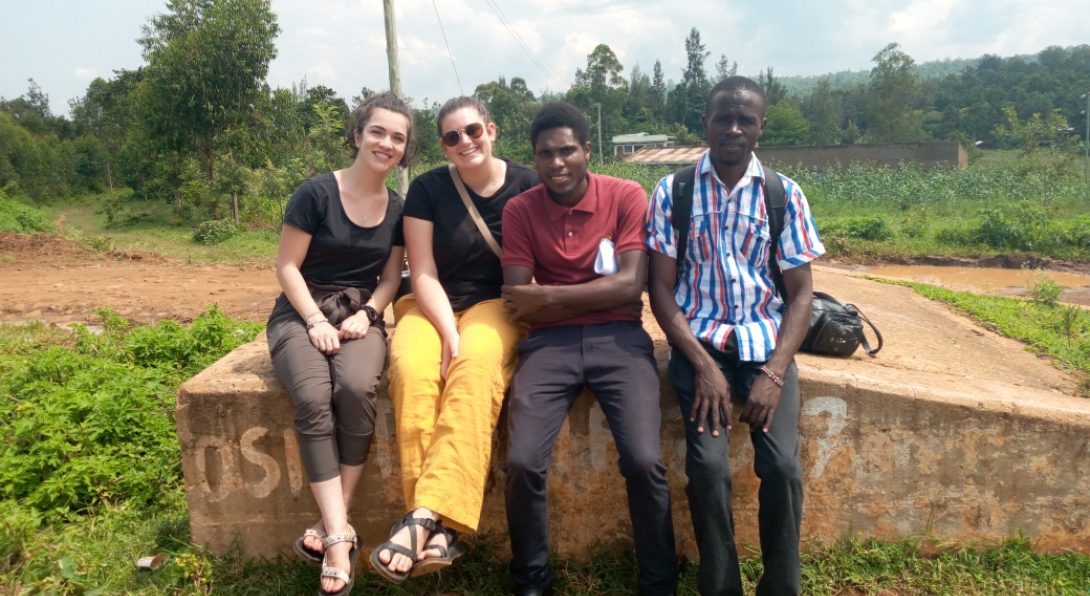
On Wednesday, Jeremiah met us in Maseno and took us to the community to meet the team and get started. Our small group split into two so we could cover more ground. I was with Kennedy and Edward. I was able to observe the questionnaire being administered and they even let me administer one to a woman who spoke English. I was so amazed at how willing everyone was to let us into their homes. It was nice to see how other communities looked and how the typical Kenyan household operated.
Karissa's blog post
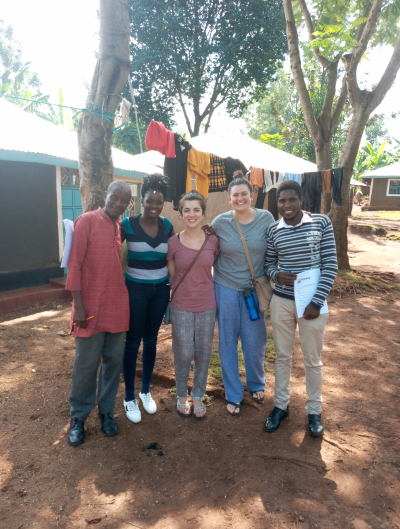
On Thursday we were invited to go to the community again, but this time Erica and I had to get there ourselves. It was fairly simple we just got on a Matatu and were on our way. We are pretty proud of our navigation skills. Erica and I were the first ones there, which was unsurprising because we have started to notice that being on time is not such a priority here.
It took about an hour for everyone to arrive. We were surprised with a nice breakfast layout at the community health volunteers’ home. His wife had prepared an amazing breakfast for all of the students! We stayed and ate and drank tea for about an hour before we got on with our work. We finished all of our surveys and Edward wanted to take us to see an orphanage that he frequently works at. We were unexpectedly brought into a classroom where we were meant to say a little about ourselves and offer words of encouragement about continuing education and working hard. After we were done visiting the orphanage, we decided it would be best to walk home because it was fairly close to Maseno. We walked through the backroads of villages and somehow, we were able to find my homestay! It was a hot day, so we all came in and had some water to relax.
Karissa's blog post
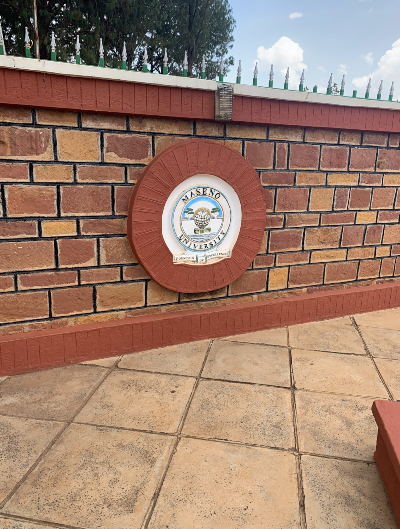
Because we finished all of the surveys in 2 days instead of 3, Erica and I had Friday off. With this time off we decided to do a little exploring. We had not really been able to see much of the campus besides the school of public health, so we ventured into different parts of the campus for a few hours to get a feel of the area. We sat for a few minutes and watched a family of monkeys jump from building to building. It was a nice day!
Saturday and Sunday, we had no plans, so I did a whole lot of nothing besides reading and watching TV. It was such a relaxing two days that were much needed after the crazy busy first few weeks.
Karissa's blog
This week at work Erica and I just made some revisions to the proposal. We had a meeting on Monday where we were able to talk about some of the actual survey logistics. It was helpful as it cleared some questions up. On Tuesday we got the revisions back from the Board of Ethics. We had to change some survey areas and create new maps. This proved to be a little difficult because there are frequent border disputes throughout different counties in Kenya. The online maps are not quite accurate, so we needed to have help from someone who knows the current boundaries.
On Wednesday after work Erica and I were walking home when it started to pour. For some reason I did not bring my rain coat but Erica had her umbrella. The umbrella worked well until we had to split up and walk our separate ways home. By the time I got home I was sufficiently wet and muddy.
On Thursday we were able to meet with someone at the school of public health who was an expert at borders. We spent the whole morning trying to understand which borders were for which sub-location. In the mid-afternoon we actually went on a drive with Pauline and Louisa to actually see where the borders were.
Karissa's blog post
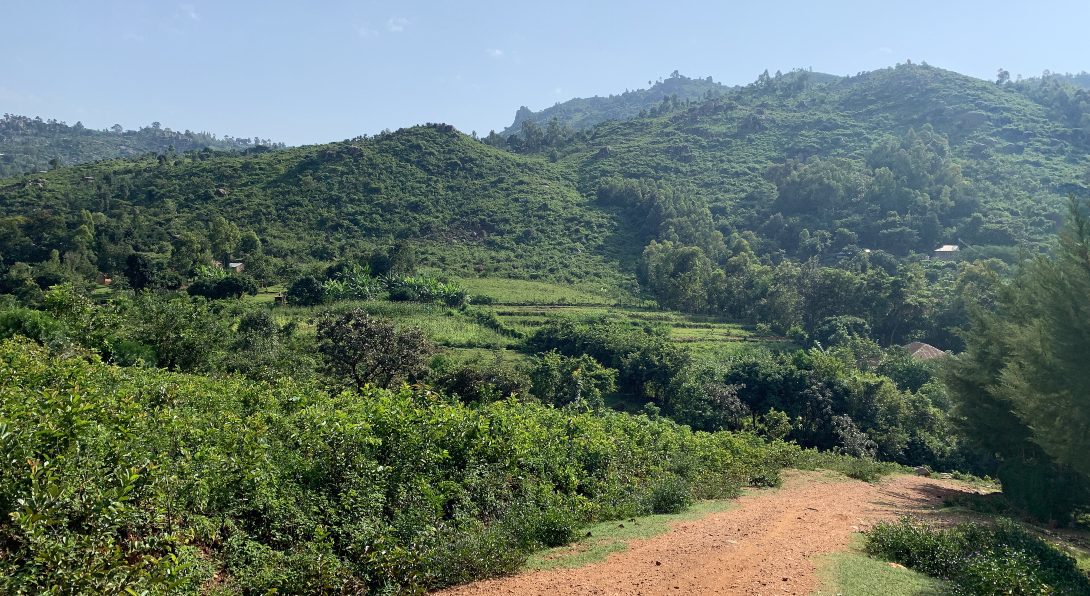
On Friday morning, Erica’s host mom, Grace invited us to go to a community library with her and her daughter. We drove most of the way to the library then parked the car and walked down a hill to find the library. The library is situated in a house that was donated by two women to the community. It was very beautiful and filled with lots of books including text books and classic American teen books. We spent about a half hour there looking at books and their very beautiful garden. On the walk back to the car there was a nice stream with a little waterfall where we stopped and explored and took pictures.
Karissa's blog post
Erica and I worked for a few hours on some maps then headed into Kisumu for the weekend. We hopped on a matatu (crowded and overbooked, no surprise) and went to Java House, a coffee shop and restaurant like Starbucks. Erica and I ordered iced coffees and split a burger and a breakfast burrito. It was heavenly. Later in the afternoon Erica and I met up with our friend Gabby at a hotel in Kisumu. It was so nice; we swam in the hotel pool for a while and then we all got pedicures at the hotel spa (They were around $8 US dollars and the best pedicure ever). We headed to the other student’s homestay for the night where we ate dinner, talked for a while with their host mom and then watched the first half of the US women’s soccer match against France.
Karissa's blog post
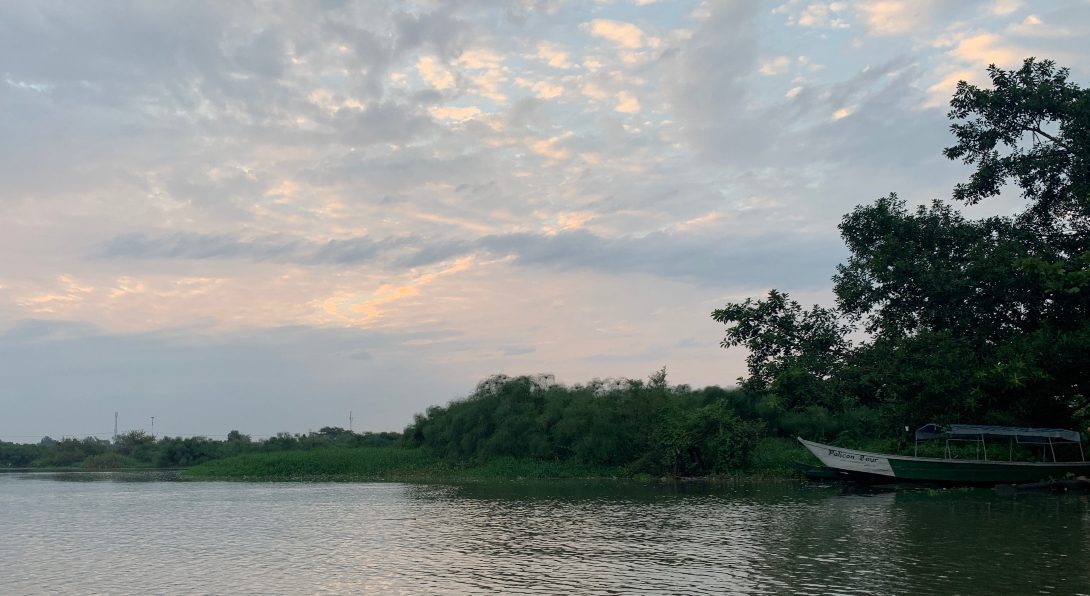
The next morning, we got an early start to the day with a 6:30am boat ride on Lake Victoria. Katie, Stephanie, Erica and I all took the 3-hour boat ride and saw tons of hippos and many different kinds of birds. Our tour guide was very knowledgeable, and it was such a relaxing morning. There were hardly any people on the lake, it was so tranquil and quiet.
Karissa's blog post
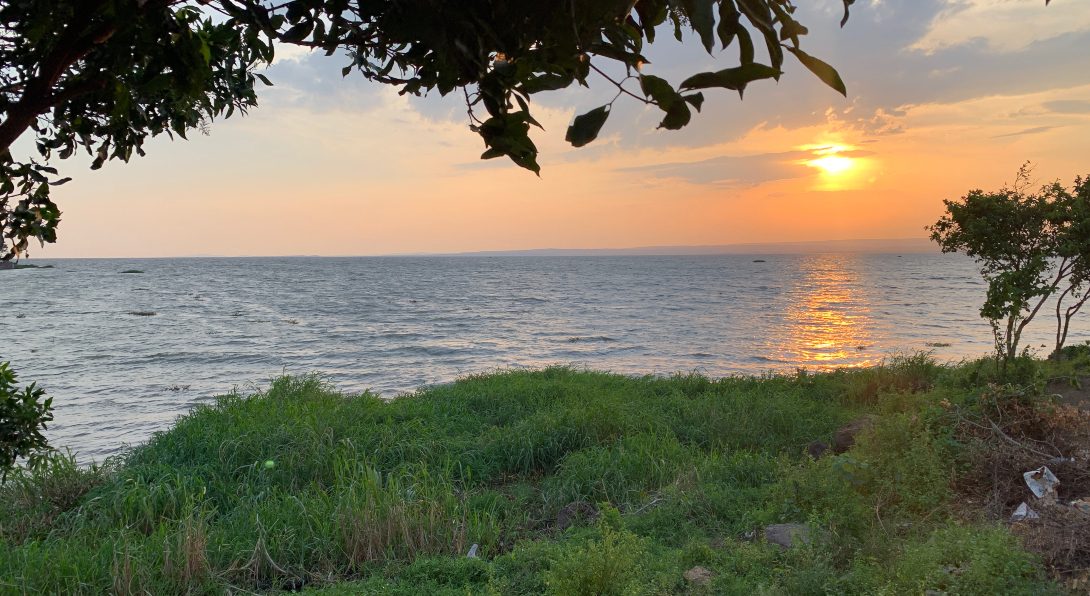
After our boat ride we went into town to grab breakfast at Java House. (We have to get as many iced coffees as we can get since there are none in Maseno). We headed back to their house and sat by the lake for an hour and a half. We laid in the sun and played cards, I even took a little nap (I would come to regret that as I quickly learned I had gotten sunburned). Around 2:00 pm Katie, Erica and I headed to Dunga Hill for some refreshing drinks and food. Stephanie met up with us a little later and Colin came a few hours after that. We spent a lot of time drinking, eating, talking and playing cards. It was a nice afternoon/evening, we even got to watch the beautiful sunset. We knew it was time to go when the lightening started, we thought we could beat the rain but alas, it got us. We were properly soaked by the time we got back to their house.
Karissa's blog post
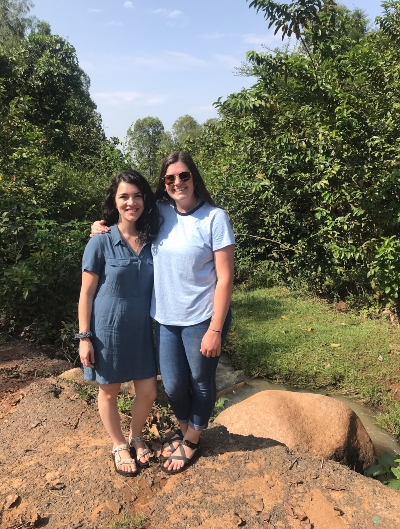
On Sunday we headed into town again (shocker, Java House) and ate breakfast and planned some trips for our remaining time here. Getting to Java House and back each day we took boda-bodas (motorbikes). Erica and I never take boda-bodas, but it is the way of life in Kisumu, so we did it and it wasn’t too bad! We have officially mastered all kinds of public transportation in Kenya! Erica and I took a matatu back to Maseno and she came over to do some work on the proposal translation. On Sunday afternoon we received some translated versions of questions for our questionnaire, so we needed to input the translations for Swahili, Luo and Luhya languages for every question. That took Erica and I a few hours to do so she ate dinner at my homestay (Chapati (flat bread that is somewhat like a tortilla) instead of the usual Ugali) and then we watched a movie and we had a slumber party. On Monday we would have another team meeting and hopefully be able to submit our revisions of our proposal to submit to the Ethics review board again. I can’t believe we are halfway done!!
karissa's blog post
Our fifth week started off with a very long day on Monday. We were still implementing changes for the ethics approval and adding in the translations for the questionnaires. We reformatted the entire questionnaire to make it more concise and easier to read. Throughout the week Erica and I just worked on the reformatting and started the Access database for assessing the data. Erica did most of the Access database because the program does not work on Mac computers, which I have so I had to find a loop hole that took some time. The database took some time and we are still working on it, but that took up most of our work week.
On Friday we embarked on our journey to Jinja, Uganda for a weekend trip. Two of the students in Kisumu were joining us so we devised a plan to meet up, so Erica and I did not have to back-track all the way to Kisumu. The Matatu to Jinja goes through Maseno so we had the two students, Katie and Stephanie, buy us tickets for the Matatu in Kisumu so we knew we would have a seat when they stopped in Maseno. Our plan worked and when they got to Maseno Erica and I were ready and hopped on. This was a Bungoma line Matatu, which is one of the better lines. They only sell the seats and do not cram as many people as they can into the van. Erica and I were pleasantly surprised: we had our own seat, a seat belt, the window down and music in our ears. It was truly amazing.
karissa's blog post

We got to the Ugandan border and went through Immigration, we had to buy a visa for the weekend which cost $50 US, kind of a bummer but the weekend was well worth it. Once we got through immigration, we took a Boda-Boda (motorbike) to where the Matatu’s were in order to go the rest of the way to Jinja. This Matatu was a little more cramped, but it was not too bad; we did make frequent stops to drop people off and pick people up, but it was fine. There was a little hiccup in our journey when we suddenly heard a really loud popping noise, and we had a flat tire. We probably only waited 10 minutes before they fixed the flat and we were on our way again. We finally arrived in Jinja (6ish hours later) and took another Boda-Boda to the base camp of where we were staying.
karissa's blog post
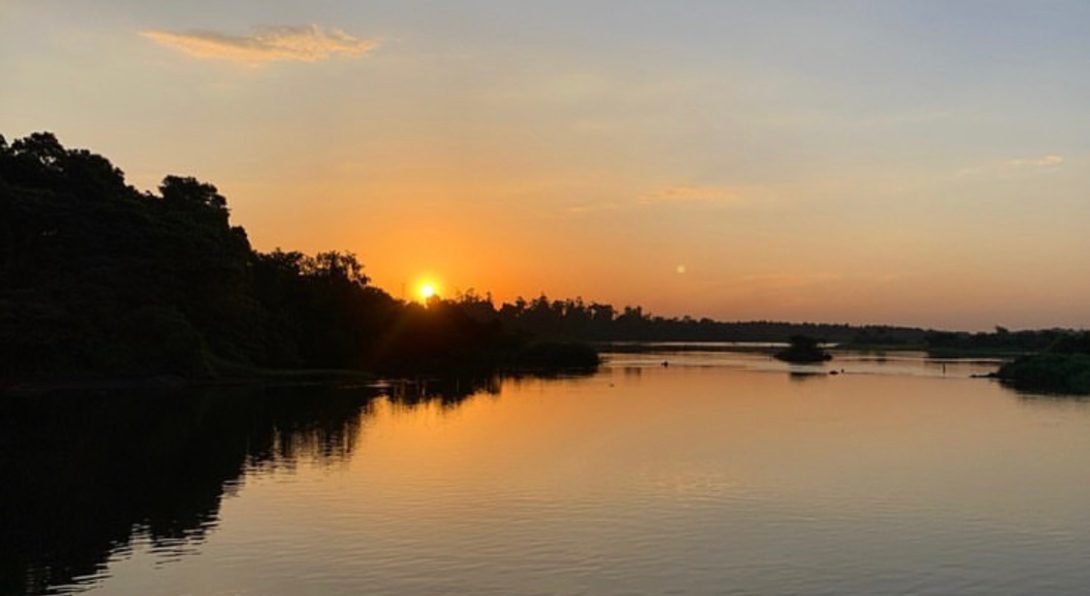
We got there a little early and we were starving; we had heard about this little place with a few different restaurants, so we decided to give it a try. We were so excited because there was a little Mexican restaurant there, I got a burrito and it was heavenly. We walked back to base camp and a driver took us to where we would be staying, about 25 minutes away right on the Nile River. We checked in, quickly put our belongings in our tents and rushed off to embark on the sunset cruise of the Nile. It was only our group and one other group on the cruise, so it was super peaceful. It was all you could eat and drink and absolutely beautiful outside. We listened to music, saw some otters, talked with the other group about their travel adventures and went back to camp two hours later. We headed to bed pretty early that night after a long travel day. Erica and I shared a tent and we woke up around 7:30 the next morning to get ready for our crazy day of rafting.
karissa's blog post
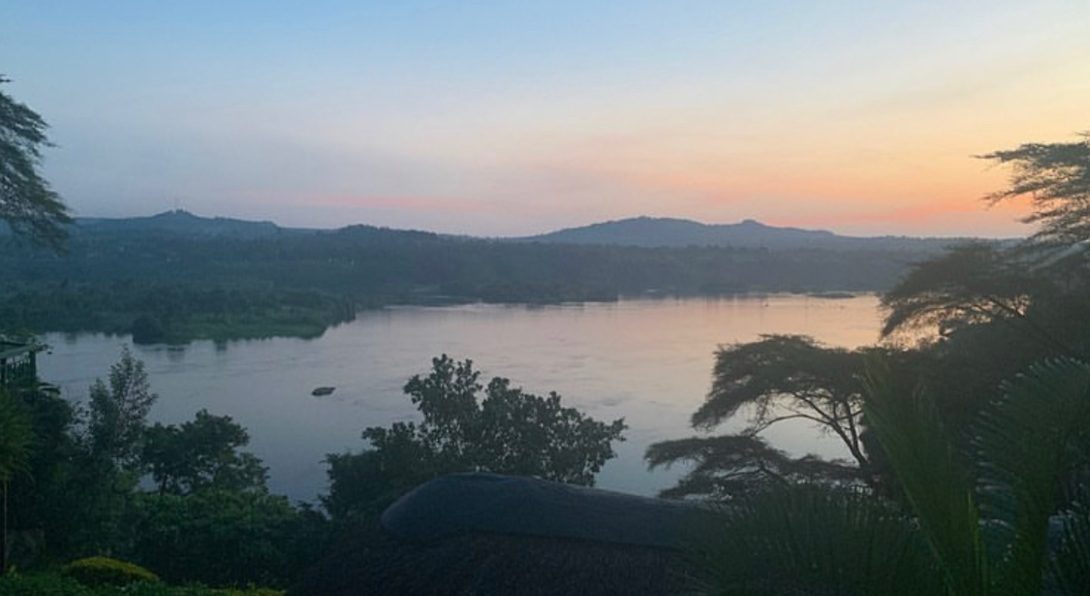
We were all a bit nervous to raft because it was going to be a Level 5 day of rafting…now I am not too experienced in White Water Rafting, but level 5 seemed like it was going to be crazy. Apparently, level 5 is like medium-high in rafting terms, 6 is the highest you can go. All of the rapids we went down throughout the day were level 4 or level 5 rapids. We left the camp around 8:30 and headed to the ‘base camp’; we got on a bus and headed about 30 minutes away to the start of the rafting.
karissa's blog post
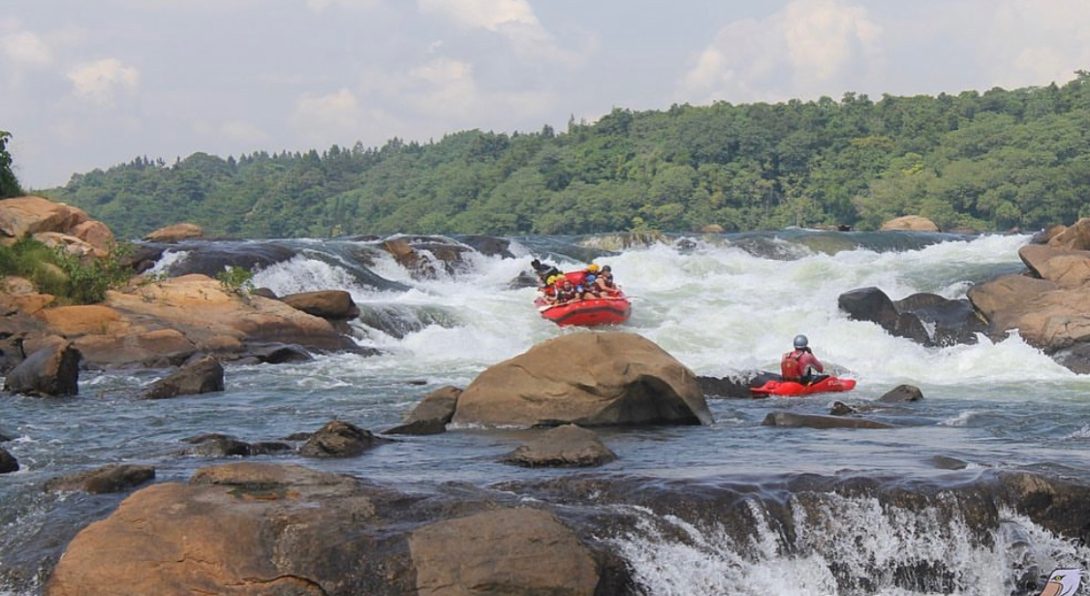
Our group got paired up with two other people, Carson and Diksha who were doing research in Kampala, Uganda. We all put on our life vests, and helmets and headed into our raft. Our guide’s name was Peter and he was full of jokes, mostly revolving around us dying on the river or having to swim all the way home when we fell out of our raft, but it was all fun and games. We went through training, which honestly made me more nervous. We practiced flipping the raft and what to do if you fall out, getting trapped under the raft, how to hold on to the boat and paddle when going down the rapid and all the other fun things you never think about when booking a trip like this.
karissa's blog post
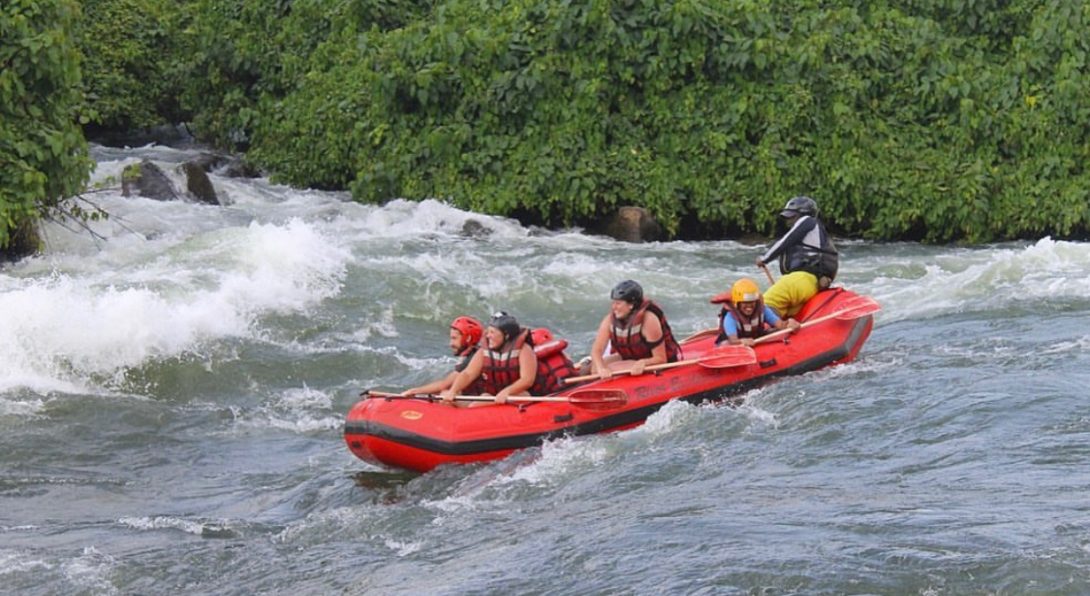
We were finally ready(?) and we got to watch all the other groups go down the first rapid, a level 5 to start the day off. Right before we were going to go down, Peter had Erica and I switch sides, this made me even more nervous because I had just gotten semi-comfortable with my side of the raft and now we were switching right before, without practicing how to get down and hold onto the rope. The rapid was coming whether I liked it or not, and it was a great way to get aquatinted with the Nile river, just loads and loads of water crashing into you, into your face, your nose, down your throat, in your eyes. Somehow, we made it out alive without flipping over. It was so fun! There was not much time to recover because there was another rapid up ahead. It was the same, level 5 with all the water in my mouth and nose. After that second rapid, we were just floating for about 45 minutes to an hour. We got to know everyone in our boat and laugh about how we didn’t flip, and other rafts did. There was one more rapid before lunch, every other boat flipped over besides ours, it was actually amazing that we stayed right side up!
Later in the day we were approaching this island with what seemed like thousands of birds circling it. It was an eerie sight. As we got closer to the island, we saw that they were in fact not birds but bats! I have never seen so many bats in my entire life, they were just flying around, some hanging in the trees and some trying to find food. It was a sight! We pulled off to the other side where we learned we were going to go body surfing/ boogie boarding on some rapids that looked like waves. My group was the one to go first and it was a lot harder than it looked, we all had on flippers along with our boogie board. When it was my turn I kicked as hard as I could, but I didn’t stay in the rapid for too long, or maybe not even at all it was hard to tell. It was still really fun, we waited on top of a rock while all the other groups went, then we got back in the boat and headed for a floating island/metal thing for lunch. We all ate sandwiches and drank water while relaxing in the shade. At this point of the day, all of my sunscreen had washed away in the rapids, so I had already lost to the sun.
karissa's blog post

After lunch we got back on the boat and we were told that there were two more rapids. The first rapid after lunch was a level 6 rapid that you could not raft down. Once we approached the rapid, we had to walk around it for about 5 minutes. The second half of this rapid is a level 5 so we could safely raft down it. We were the first group to go down the rapid and Peter said we can do the crazy version or the not crazy, lame version which do you want to do? Our group was split half and half but ultimately peer pressure prevailed, and we opted for the crazy version. This meant we had to hard paddle to the middle of the rapid and go down the center where there were huge waves. This other guide right before we left said “you are definitely going to flip”. Somehow, we got through the rapid without flipping, we all cheered when we made it out of it and touched our paddles together. We watched all the other groups go down and they all took the non-crazy way. We were pretty proud of our selves.
karissa's blog post
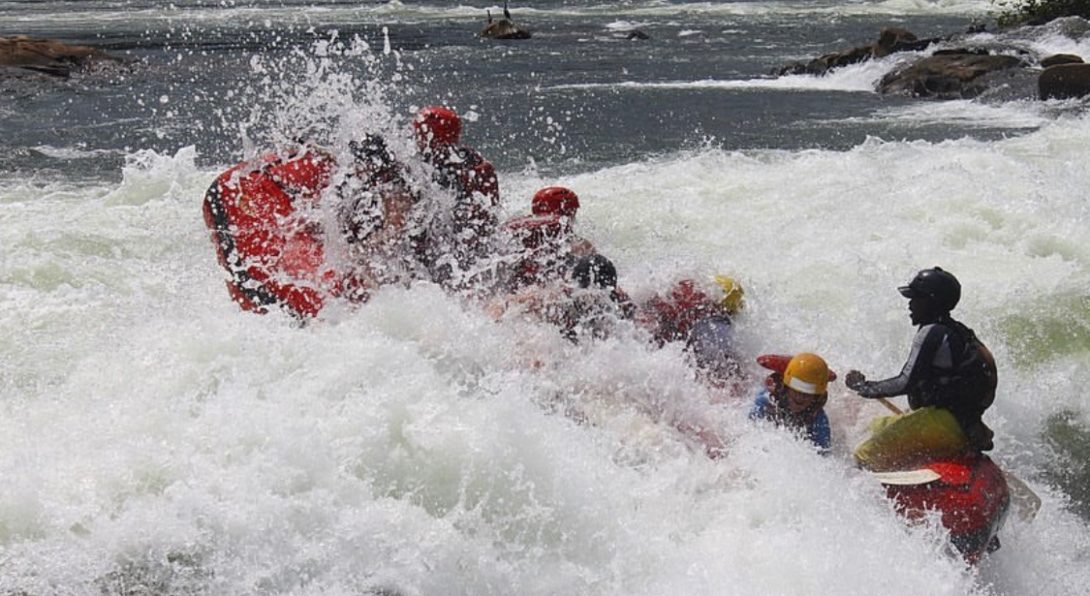
After that rapid there was another wave-like rapid where we had body surfed previously, this time we were going to surf with our raft. I think this was a ploy by Peter just to get us to flip over. I thought we were going to flip the first time but somehow, we all managed to stay in right side up. Peter was like let’s try one more time, and we prevailed again, #TeamNoFlip. The next rapid was not for a little while so we got to take off our helmets and unbuckle our life vests again. We even got to jump in and swim for a while from time to time. The water was pretty warm, and it was so refreshing. The last rapid was filled with whirlpools, Peter joked that if you fell in you might not come back up for 2 hours. We were determined to stay in the boat, and what do you know, we did. The only team to not flip all day. We were ecstatic. #TeamNoFlip
We were done with all of the major rapids, however there was a level 1 rapid that Peter said we could swim down, we all jumped out of the raft and swam down it, it was so relaxing. I forgot to mention earlier, but getting back into these rafts after jumping out was quite the feat, it was nearly impossible to get back in yourself unless you were like super super strong. Turns out, I am not super strong so we all had to get pulled back in by our life vests. Not my most graceful of moments. We paddled down the river the rest of the way to the end where we got out of the boat, walked up the hill and all celebrated. It was about an hour and a half back to the camp so we all just chatted amongst ourselves and relaxed. When we got back to the camp, we all headed to the little restaurant where we played cards, watched the sunset, ate and drank for hours.
The next morning, we got up, showered, ate breakfast and drank coffee with an incredible view and got picked up to go to town around 10am. Our taxi driver found us a Matatu back to the border and we left Jinja around 10:40am. We got to the border and went through immigration; they checked our Yellow Fever vaccine cards and our temperature upon arrival. Erica and I were disappointed because it turns out our Kenyan visas were for only 1 month instead of 3, so when we got back to Kenya, we had to pay $50 again. At least the trip was worth it. We found a Trans-County Matatu to ride back to Maseno/Kisusmu in and waited about 30-40 minutes before we left. We got to Maseno around 4:00pm just before the rain hit. I was really tired, so I went to bed early after only reading a few chapters of the new book I started. We only have 3 weekends left before we leave, this was by far one of my favorites!
Karissa's blog
This week was a very important week in our field experience because it was training week. We started the training on Wednesday, the 10th. There were 16 undergraduate and graduate public health students from Maseno University, Erica and I, Dr. Bailey and Louisa. On Wednesday we went through the Household questionnaire, question by question and the consent forms. There were many questions from the students, clarifying and making suggestions. We ended the day with learning how to do anthropometry measures. It was a very long day, but it seemed productive.
On Thursday we tackled the Women’s questionnaire which took quite a long time because we also had to add translations in it while we went through each question. We continued with the anthropometry measures and did some trial runs of the questionnaires between students. While the students were practicing the questionnaires Erica and I finished the Access database we have been working on in order to analyze the data we get from the questionnaires. It was really tedious to put everything into the Form function, but we felt accomplished when we finished.
Friday, myself, Erica and the student-team leader, Mercy were left to run the training on our own because Dr. Bailey and Louisa could not be there. We spent most of the day going through questionnaires again, fixing little mistakes people pointed out before the final copies were sent to print. Pauline was able to stop by for a few minutes to talk to the group, which was amazing, because morale began to waver towards the end of the training. She explained that we are Public Health aspiring professionals and field work is a necessary and amazing part of the job. It was really inspiring. We paired all of the students up and made 7 teams consisting of one male and one female per group. This is so the woman of each team could administer the woman’s questionnaire so the respondent would feel more comfortable talking about certain subjects such as sexual health and reproductive history. Monday would be our final day of training, the community entry, a pivotal part of this project.
Things run a little last minute here which can be stressful, but we made it through the training, and were confident in the teams to collect quality data. We have 7 teams with two students as team leaders that will float between groups to make sure everything goes smoothly and to fill in for missing persons.
Karissa's blog
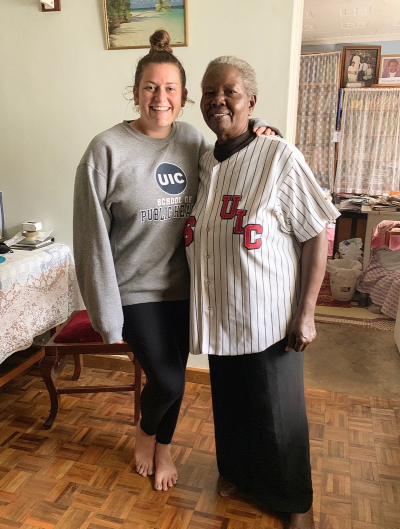
On Saturday morning, when I walked into the living room, I was pleasantly surprised to see Asenath, my host grandma, wearing the UIC Jersey I gave her. It made me so excited, she looked so good in it! We took a picture to document the moment. The rest of the day was just spent relaxing. On Sunday, Erica and I walked to the Equator. It is very close to where Erica stays and only about a 20-minute walk from where I stay. We stayed there for about an hour or so, had a few cold drinks then walked back to my homestay and watched a movie. It was a nice relaxing weekend, perfect because we would start fieldwork on Monday!
Karissa's blog
This week was a very exciting and important week, it is what we have been working towards this whole summer! This was the start of our actual fieldwork portion of the project. On Monday, we went to the Chief’s meeting in Marera to get our community entry permission. This consisted of community elders, and the Chief of the sub locations of Marera and Sunga, the areas where we are surveying. Although most of the meeting was carried out in the local languages of Luo and Swahili, they translated some of it. It was such an interesting process to me, they asked about our project and Louisa and Dr. Bailey had the opportunity to explain why we were there, why this project is important and what exactly we would be doing within the community. The meeting lasted about an hour and they ultimately gave us their permission to enter the community. We took the remainder of the day to perform a pilot of the surveys in the grids that were not selected for the study so the students could practice. The Public Health Officer (PHO) for Sunga and Marera led us into the community and into houses. Each team was able to practice a household and a women’s questionnaire. This was really good practice because we were able to see if there were any mistakes or hiccups with the questionnaire. We fixed a few of the questions to be ready for the real thing on Tuesday.
Karissa's blog
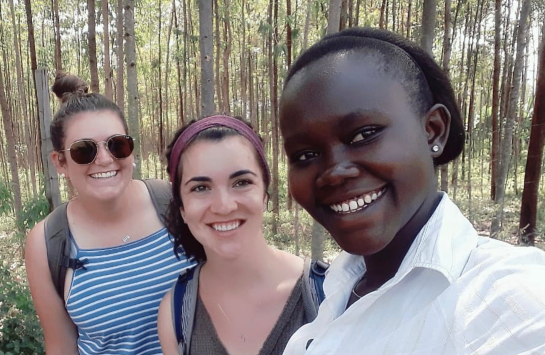
Tuesday morning Erica and I got to our team meet spot at 8:30am, we had to wait for the questionnaires to arrive from Kisumu because they were still being printed in the morning. This was a bit frustrating and we did not actually start until 11:30, but that is the name of the game sometimes. I went out with one team and we walked with our community elder (the PHO set each team up with either an Elder or a community health volunteer (CHV)) to our grid. When we got to our grid, using a mixture of Google Maps and the map with the grid on it that we created, we were told by another groups CHV that we were no longer in Marera and we were actually in Newa. This was a problem because we only wanted to survey Marera and we did not have the Newa Chief’s permission to survey in Newa. We walked until we thought we were in Marera and in our grid and started our first survey. One team member did the household while the other did the women’s questionnaire, I observed and made sure no questions were skipped, as well as answered questions from my team. We were able to complete another women’s questionnaire at that house because the Head of the Household had two wives. We also did anthropometry measurements for two children under 5. It was not until after we finished that Erica called me and said that her groups CHV said we were still in Newa. We finally figured out the boundaries for Marera and headed into another groups grid and completed one survey in Marera before the day was over. It was a frustrating day overall and was going to be a long night because Erica and I had to redistribute all the grids and fix the map of Marera. That night we also went through each questionnaire to see if there were mistakes. There turned out to be quite a bit of mistakes, so we marked all of them so we could go through them with each person in the morning.
Wednesday morning came early and Erica and I matatu’ed to the meeting point. Erica and I arrived at 8:30 am and started going over each missed question with the surveyors. We got started around 9:45, I went with the same group as the day before to make sure we were in the right grid. We were able to survey almost 10 households and at the end of the day felt very accomplished. My role in all of this is basically to look at the surveys after they are completed to check for mistakes or missed questions and to help during if the surveyor has any questions. I also help to find the households to survey and make sure they are within the correct grid. It is really nice getting to meet people and talk to them. Every single person we asked let us complete the questionnaires, and they are not short. When we got home Erica and I had taken half of all of the surveys and we looked through them again marking mistakes to tell people in the morning. These days are proving to be very long.
Thursday, our third day, Erica and I went with the same group because we had to fix some problems with the grids. Some groups accidentally did the same grid the day before causing a problem. We shortly figured out that one group thought they were in one grid, but they were actually not there. We got the problem squared away and continued surveying the correct grid. The grids are only 200×200 meters, so they are not big, and easy to mess up. Erica and I split the surveys again, we have a lot of data to input next week. Hopefully it all goes well. We will start Sunga next week as the students will complete Marera by Monday.
On Friday morning around 5:45, Erica and I left our home stays to meet at the Matatu pick up place. The sun does not come up until about 6:30am so Alex, one of the housekeepers very kindly walked me to meet Erica. Erica and I jumped on a Matatu to head to Kisumu to meet Katie and Stephanie. We would begin our journey to the Masai Mara at 7! We have been looking forward to going to Masai Mara this whole time we have been here.
Karissa's blog
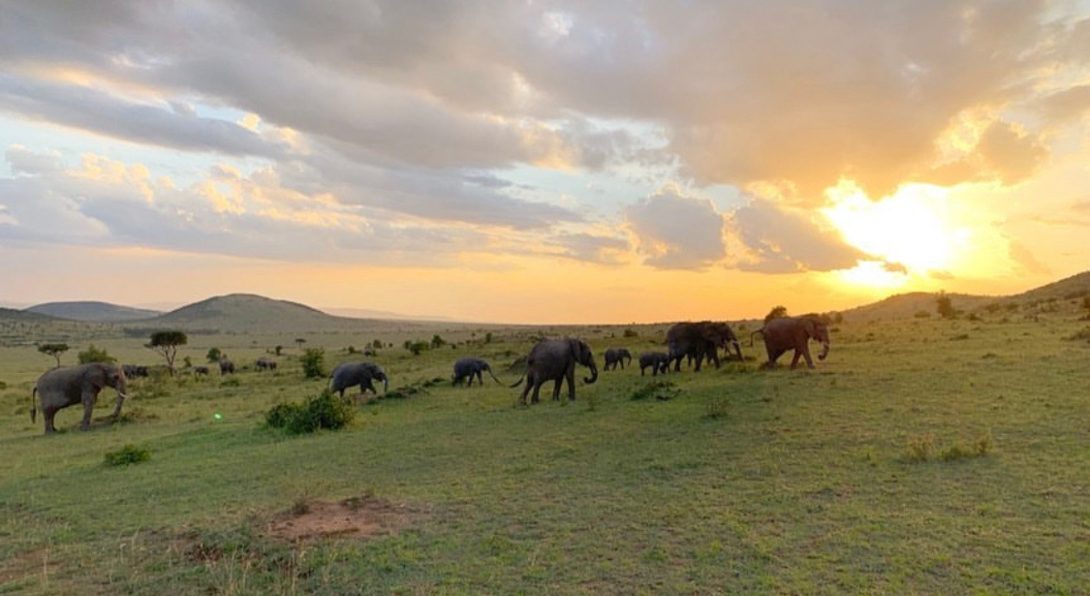
We met our driver; Jimmy got an iced coffee from Java house for the road and left around 7:30ish. We stopped at a grocery store to pick up some snacks and drinks for the weekend and stopped for lunch a few hours later. After lunch, the paved road stopped, and the dirt road began. It was a very bumpy ride for the last 2 hours to our camp. We arrived at our campsite, Rhino Camp, around 4:00 pm. It was a really nice camp; Erica and I shared a tent again. They were very spacious, and each tent was attached to a private shower, sink and toilet in the back of it. We set our things down, freshened up and left for our first game drive of the weekend. We left at about 4:45 and you have to leave the park by 6:30 or so.
We got into the park and the first animal we saw was a Masai Giraffe. This Giraffe had really unique spots on them, different than the ones we saw in Nakuru. We saw a few more giraffes down the road, but then we saw two cheetahs resting. These were the first big cats we had seen since being in Kenya and we were beyond excited. We watched them walk around, groom each other and just relax. The sun was starting to set as we approached a group of elephants. It was so beautiful, I teared up a bit at the sight. We saw a ton of zebras and antelope throughout the short drive as well. On our way out of the park, we saw a sleeping lion. Jimmy said this was just a taste of what we would see on our full game drive tomorrow. We headed back to camp, ate dinner, talked a while and headed to bed.
Karissa's blog
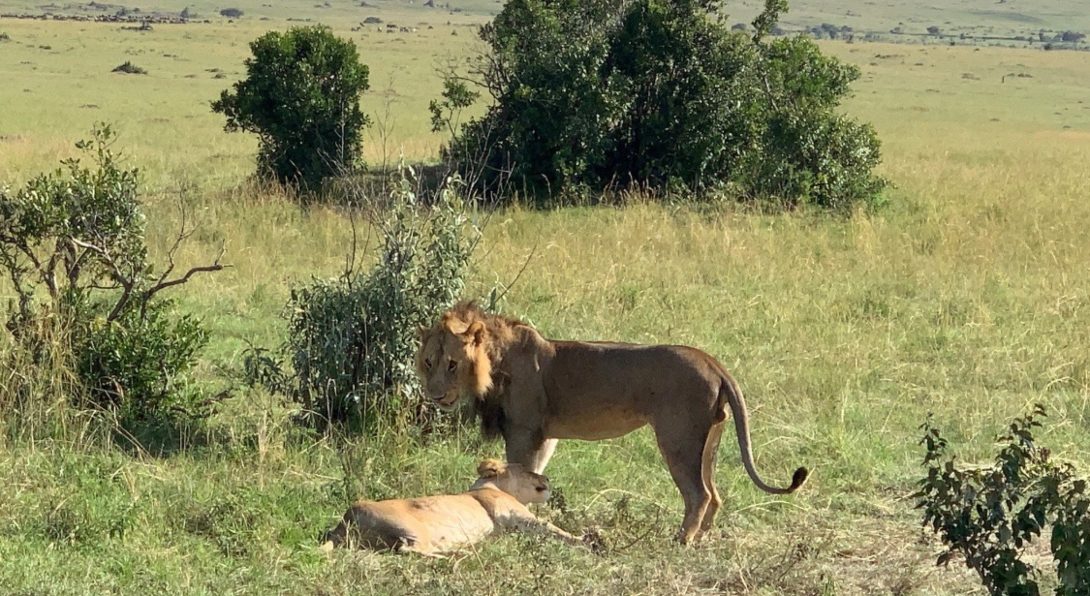
Saturday, we left the camp right after breakfast, around 6:20. The park opens at 6:30 and you tend to see the best things around dawn, because this is when the big cats tend to hunt. About an hour into the morning we saw a mother lion and her cubs. It was amazing, they are just such relaxed animals and not afraid of anything. I forgot to mention earlier, but we picked this weekend to go to Masai Mara because it was around the start of the Great Migration, where hundreds of thousands of wildebeests migrate from the Serengeti in Tanzania to Masai Mara. There were so many wildebeests walking around in large groups, paired with a few zebras. Apparently, wildebeests keep zebras around because they have good vision. It was truly a sight to see all of the wildebeests throughout the park. About an hour or so later we saw another group of lions, this time a boy and a girl lion. I was amazed we were seeing so many big cats!
Karissa's blog
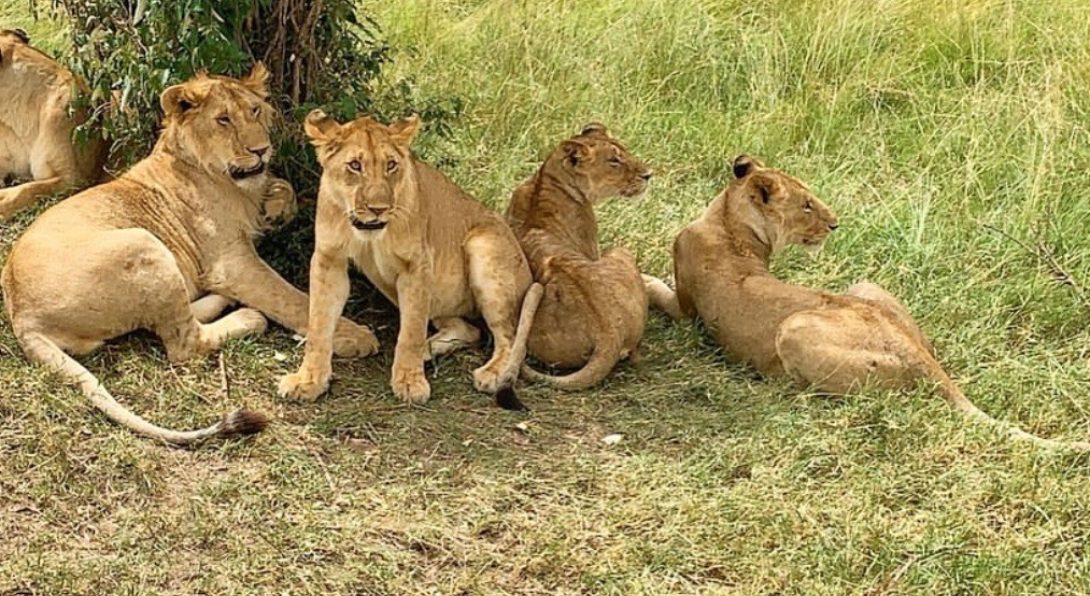
Jimmy rushed off very quickly from the two lions, we quickly saw why. There were five cheetahs trying to hunt a large pack of wildebeests and zebras! Unfortunately, it seemed like all of the cars in the park where also alerted of this, so it was crowded. We saw the after math of the hunt and got to see the cheetahs eat the wildebeests through binoculars. The next thing we were able to see was a leopard. Apparently, leopards are very hard to spot because they spend most of their time in trees. They are solitary animals and spend most of their time resting. We learned the differences between cheetahs and leopards from Jimmy, before this I thought the two were interchangeable. Cheetahs are faster than leopards, they hunt during the day time and do not hang around in trees like leopards do!
Throughout the day we saw my favorite, the water buffalo and thousands more wildebeests. One of the best parts of the day came shortly after we saw the first leopard. Jimmy, our driver spotted a different leopard in a tree we drove by. We were the only car there at first which was so cool! We were so close and even got to watch it walk around on the tree. After the leopard we drove around for twenty minutes or so until we came up on five lions sitting under a tree! It was a mom and her cubs; we were SO close to them it was amazing. It was a once in a lifetime experience to be that close to so many lions.
Karissa's blog

After the lion sighting, we ate lunch under a shady tree. We headed to the Masai river next where we were able to witness the wildebeests crossing! Thousands sprinted in single file fashion into the river and out to the other side. Jimmy said this was really rare to see. We were having a very lucky day. Not to my enjoyment, we saw a few crocodiles in the river, I have a fear of crocodiles for some reason and even though we were far away I was still a little scared. We saw hippos in the water as well. Jimmy told us crocodiles wait for the wildebeests to cross the river and prey on ones that are weak or drown.
The next animal sighting was my absolute favorite, and this is because I was the one who spotted them first! We were driving through some hilly, tall, grassy areas, perfect for lions to sleep in, when we turned a corner and I spotted two lions sleeping behind a bush. I was so excited; we were the only ones around and were again so close to two beautiful lions. It was a girl and a boy lion. The girl lion got up and walked into the sun where she proceeded to lie down and sunbathe, the boy lion got up and followed her and cuddled up next to her. It was so cute. It was getting close to sunset, so Jimmy found us a great spot to park and watch it. It was so beautiful and bright. We headed out of the park feeling amazing after the perfect day we had. We ate dinner, talked for a bit, looked at the stars then headed to bed.
Karissa's blog
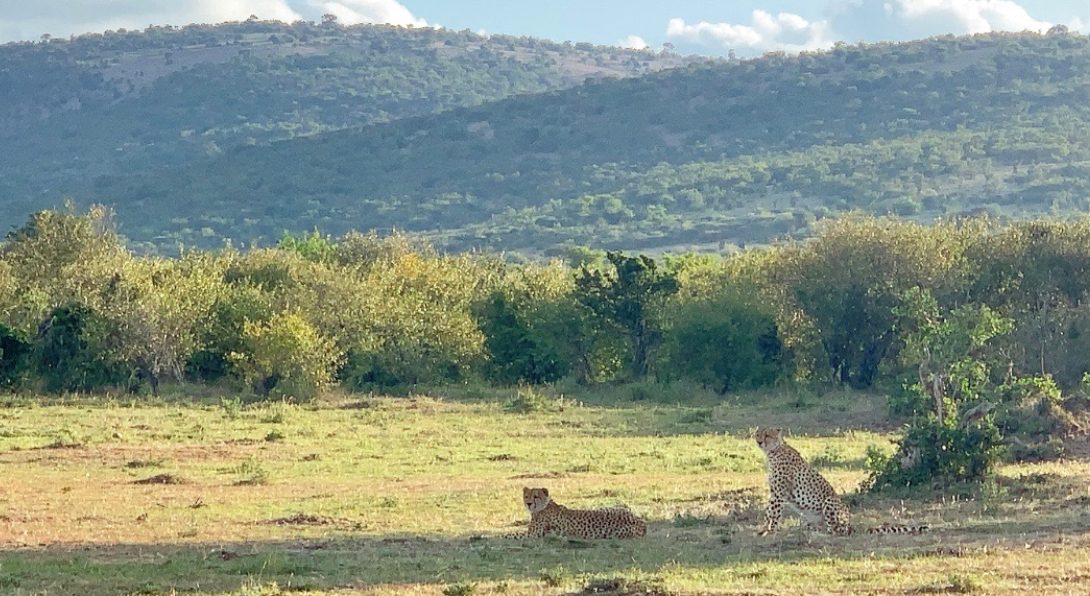
Sunday morning, we woke up early again and headed to the park around 6:15, we would go on a short drive before heading back to Kisumu. We watched the beautiful sunrise from inside the park and almost got to see a lion hunt some wildebeests. It ended up running into the brush, so we did not get to see it hunt. It was really cool to see the wildebeests plan how they were going to defend themselves. It seems they have leaders who stand up to the predators. It was crazy to watch. We saw thousands more wildebeests before we saw three lions just laying down around some of them. There was a mom and two cubs, the two cubs were playing with each other while the mom was resting, the wildebeests and zebras were on red alert watching them making sure they were not about to attack. We watched them for a while before it was time to head out of the park. We saw a few more elephants on our way out, I was sad to leave, but so grateful for the experience I had this weekend. It was one of the best weekends ever, filled with memories and pictures that will last a lifetime.
We stopped back at the camp to grab our things before heading out. About an hour into our drive, we were stopped along with 15 other cars because a truck was stuck in the road and no one was able to pass. We waited for about an hour before we went back the way we came and found another route out. About 7 hours later right when we were arriving back in Kisumu, we got a flat tired which delayed us another 30 minutes. We finally got to our drop off point around 6 pm. It was a very long day, but it was not over yet, Erica and I still had to take a Matatu back to Maseno. We did not end up getting back to Maseno until 7:15. We were exhausted, but the weekend was well worth it!!
Karissa's blog
Erica spent the night on Sunday because Asenath, my host grandma, invited us to her University for a tour on Monday. She wanted us to meet some of her students, see where she spent most of her time working, and tour the campus. Her driver picked us up at around 7:30ish in the morning. Just recently, Asenath was named the acting Vice Chancellor of Masinde Muliro University of Science and Technology (MMUST). This is a HUGE deal; this means she is in charge of the University and is basically a superhero. She works so hard, and I could not be more proud.
Karissa's blog
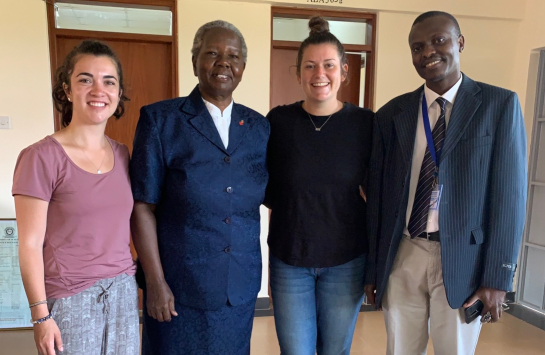
We arrived in Kakamega and met the head of the Public Health Nutrition department, and we chatted for a bit before he walked us up to ‘Prof’s’ office, which is what everyone calls Asenath. She has a huge office with a beautiful view of the forest and campus. We only stayed for a few minutes because she was very busy. We of course took a picture to commemorate the day and we were off to meet two of Asenath’s master’s in public health nutrition students, Enid and Rhoda. They were as nice as could be and gave us a tour of the campus. We visited the library and the optometry department before we headed to see Asenath’s project that she has been working on for many years, a mushroom and spirulina research project. We met the interns who were working on the project and they showed us how they made porridge flour out of mushrooms, sweet potatoes and millet. They showed us where they grow the mushrooms and also where they grow the spirulina. They produce spirulina capsules along with the flour that they sell to the university and the surrounding community. It was really neat to see the innerworkings of the project that has been so near and dear to Asenath’s heart. Our next stop was the School of Music where the students sung the song, “This Little Light of Mine”; they were amazing! We headed to the new school gym then headed back to campus for lunch. We sat around and talked for a while before Erica and I headed back to Maseno.
Karissa's blog
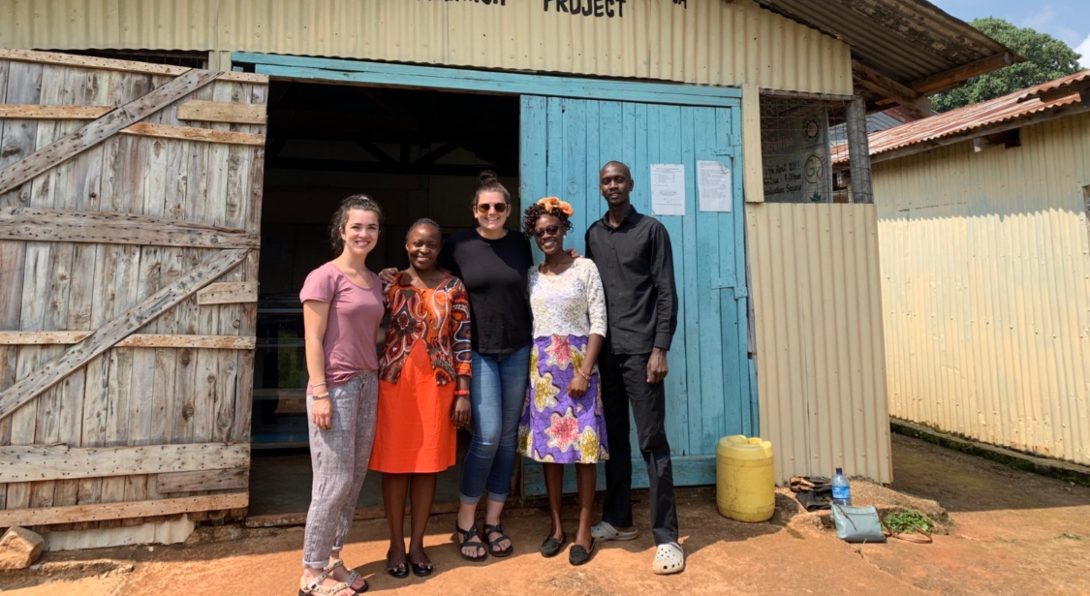
On Tuesday, Erica and I went to the field to pick up the surveys that had been completed from Friday and Monday. Dr. Bailey then drove us back to Maseno so we could start inputting all of the data into our database. Most of Monday was spent fixing problems within the database, we were only able to input about 10 questionnaires. Tuesday went better and by Friday we had entered a little over half of the surveys we had in our possession (with a little help from Spotify’s 2000’s-2010’s playlists). In between entering questionnaires, Erica and I decided we wanted to make a cake for a little party Asenath was having on Saturday. Erica got an amazing chocolate cake recipe from her host-sister. We went to the grocery store in the morning to get a few ingredients we did not have. We made the batter and filled the pan, it looked like we made a little more than would fit in the pan, so we made a trial cake first. The oven at my homestay is a gas oven and the two temperatures are basically hot and hotter, so it was good we did a tester. It turned out pretty good, a little crisp around the edges but it still tasted good. We put the real cake in the oven and checked it every 10-15 minutes. By the third time we checked it, it had smelled burnt and we knew we were in trouble. The cake had spilled over the sides of the pan and was burning on the bottom of the oven. We were so upset but made a quick fix and hoped for the best. The cake was done so we took it out to let it cool. It didn’t look pretty so we decided to make some frosting and fix the situation by making cake balls instead. That was our best idea because they turned out great, and spoiler alert they were a big hit at the party!
Karissa's blog
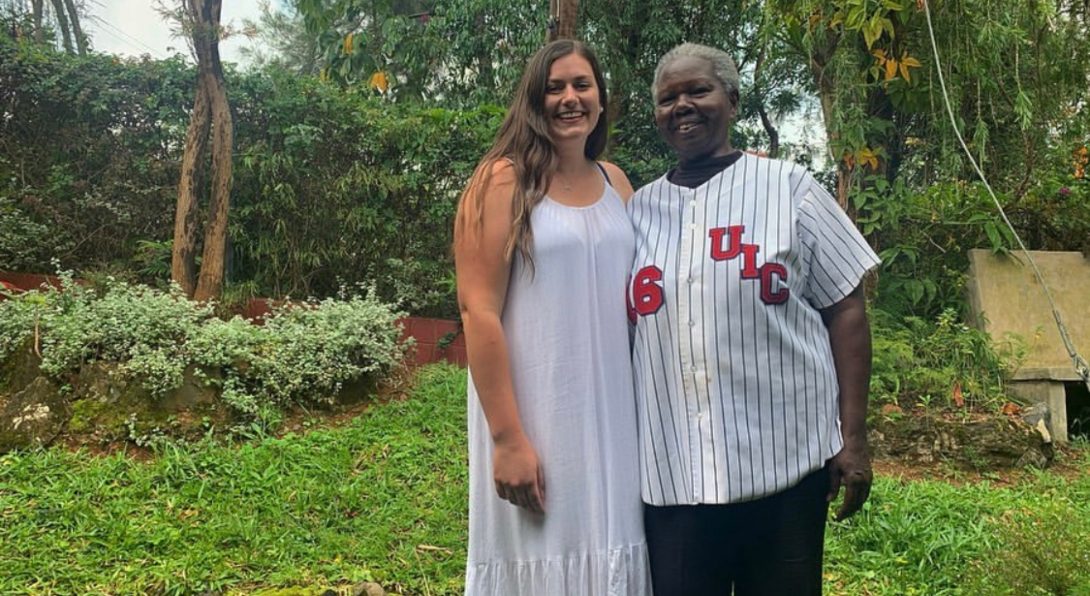
The party started around 11:30 on Saturday. Asenath wanted to meet all of the students who had been working with us for our project and the other students form UIC. It was such a fun day, most of the students were able to come and we ate, talked and laughed for hours. Rhoda, one of the students who showed us around at MMUST was even able to make the trek down! It was such a fun day, a perfect start to our last week of work. A lot more questionnaires were brought to Erica and I on Saturday, so we have our work cut out for us this week. We are training a few MPH students on Monday on the database, so hopefully the data entry process will speed up a little! The time sure has gone quick, can’t believe this is our last week!!
Karissa's blog
I can’t believe that my time here in Kenya is almost over, these 9 weeks have gone by incredibly fast. I have had so many amazing experiences and met the most wonderful people. Everyone who I was able to meet, work with and live with have been truly amazing – I am so lucky.
This week started off with more data entry for Erica and me. On Monday we trained a few MPH students from Maseno on how to enter the data into the Access database we created. We had long days in the office and even brought home some questionnaires to input at night. We wanted to finish by Friday, so Pauline and Louisa could focus on the second half of the data collection without worrying about inputting data from the first half. On Tuesday, it was more of the same, the pile of questionnaires still seemed daunting but, we were confident we could finish on time.
Karissa's blog
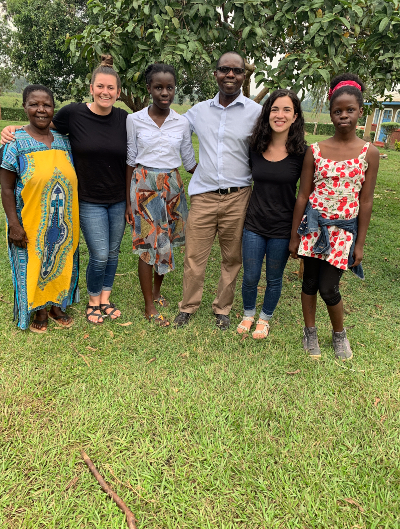
On Wednesday we had a nice treat because Patrick, Erica’s host dad took us to his village to see where he grew up and to meet his mom. We worked until around 11:30 then Patrick picked us up and we drove to his village about an hour and a half drive away from Maseno. On the way Patrick asked me if I had had sugar cane yet and I hadn’t so he pulled over on the side of the road, bought some sugar cane, chopped it up and put in the back of the car for us to eat later. When we arrived at his village, Patrick’s mom had made us a delicious lunch. Her home was quite beautiful. We got a tour of his village and got to see where he went to school as a boy. Two of his daughters also came with us so it was nice to get to know them a little better too. He chopped up the sugar cane and we got to snack on that before we left a few hours later.
Karissa's blog

Thursday was more data entry and by the end of the day we only had a few hours of work left that we would be able to finish by mid-day on Friday. We had our final wrap up meeting with Pauline, Louisa and Dr. Bailey. They were really pleased with the work we had done over the past two months. We are excited to look at the data once we get back to Chicago and see what it shows us about the community. Pauline and Louisa told us that they wanted to take us out to lunch on Friday before we left, we were really excited about that.
Karissa's blog
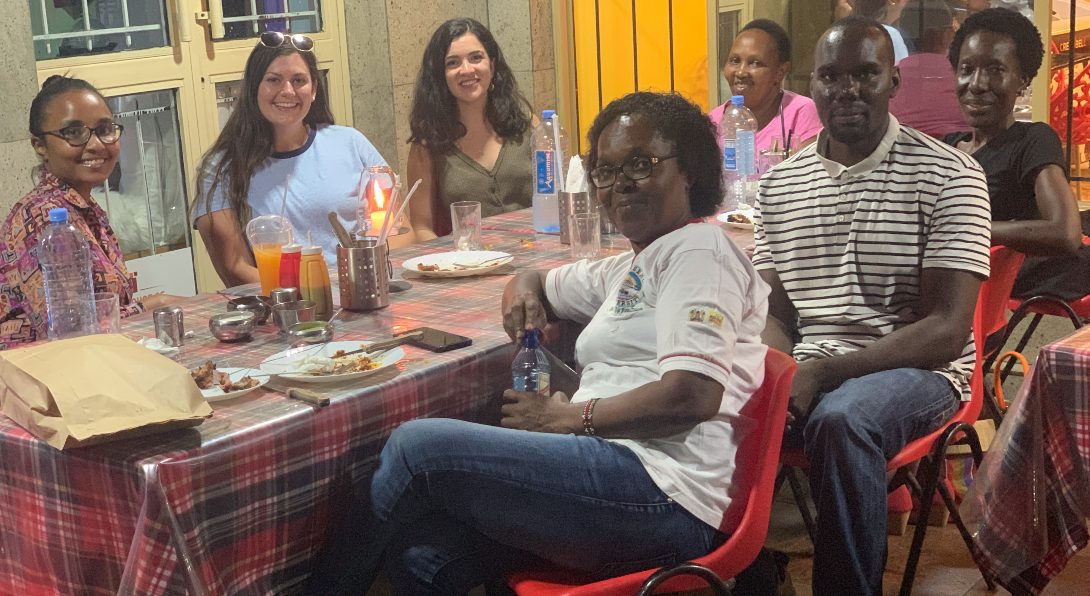
Friday came, our last day of work and Erica and I finished inputting the questionnaires by 1:00. Pauline came into the office and said we would leave for a late lunch early dinner at around 3:00. This was perfect because Erica and I were able to tie up some of the loose ends for the work we did over the past 2 months. We put all of the work we did into a shared folder with Pauline, Louisa and Dr. Bailey and helped set up the second part of the data collection process. We packed up and headed to Kisumu for lunch! We ate at this really delicious Indian restaurant, there was so much food, Erica and I even enjoyed a Milkshake. We were there for a few hours with Pauline, Olympia, Louisa, Louisa’s daughter and Chi-Chi, Asenath’s son. We talked and laughed and exchanged goodbyes. Pauline’s driver drove us back to Maseno in the evening, we dropped Erica off first and I said goodbye to her wonderful host family and to Erica. This has truly been such a fun and educational summer. I am so proud of the work Erica and I did over the past 2 months, I cannot believe we finished the Community Health Assessment while we were here, we did not even expect to be here when the data collection happened but it all came together in the end. I am so happy I got to work with Maseno University, their students and staff, Dr. Bailey and especially Erica. Erica and I did not know each other before we came to Maseno, but over the last 9 weeks we have spent almost every waking moment together and have gotten to become very close. I am so thankful that we got to experience this summer together. I am writing this blog on my very last day in Kenya, I am heading to the airport in just a few hours. I am very sad to leave my host family as they have been so incredibly welcoming and kind. I would not have been able to have this incredible experience if it was not for Asenath, Doris and Alex… so a big thank you to them! Thank you for following along on this journey, it has been incredible! Tutaonana baadaye, Kenya!
Erica Petersen Bio
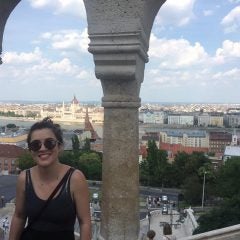
Erica Petersen is a second year MPH student in Community Health Sciences with a concentration in Community Health Interventions and enrolled in the Global Health Program. This summer, she will be living in Maseno, Kenya which is just outside the city of Kisumu. Erica will be working with Maseno University in their efforts to complete a community health assessment for the surrounding community for her applied practice experience. She is very excited to gain hands-on public health experience in the global health arena in addition to learning about Kenyan culture and experiencing all the country has to offer!
Erica Petersen's blog
Erica's blog post
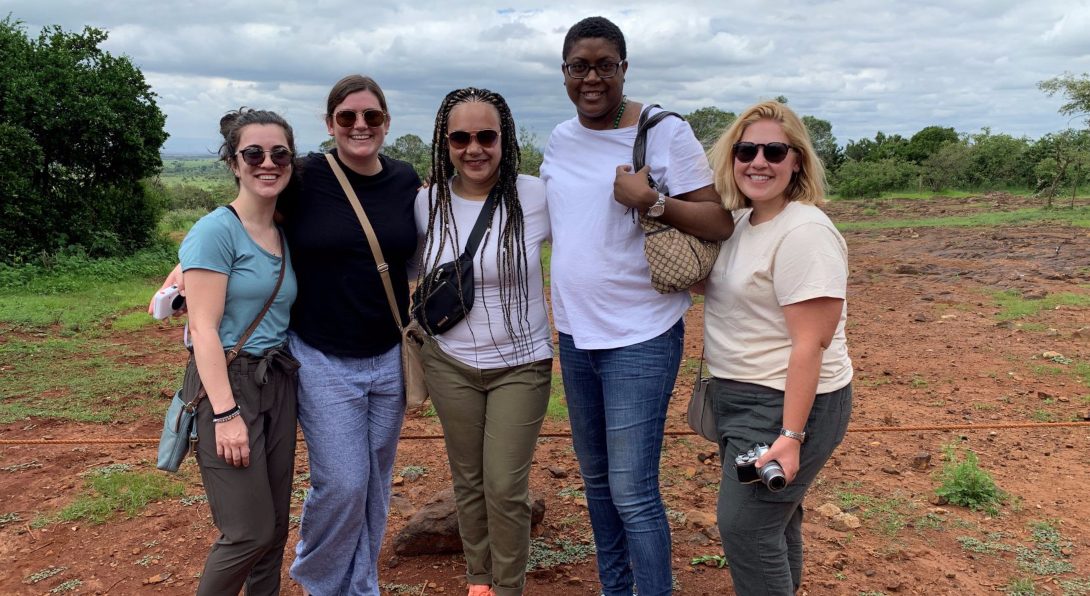
After a very long journey, we arrived in Kenya last Wednesday. I met Karissa at O’hare and the two of us flew from O’hare to Philadelphia to Frankfurt, and finally landed in Nairobi around 8pm local time (a 24 hour journey in total). Dr. Bailey’s friend, Chief, picked us up from the airport and took us to his home in Nairobi, where the rest of the crew was already waiting. Chief’s cook had a big dinner prepared for us even though it was past 10pm by the time we made it to his house.
Erica's blog post
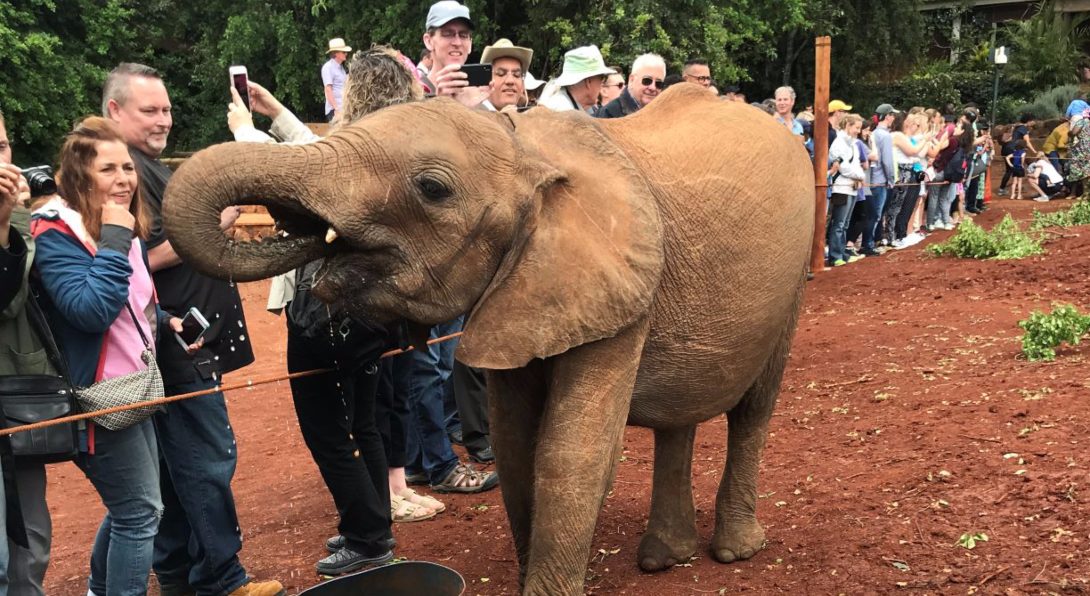
The next day, Chief took us around Nairobi to do a few errands as well as a few touristy things. We exchanged money and got Kenyan phones in order to communicate locally. Then, we went to the elephant orphanage in Nairobi National Park. It was adorable! The orphanage rescues elephants who lost their mothers, were separated from their herd, or were injured and needed rehabilitation. They stay in the orphanage until they are old enough to fend for themselves and then are released back into the wild. We were able to get up close and personal to the baby elephants and even got to pet them.
Erica's blog post
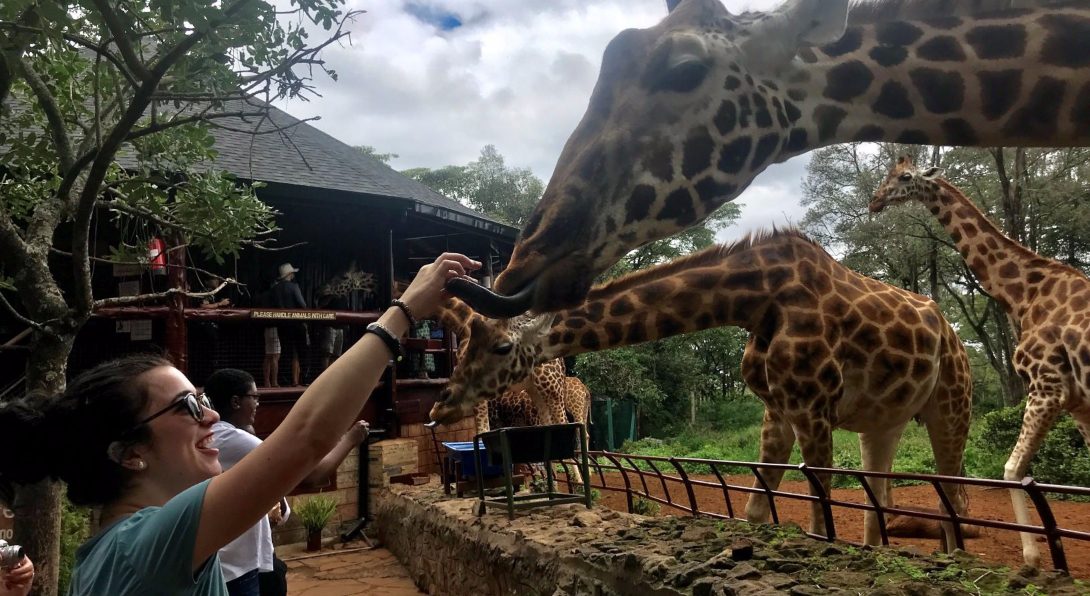
Following the elephant orphanage, we went to the giraffe center which was definitely something to check off my bucket list! Giraffes are my favorite animal, and I have seen videos of people feeding them at the giraffe center in Kenya, so I have always wanted to go. It did not disappoint! I was even able to do a “giraffe kiss” where you put a piece of giraffe food between your lips and they take it from you. We all tried it and couldn’t help but giggle uncontrollably afterwards. Later that night, Chief’s cook prepared a huge Kenyan feast for us complete with Ugali (African cornmeal porridge traditional to the Luo (local ethnic group on the western side of Kenya)), pork, fish, and greens. Chief’s friends joined and we all sat at a big table on his front lawn to enjoy food, drinks, and card games.
Erica's blog post

The following day we got up before the sun to make our way to Kisumu. It is around 215 miles, but took us almost 9 hours because of traffic and a reroute due to road closures. The drive was beautiful. It took us through the Rift Valley, past multiple lakes, and through the tea farming region. We dropped off the rest of the group at their home-stays in Kisumu, and then Dr. Bailey took Karissa and I to our home-stays in Maseno, about 15 miles north of Kisumu. My home-stay family is wonderful! Patrick is a professor at Maseno University and is the Associate Dean for the School of Graduate Studies. Grace just got her Masters in Environmental Science and teaches a class on the Kisumu campus of Maseno University in addition to homeschooling her two youngest daughters. They have three daughters that are 10, 13, and 15 years old. The 15 year old will be away at boarding school while I am here, aside from being home for one week next week. They are so nice and welcoming, and I am very excited to have them as my host family.
After a very long night’s rest, I spent the day getting to know my host family. I talked with Grace for a long while about the Kenyan school system and Patrick about American politics. He is very knowledgeable about world issues and American politics, so it was an interesting conversation. The youngest daughter, Micha, loves to play cards so she taught me her favorite card game and I taught her mine.
Monday was my first day of work, so Karissa’s host mom’s son walked us to the School of Public Health at Maseno University. The university is very quiet during the summer because there aren’t any students on campus. We started with a meeting with Dr. Bailey, Pauline and Louisa (both faculty at the School of Public Health). For our project this summer, we will be doing the preliminary work for a community health needs assessment for two sub-districts in Maseno. We will create a project plan, questionnaire, and methodology for a pilot survey of a sample of homes throughout the community of interest. If all goes well, we will work with students and community health volunteers to administer the survey, and then after we leave, the university will use our work to hopefully scale up the project and do a full survey of the communities of interest to be used for future public health interventions. After the meeting, Dr. Bailey took Karissa and I into Kisumu to get routers so we can have Wi-Fi at the School of Public Health. It recently moved locations, so the building it is in doesn’t have Wi-Fi yet. He then dropped us off at the “Matatu” stop to catch a ride back to Maseno. Matatus are small local buses that are known for being jam packed with as many people as possible, frequent stops, and crazy driving. There were tons and we had no idea which to take, so luckily Pauline gave us the contact for a public health student that worked nearby. She saved us by coming to meet us and taking us to the Matatus that are known for being nicer and less packed.
Today was Eid, so we had the day off work. Karissa’s home-stay is a big, beautiful, and empty house since her host mom works far away Monday-Thursday, so I met her there and we spent the day reading in her sun-room. This weekend we will staying with the rest of the group in Kisumu to explore the city and take a trip to Kakamega National Forest. I can’t wait for what the rest of the summer holds!
Erica's blog post

Today marks the beginning of our third week of work in Kenya. While there has been a steep learning curve here, I am starting to get the hang of navigating life in Maseno and building confidence making my way around. It surely will take me a while to get used to the amount of attention we draw being obvious foreigners in town, although most everyone just wants to say a friendly “Hello, how are you?”, give us a handshake, or tell us “Karibu” (welcome in Swahili).
Last Friday after work, Karissa and I made our way to Kisumu for a meeting with Dr. Bailey followed by dinner with the other students at a great lakeside restaurant, Dunga Hill. We enjoyed some cheap pizza, drinks, and live music. We also had our first experience on a boda boda (motorbike taxi) on the way to Dunga Hill (sorry mom!). Boda Bodas are everywhere here, but my host parents said that they just started appearing around 5 years ago. My host mom wasn’t thrilled that I rode one, and not-so-subtly suggested taking one of the many other forms of local transport instead.
Erica's blog post
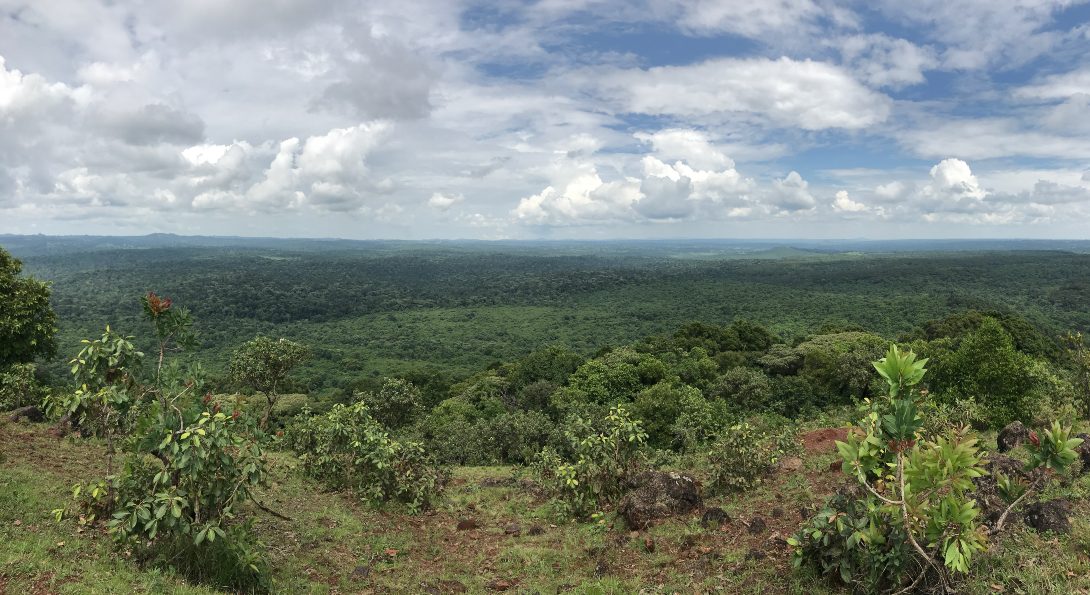
The next morning, Dr. Bailey picked us up early for an adventure-filled day at Kakamega National Forest. The 6 of us crammed into his truck for the hour long journey. In the morning, we did a muddy hike through the forest and up a steep hill to an absolutely beautiful vantage point.
Erica's blog post

The hike up was a bit precarious, but the view overlooking the forest and beyond was well worth it. At the top, I ran into a Kenyan guy who had a University of Wisconsin shirt on! I told him that’s where I went to school and he said his brother studied there and now works for the University. Small world! Following lunch, we did a second hike along a river that ran through the forest. It reminded me of hikes I have done through Wisconsin forests that have boardwalks, bridges, and steps built into the trail. Of course, the monkeys climbing around in the trees above us was a new touch. At one point, we lost the trail and found ourselves traipsing through thick brush and thorns. A few of us were a bit worried that we would get lost in the forest and not be able to find our way back out again, but we trusted Dr. Bailey’s confidence and sense of direction and he led us back out to the main road. On the way back from Kakamega, we stopped at the equator, which I discovered is about 30 seconds from my home stay! I hadn’t ventured that direction yet, but it turns out it is right around the corner!
Erica's blog post
The next day, Karissa and I spent the entire day putting together the questionnaire for the study we are helping to conduct. At our meeting with Dr. Bailey, we found out that we need to submit a proposal to the Maseno ethics review board within the week, so we had a lot of work to do to prepare. Late that night, just when we were finishing up our work, we discovered an unwelcome guest in Karissa’s room – a tiny mouse that scared us half to death when it darted by. We were up late into the night trying to lure it out of her room with various unsuccessful methods until it finally disappeared. We told ourselves that it probably left the room so we could go to bed, although we were both very unsettled by the fact that it just vanished. I’m sure the whole ordeal was a comical sight.
The entire second week of work was spent putting together the proposal to submit to the ethics review board. Karissa and I had to teach ourselves GIS in order to create maps for the communities we are going to survey, so that was quite the challenge! After many grueling hours and days of trial and error, reading online forums, and watching YouTube videos, our efforts were finally successful!
On Friday, we were able to accompany a Maseno public health student to a training for teachers at a local school. The Ministry of Health in Kenya is rolling out mass deworming medication to be administered to primary school children, so the training was to inform teachers in nearby schools about how to administer it. It was interesting to see public health in action here in Kenya. Although the training didn’t apply to us and we were only there to observe, we were welcome guests. Everyone went out of their way to come over and introduce themselves, shake our hands, and welcome us. Kenyans are so friendly!
Erica's blog post
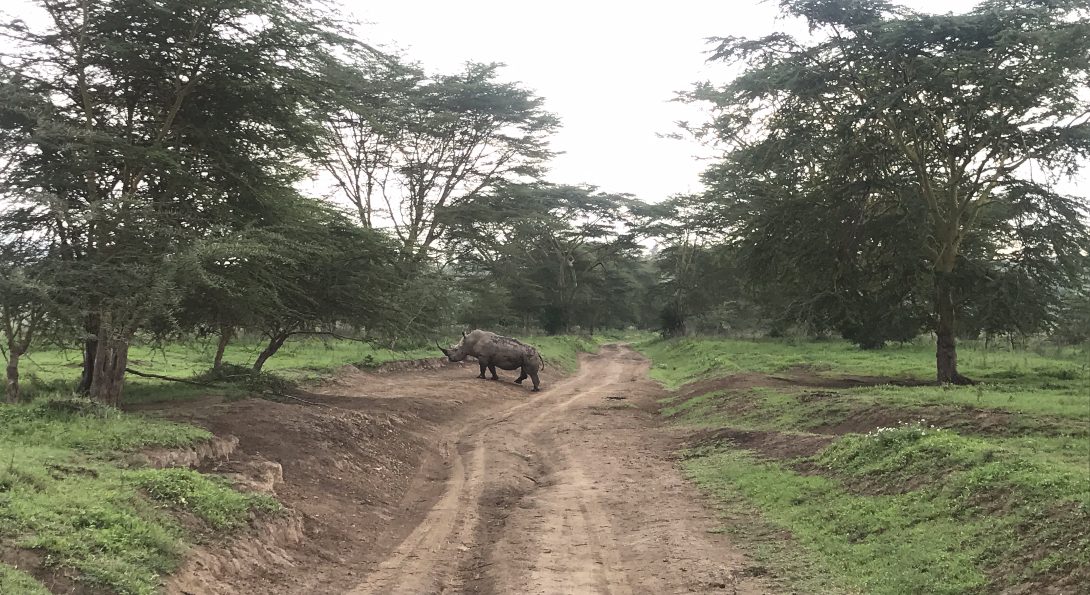
After the training, we made our way Kisumu to get a tour of UNIM (Dr. Bailey’s clinic) and meet up with the other students to head to Nakuru for the weekend. Nakuru is a city in the Rift Valley, about 3 hours from Kisumu, with a lake and national park that is known for large flocks of flamingos in addition other wildlife. Karissa and I took the Matatu to Kisumu ourselves, and then a tuktuk (local “taxi” that is a motorized, three-wheel carriage type thing) to UNIM, so we were very proud of ourselves for successfully navigating our way around. We met up with Colin and Katie, and the four of us found a coach bus to take us to Nakuru. Transportation is very affordable here. An hour long Matatu ride, plus a tuktuk ride, plus the coach bus ticket cost the equivalent of $8.50. We got into Nakuru around 9pm and went straight to our hotel and to sleep so we could wake up bright and early for our all-day safari.
Erica's blog post
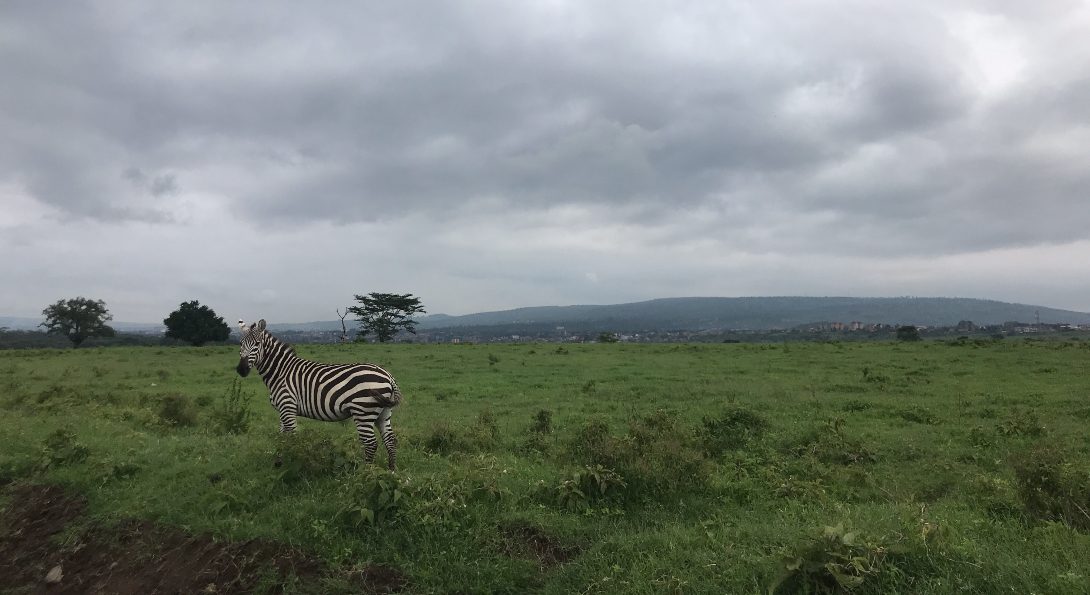
On Saturday, we were picked up by our guide and taken to Lake Nakuru National Park just as the sun started to come up. We spent the morning driving around the park in search of wildlife. We were lucky enough to see both black and white rhinos, zebras, giraffes (my favorite), water buffalo, flamingos, ostriches, baboons, monkeys, antelope, gazelle, impalas, warthogs, and jackals. We stopped at a beautiful resort in the park for an outdoor lunch with awesome views before continuing on with our search for wildlife. We spent the better part of the afternoon searching for lions, cheetahs, or leopards, which can be very hard to see. Katie and I did see a very quick glimpse of some sort of cat, but before we could get a good look it was gone. We think it may have been a cheetah based on what we saw of its tail, but we couldn’t be sure. We ended the day by stopping at gift shop right outside of the park that was quite an interesting experience! It had tons of paintings, carvings, and other souvenirs, but no prices. It was all based on bargaining. I only got a couple small things, so I didn’t have to barter too much, but Colin, Katie, and Karissa especially, all spent a lot of time negotiating back and forth to try to get the best deal. It was fun to watch! After such a long day, we were in the mood for some American food, so we had our driver drop us off at KFC. I actually don’t think I’ve ever even had KFC in the states, but it’s really the only American chain I’ve seen here! We finally got home, 14 hours after getting picked up in the morning, and hung out at the hotel for a while before calling it a night.
Erica's blog post
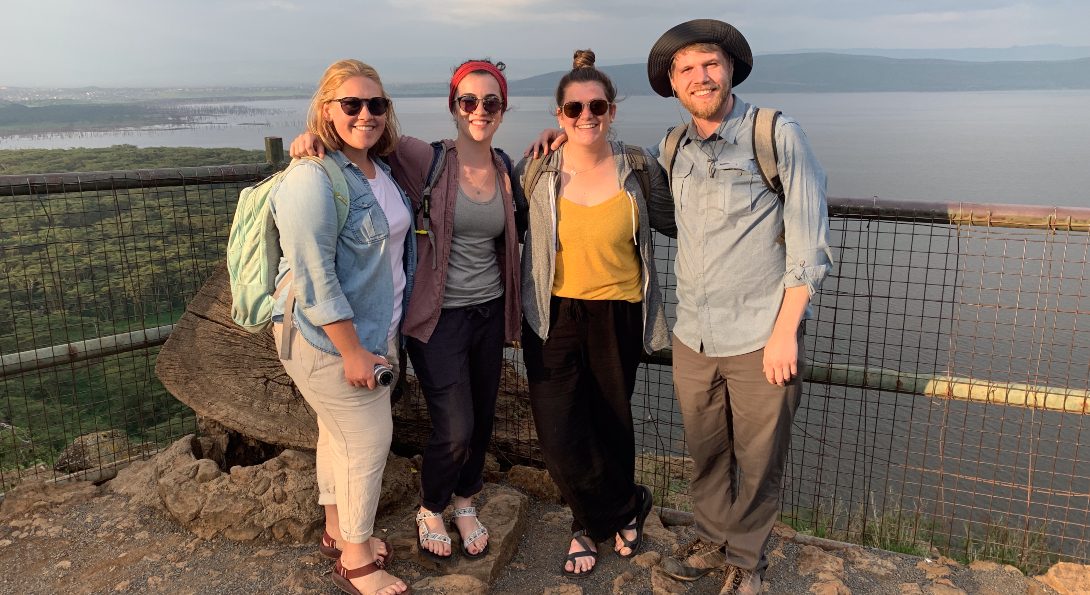
After breakfast at our hotel, we ventured out to the coach bus station to find a ride home, not realizing that it was the last day of break for high schoolers. Most high schoolers here go to boarding school, so they were all traveling back that day, and every single coach bus was full. We unsuccessfully tried to find another bus station before being approached by a local who offered to help us out. Apparently we clearly looked like lost and confused tourists. He took us to another bus station that didn’t have any buses going to Kisumu, so he led us to the matatu station, which unfortunately seemed to be our only option. Desperate to get home, we begrudgingly paid for a ticket, squeezed ourselves into a cramped Matatu, and prepared for the long ride home. Matatus don’t have a set schedule, they just wait until they are all filled up before leaving, so we had to sit for an hour before even starting the journey. Matatus are known for not following the rules of the road, and squeezing as many people as humanly possible into their already cramped seats, so at one point we had 21 people in a 14 seat van. It was quite the adventure. We were all very happy to be off the bus in Kisumu and went for well-deserved lunch and beer at a rooftop restaurant to celebrate. Not wanting to step foot in another matatu for a while, Karissa and I opted to take a tuktuk all the way back to Maseno. It seemed like a good idea, but the journey was much longer and bumpier than we thought it would be, so it turned out to be the wrong choice. It’s safe to say this weekend was full of adventure!
Erica's blog post
This week, after much hard work, our team was able to submit our research proposal to the Maseno University Ethics Review Board. Now we play the waiting game.
During the summer, Maseno University public health students are out on what they call “attachment”, which is their program’s field work. This week, the students were doing surveys in two communities around the university that happen to be the same places that our study will be taking place. Because we have down time in our own work, we were invited to join the students on attachment to get a feel for the communities and what household surveying is like.
Erica's blog post

On Wednesday, we met up with one of the public health students and he took us in a matatu to the community of interest where the other students were waiting to get started. We joined a group of 3 students to conduct the surveys in the villages, which are more rural communities around Maseno and Kisumu. In Kenya, the primary level of health care involves Community Health Volunteers (CHVs). Every CHV has around 100 households that they attend to for basic health care, education, and referrals. They also serve as the liaison for any health programs or research that is being done with communities. A community health volunteer partnered with our group to lead us and introduce us to the households that we surveyed. I was even given the opportunity to conduct one for a woman who spoke English, although I still needed some help translating from one of the students because of my American accent. I was so surprised at how willingly people let us into their homes. Everyone was extremely welcoming and willing to respond to the surveys. It was a wonderful experience to meet so many people and learn a little bit about what day to day life was like for them.
Erica's blog post

On Thursday, Karissa and I were to go to the villages again, but this time we were on our own to get there. We caught a matatu and got to the right place all by ourselves which we were proud of. Kenyans are very laid back about time, so we were the first people to the meeting spot, and waited as each person showed up one by one over the next hour. Betty, one of the students we were working with, told me “if an African says to meet at 9, they really mean 10.” As someone who is chronically late, I appreciate their outlook. After everyone arrived, the CHV led us on an unexpected detour to his home, where his wife had prepared breakfast for all of us! It was a wonderful surprise! We enjoyed Kenyan tea, Chapati (flatbread), nuts, and fruit. I think some of the students were eager to get going, but I enjoyed the slow start to the morning. Two hours after we originally planned to start surveying, we were finally ready to begin. Again on Thursday everyone was so welcoming!
Erica's blog post

After the survey, our CHV led us to an orphanage that he works with to meet some of the kids. All the kids were waiting for us in a classroom, where we were brought to the front and put on the spot by being asked to introduce ourselves and give the kids words of encouragement and advice. We each said our piece and then learned some songs to sing with the kids. It was a wonderful afternoon!
Erica's blog post
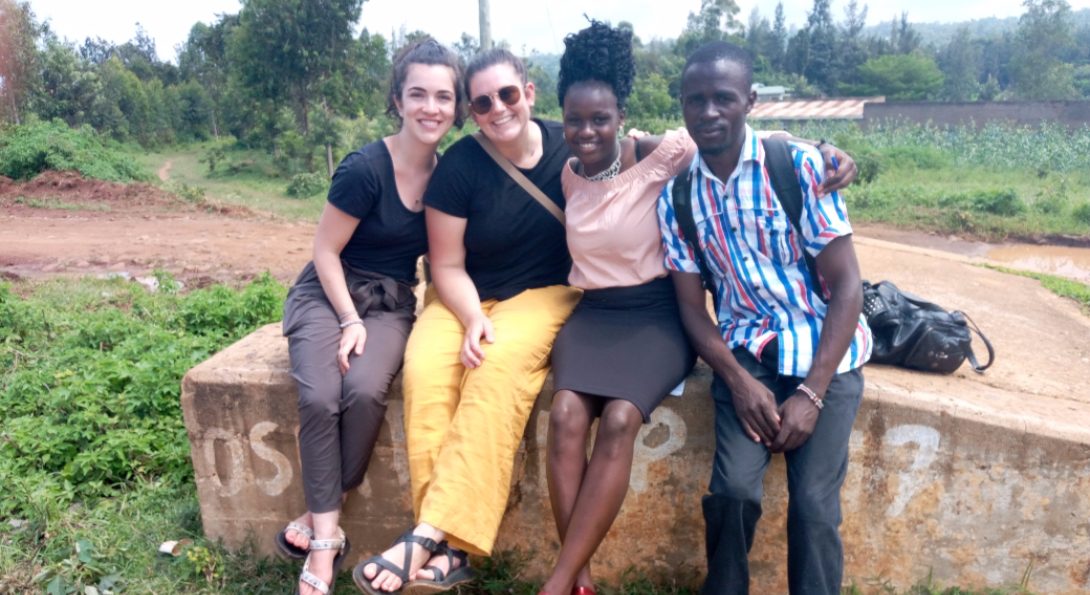
Because we were so efficient with our survey taking on Wednesday and Thursday, we were able to have Friday off. Karissa and I took the opportunity to explore parts of campus that we haven’t been to yet. We discovered that there is a whole section of campus that we didn’t know about! It was really beautiful; built amongst the forest with tons of wildlife and greenery. We enjoyed watching monkeys jump from tree to tree and chase each other around for a while.
We decided to stay in Maseno for the weekend and relax, so I spent a majority of the weekend reading. Saturday afternoon, my host mom and one of the girls showed me how to do my laundry by hand. After finishing, I felt very accomplished, although it was a little bit of an ego check to have a ten-year-old teaching me how to do laundry. Sunday, I took a trip into Maseno with my host family to go grocery shopping and enjoy milkshakes from Java house, an American-style coffee shop similar to Starbucks. There aren’t any grocery stores in Maseno, so my host family gets most of their food from local markets, and then makes a few trips a month to the supermarkets in Kisumu.
This week we will be getting our edits back for our proposal, so I’m sure we will be very busy making necessary changes and preparing to go out into the field to begin surveying!
Erica's blog post
Last week we got our proposal edits back from MUERC. We have minor edits to fix, but the main thing Karissa and I needed to worry about was finalizing the maps for our study locations. We spent many hours going back and forth about which areas to use, where the boundaries are for various communities, and what the different areas are called. There are lots of disputes about where borders are located because they frequently change, and what is reflected on Google Maps and official documents is not necessarily the same as where certain communities start and end on the ground.
Later in the week, Karissa and I met with someone who is familiar with the communities and boundaries. He tried showing us on the map, but after going back and forth for a while, all of us were thoroughly confused. We ended up going for a drive with him, Pauline, and Louisa around the area to scope it out for ourselves and finally (hopefully!) nailed down our final locations.
Erica's blog post
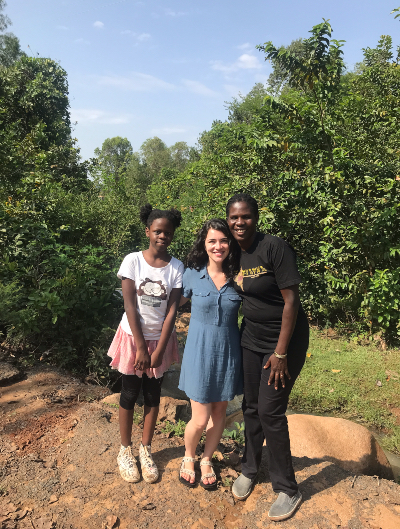
Earlier during my stay here, Grace mentioned that they have a beautiful community library in the hills nearby that she would like to take me to. On Friday morning, she was taking Micha (my 10-year-old host-sister) to the library and asked if Karissa and I would like to join. We gladly accepted, and the four of us hopped in the car and headed there.
Erica's blog post
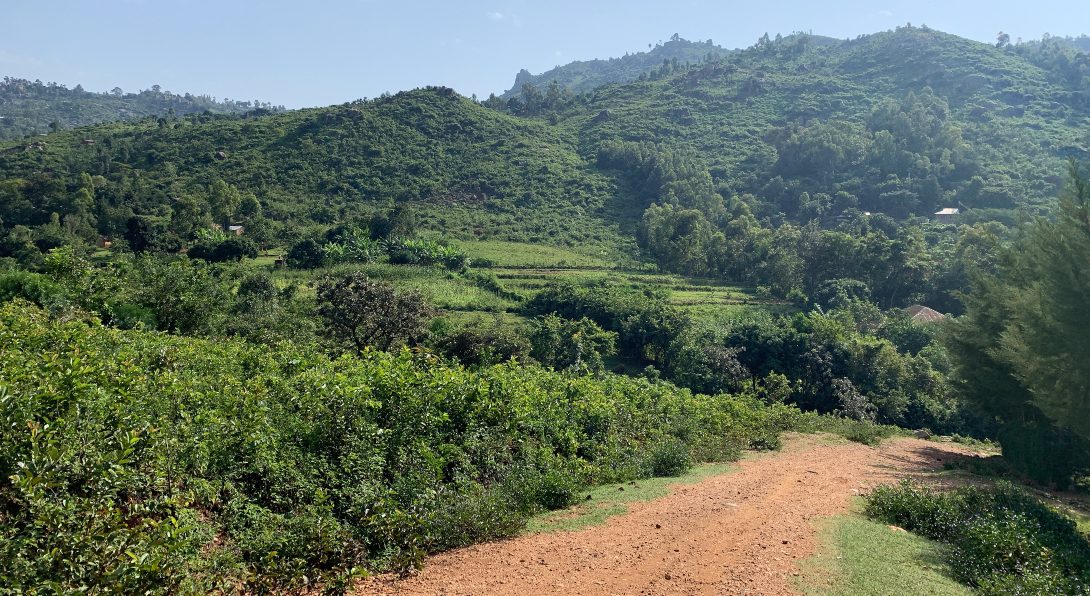
It was probably about 15 minutes from where we stay, but it was so tucked away in the hills that I’m not sure how anyone would find it! You can’t even really get to it by car because it is so far down in the hills. We had to park the car and walk the final part of the trip, which was absolutely beautiful – complete with green, rolling hills and a babbling stream.
Erica's blog post
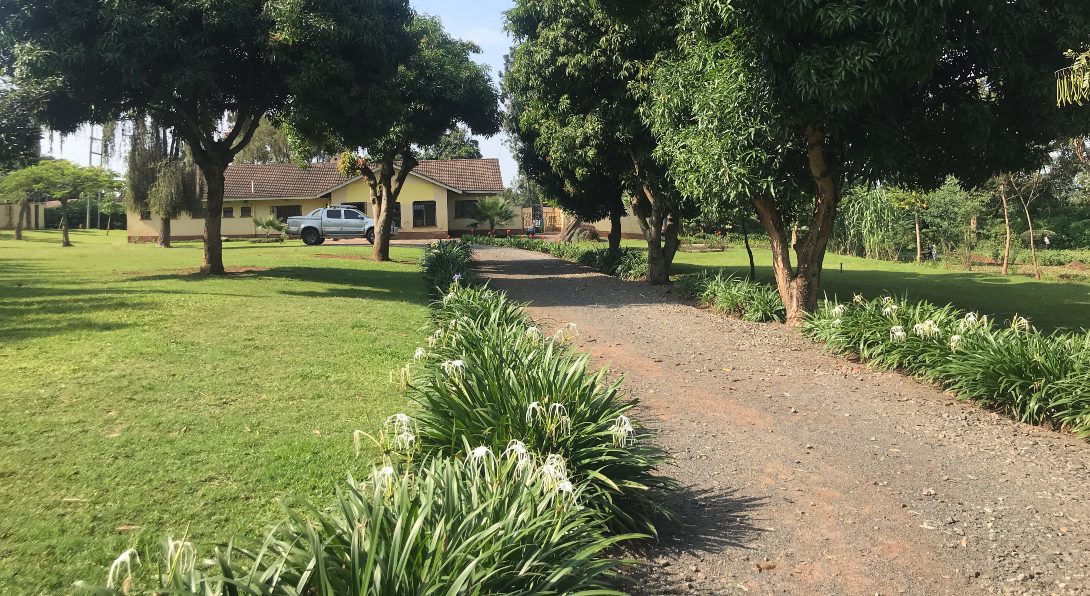
We spent a little while at the library browsing the books, many of which were my favorites from when I was a teenager. Grace told us about how hard books were to come by when she was a kid. She said that she had one book that she read over and over again, and that her brother had a few that he would hoard in his room and keep from her. She said growing up she’d always dreamed of having a house with a big bookshelf full of books, which I am happy to see that she accomplished.
Erica's blog post
After we got back from the library, Karissa and I did a few hours’ worth of work on our maps and the proposal edits, and then hopped on a Matatu to Kisumu. Our first stop was Java House. We have been really missing real coffee, especially iced coffee, since you can’t get it in Maseno, so a trip to Java House was much needed. The iced coffee and American food was heavenly. After Java, we met up with Gabby who was having a stay-cation at a nice hotel for the weekend. We had some drinks, swam in the pool, and treated ourselves to pedicures. They were only around $8, so we couldn’t pass that up! Later that evening, we headed to the other students’ homestay, and had dinner, chatted with their host mom, and watched the US Women’s National Team beat France.
Erica's blog post
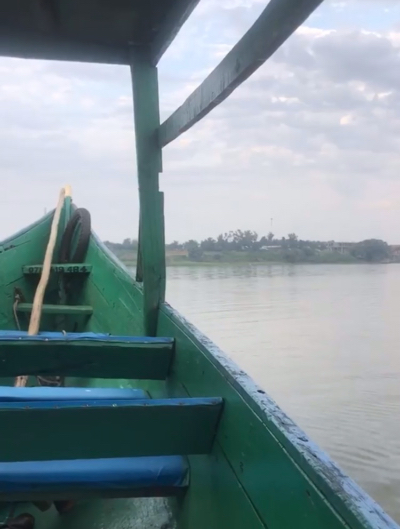
The next morning, we got up very early for a sunrise boat ride on Lake Victoria. A guide met us at the lakefront, we hopped in his boat, and he took us along the shores of the lake and pointed out various wildlife. We saw lots of hippos and many different types of birds.
Erica's blog post
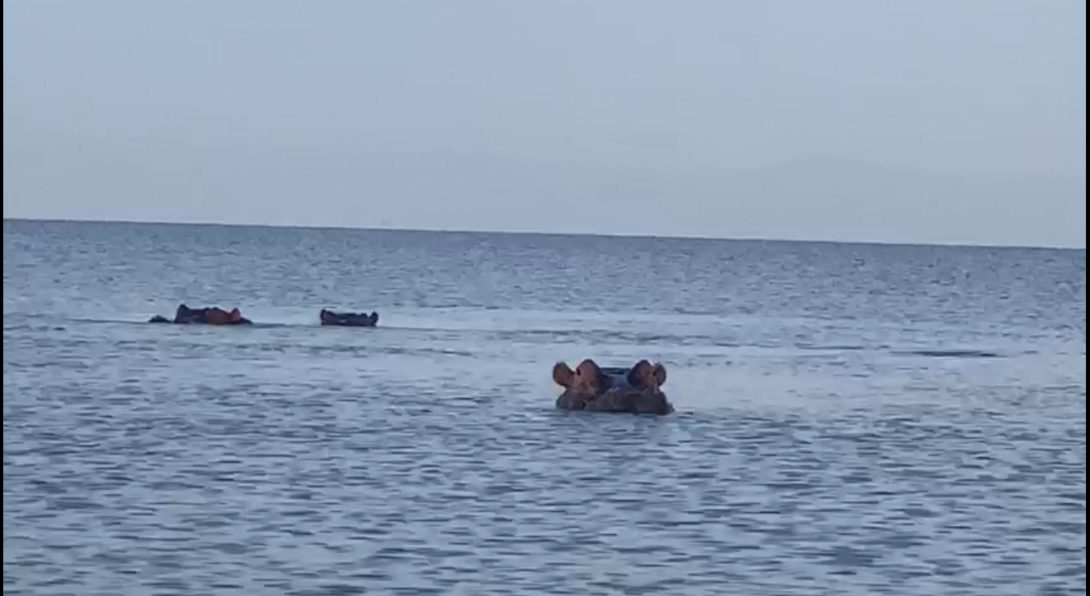
The lake was dead calm and there were very few boats on the water, so it was a really tranquil few hours. Afterwards, the four of us headed to Java House again from some breakfast. After not having what I consider a “typical” breakfast for a full month, my plate of french toast was glorious.
Erica's blog post
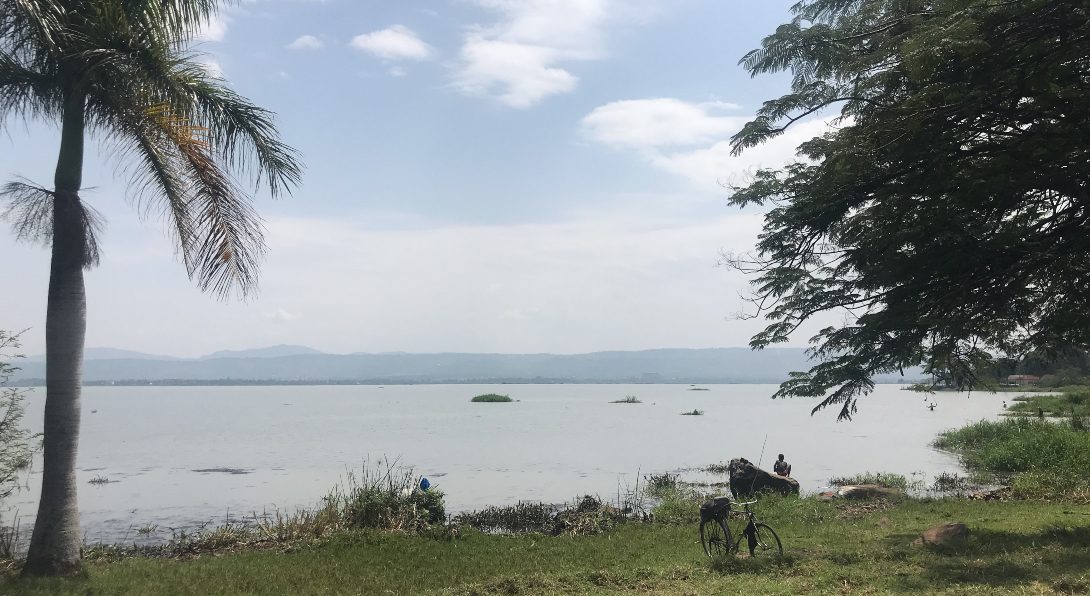
It was a beautiful day, so we decided to go by the lake and lounge in the sun for a while. We weren’t out there very long, but the hot equator sun left some of us a little pinker than we came. Later that afternoon, Katie, Karissa, and I headed to Dunga Hill and enjoyed drinks, food, and cards. Stephanie and Colin joined us and the five of us had a great time chatting the afternoon away. We saw a beautiful sunset over the lake and stayed at Dunga into the evening, until some lightning and thunder ruined our fun. We tried to beat the storm home, but got caught in an absolute downpour.
Erica's blog post
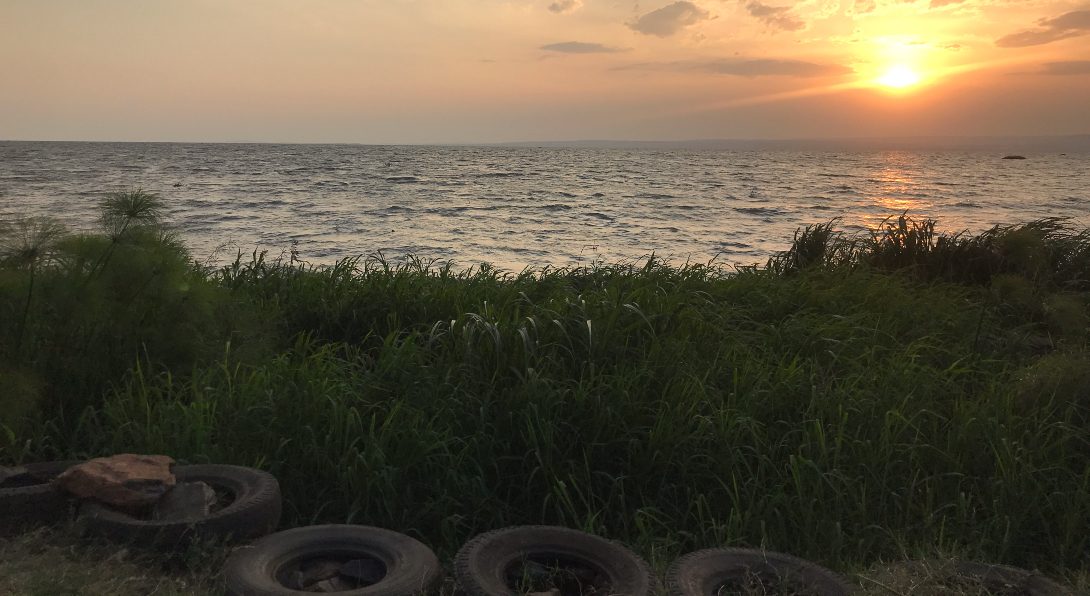
The next morning, we went to (surprise!) Java House for breakfast. Katie, Karissa, and I spent some time planning weekend trips for the rest of our time here. After breakfast, Karissa and I needed to head back to Maseno to do some work before our Monday meeting so we caught a Matatu back. Our questionnaire needs to be translated into Swahili and two local languages (Luo and Luhya), so we spent the rest of the afternoon and into the evening working on adding the translated questions to our questionnaire. It was after dark when we finished, so Karissa and I had a slumber party. We watched a movie and called it a night – this time without any furry, unwelcome guests
erica's blog post
Last week was our fifth full week in Kenya and it was one for the books! Our work week was filled with teaching ourselves yet another unfamiliar software. We were tasked with creating a database in Access so that we could input our survey results, which was easier said than done. I spent the better part of the week watching YouTube tutorials and reading online forums about how to create a database and survey in Access, and then inputting our questionnaires into it. It is still a work in progress, but I think I can say that we have successfully acquired basic skills in both GIS and Access.
The low point of my week (and trip thus far) was finding out that the care package my parents sent me was lost. They sent it to Patrick’s brother, who lives in the U.S. and was due to come to Kenya on July 4th. Although the package was delivered, it was nowhere to be found at his apartment so it didn’t make it to Kenya with him. Luckily, the rest of my week was amazing so I didn’t have too much time to dwell on the disappointment. On Thursday evening, my host family hosted a big gathering for Patrick’s extended family. His uncle passed away last week, so lots of his family was in town for the funeral. In Kenya, funerals are a huge, multi-day event. According to Grace, they are bigger and more elaborate and expensive than weddings. The actual funeral was in the village on Saturday, but everyone was welcomed with a meal and gathering on Thursday evening. Grace was busy the entire week preparing for everyone to arrive. When I got home from work on Thursday, I was greeted with an enormous feast and about 20 people, including Patrick’s brother and his new wife who is also American. They had just arrived from the U.S. a few hours earlier, although their visit just happened to coincide with the funeral and family gathering. Everyone ate dinner and then immediately left, which I thought was funny in comparison to American family gatherings where people stay and chat for hours. I gave up my room to Patrick’s brother and his wife for the weekend, so after dinner I headed to Karissa’s for another slumber party.
erica's blog post

The next morning, Karissa, Katie, Stephanie, and I started the journey to Jinja, Uganda. Katie and Stephanie hopped in a Matatu in Kisumu and Karissa and I waited in Maseno for them to come through, and then the four of us were on our way. It was about a 1.5-hour journey to Busia, which is the town on the border between Kenya and Uganda. We had to get off at the border and go through immigration, at which point Karissa and I discovered that we were given the wrong Kenyan visa when we entered (30 days instead of 90) and were in the country illegally for 6 days. Luckily we didn’t get in any trouble for overstaying our visas, but we would have to pay for a new one when we re-entered Kenya which was a bummer. After making it through immigration, we exchanged money and found a new Matatu to take us the rest of the 2.5 hours to Jinja. About halfway there, we heard a loud noise, followed by a very bumpy few seconds. Karissa looked out the window and confirmed that we had a flat tire. Everyone had to get off the Matatu and we weren’t sure if we should wait, try to find and pay for a new ride or what we should do. We soon realized that the Matatu conductors are very well versed in changing a flat tire, so it was taken off and replaced in about 10 minutes flat and we were back on our way.
erica's blog post
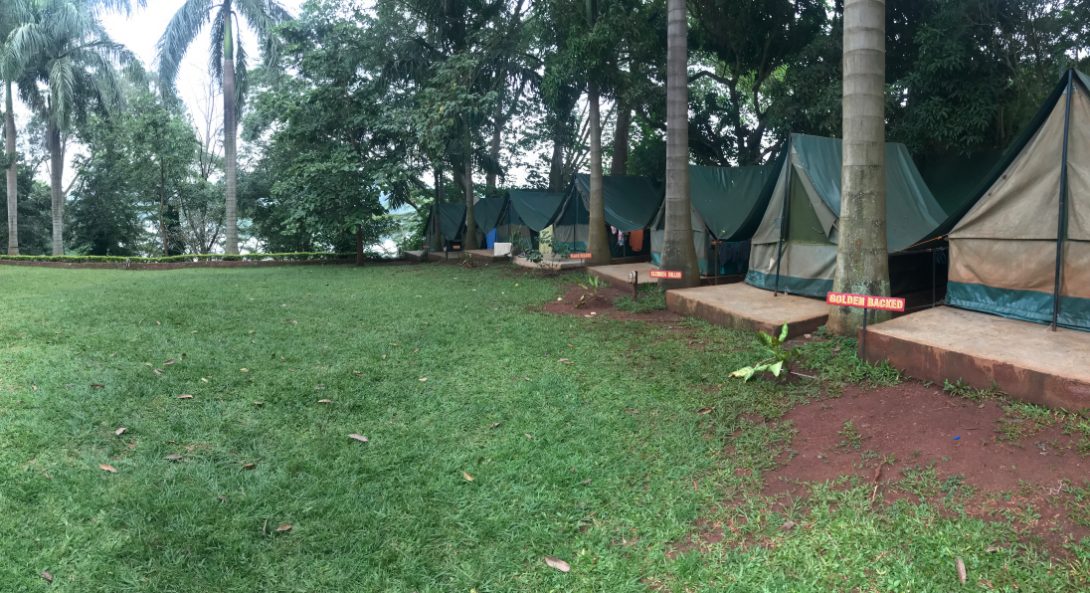
When we finally made our way to the “base camp” (the in-town location) of the place we were staying we had some extra time to spare before our shuttle to the camp on the Nile River, so we found a Mexican restaurant (!!!) and enjoyed some chimichangas and margaritas. Tacos are the one food I have been craving and not able to find at all here, so I was very happy to find a Mexican place to eat. We made it to the Nile River camp just in time for our 5pm sunset cruise. The camp was absolutely beautiful – situated high on a bluff overlooking the Nile River. We unloaded our things into our safari tents and hopped on the river cruise to enjoy the sunset, food, and drinks.
erica's blog post
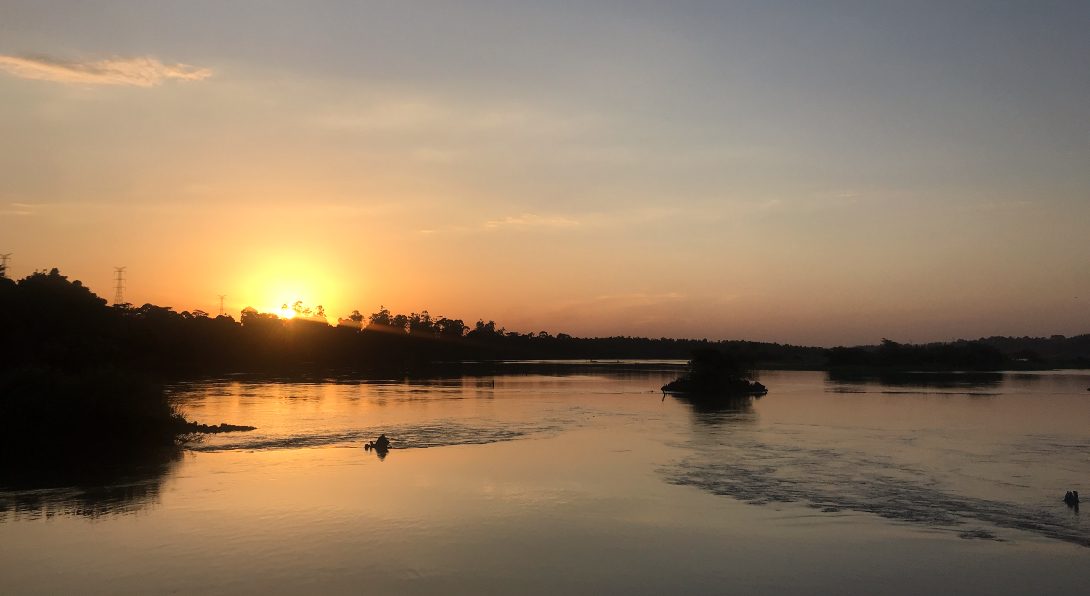
The next morning, we woke up early for the big day – white water rafting on the Nile River. We opted for the class 5 option, which was the more extreme of the two choices. The route consisted of all class 4 and 5 rapids (the highest is class 6), which I had never done before. We were all a little nervous, but read nothing but amazing reviews online so we decided to go for it. We took a bus back to the base camp in town to eat breakfast, meet up with other rafters, and debrief. Once we got to the river we split into groups, did a few safety drills (practicing falling out, flipping the boat over, getting back in, etc.) and then we were off.
erica's blog post
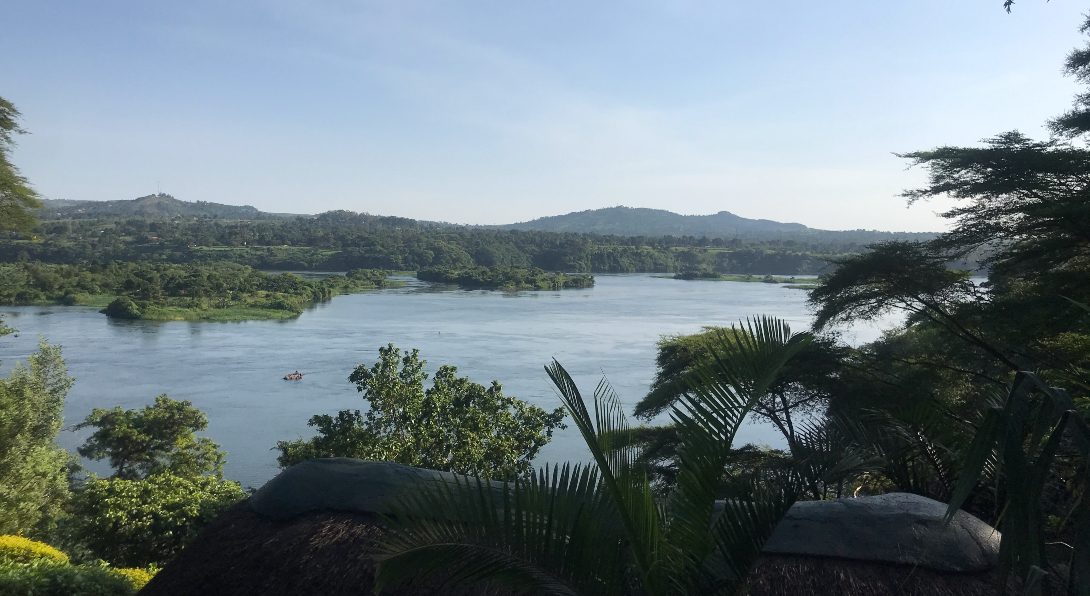
We immediately started with back-to-back rapids. The first was class 5, and then class 4. It was absolutely insane!! There were 2 and 5 meter drops followed by huge waves that completely submerged our raft. I thought we had definitely flipped, but after a few seconds of chaos we came out the other side upright and unharmed. All the rest of the rapids were sandwiched between long stretches of very calm river where we were able to jump out and swim to cool down. The Nile River is extremely warm, so it was great for swimming in.
erica's blog post

The next rapid caused all the boats to flip over but ours, so we were feeling like experts by the time lunch rolled around. We pulled over at a spot that has a natural wave in the middle of the river, and the guides showed us how to swim out to the wave with a boogie board and attempt to find the sweet spot and ride the wave. We all tried but it was extremely hard! You had to swim against the current with all your might to make it out the wave before the current swept you right past it. I was only able to ride it for about a second before getting sent downriver.
erica's blog post

After we all attempted to boogie board, there was a big barge waiting for us at a nearby island with lunch prepared. Above the island there was a swarm of thousands and thousands of fruit bats. They filled the sky and hung from every inch of every tree in sight. Apparently, the trees on the islands have fruit that they eat, so they completely wipe out the fruit on one island and then move to the next and the next. The first rapid after lunch was a class 6, which is too dangerous for commercial rafting companies to go through, so we got out and walked to the bottom part of it, which was another class 5 rapid. Our guide, Peter, asked if we wanted to stick to the side, which was more tame, or head to the middle for the crazy stuff. I was pretty unsure, but my team peer pressured those of us that were nervous to go to the middle. Again, we were tossed around and completely submerged at times, but came out upright and unscathed. We looked back and watched the other two boats both opt to take the easy way down the rapids. After one more big rapid, we ended on a class 1 rapid where we were able to hop out and ride the current for a while. It was a fun way to end an adrenaline-filled day. Once we were finally on dry land, we were rewarded with beer and snacks and boarded the bus for the hour-long journey back to the Nile River Camp.
erica's blog post
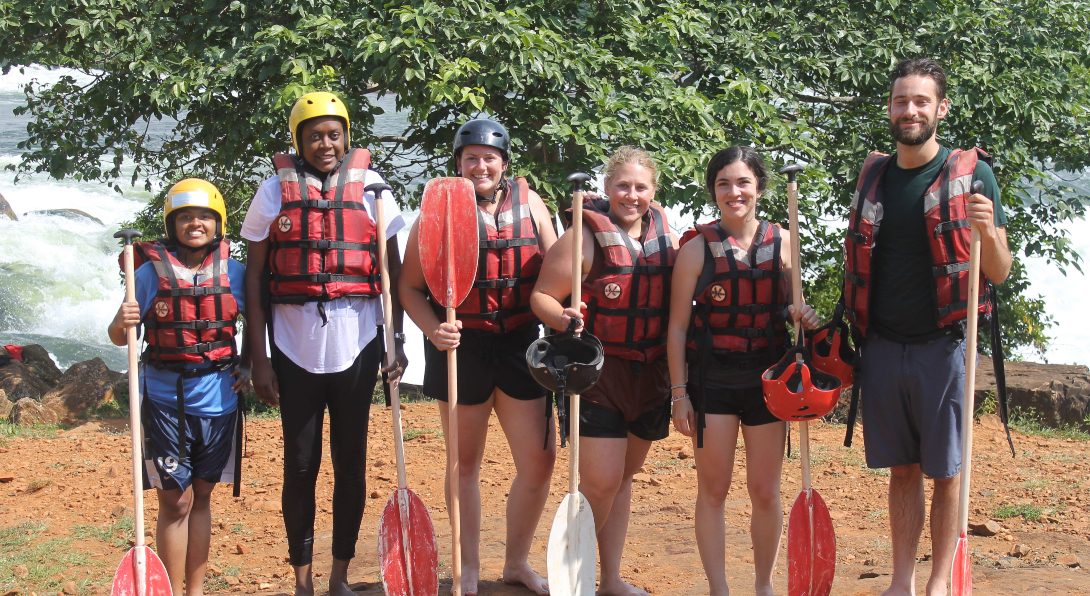
Back at the camp, the four of us sat on the deck overlooking the river and had dinner, drinks, and played cards. We were joined by one of the safety guides for the day, who rode along with the rafts in a kayak and helped get people back to their boats if they fell out. He had never played cards before, so we tried to teach him how to play slap jack. I don’t think he ever fully got the hang of it, but it was hilarious and fun anyway. He’s Ugandan, but was telling us about his rafting and kayaking jobs that he’d held all over the world. He (and many of the other guides) are also competitive Kayakers. His two older brothers were guides too and both competed in Kayaking in the Olympics!
The next morning, we started our long journey back to Maseno. Luckily, it was pretty uneventful. We are really getting the hang of the Matatu lifestyle! I’m actually starting to become fond of the Matatus now. They are so easy to navigate and there’s no set schedule, so really at any time you can find one going to the place you want without having to worry about keeping to a schedule. You can just ask someone to show you one going in the right direction, and everyone is so willing to help you out. Our taxi driver that took us to the Matatu from camp even made sure that we knew what the right rate we should pay was so that we wouldn’t get scammed. We got to the border and had to pay an extra $50 for our new visa, which was unfortunate, but we were sure to get one that covered the rest of our stay this time. I made it back home just in time to watch the U.S. Women’s National Team beat the Netherlands in the championship game. The cherry on top of an amazing weekend!
Erica's blog
Last week we finally were able to have our trainings for the students that will be helping to conduct our study. We have 16 students from Maseno University assisting, most of whom are undergraduate students in addition to a few MPH students. We held three days of training to go through our questionnaires, consent forms, study protocol, and to conduct training in anthropometry (measurements such as height, weight, and mid-upper arm circumference to assess child nutritional status). Dr. Bailey ran the training for the most part, with some input and assistance from Karissa and me. The first day, we went over the household questionnaire and the consent form for the study. The second day, we went over the women’s questionnaire, practiced administering questionnaires, and trained in anthropometry. On the last day, the team went over any comments, issues, or questions that came up when they went through the questionnaire and continued practicing anthropometry.
Erica's blog
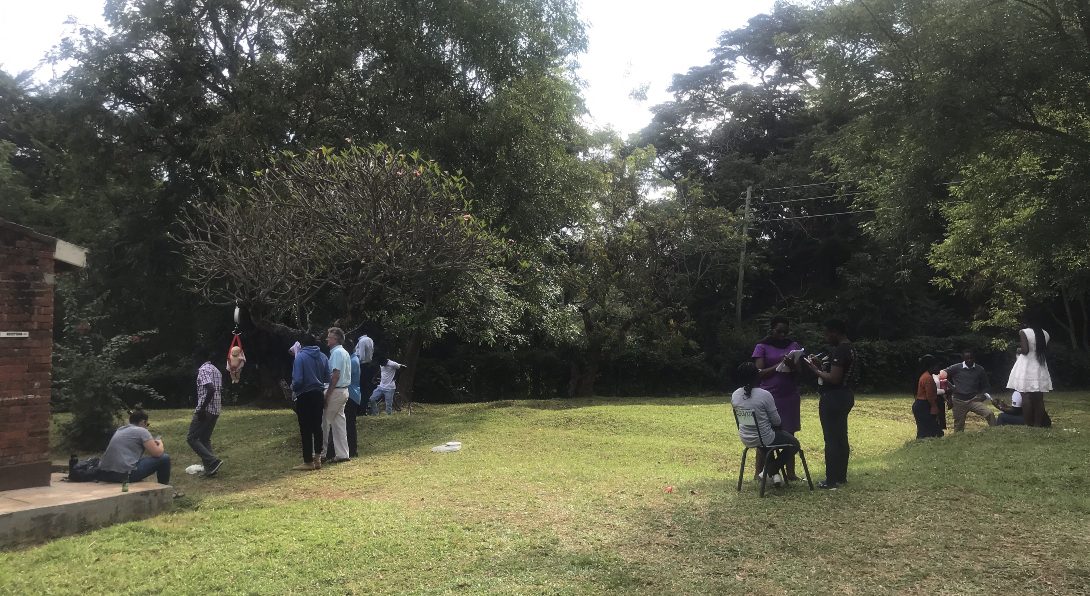
I suppose I should actually discuss what our survey is since I’ve been talking about it the whole summer! There are two sub-locations surrounding Maseno University that were chosen for the survey because of their rural nature. We randomly selected a sample of households in each sub-location to be given our surveys. We will be administering each selected home one survey to be given to the head of household, and one survey for every woman of reproductive age (18-49 years). The surveys collect data on a variety of topics such as household demographics, socioeconomic status, chronic disease, water quality and sanitation, communicable disease, sexual health, reproductive history, pre- and post-natal care, and growth and nutrition data on children under 5 years. The surveys are meant to touch on important health topics in order to identify health needs and assets of the communities around Maseno University so that they can be addressed by future programs run through the University. The students assisting with the study will be the ones actually administering surveys because they all speak Swahili as well as Luo (the local tribe’s language).
Since we traveled last weekend and are traveling again next weekend, we decided to take this one off. I spent pretty much the entire weekend relaxing and reading. Saturday night, I spent the night hanging out with my host family. We enjoyed drinks, watched some YouTube (the girls’ favorite!), and I let Micha pick out a movie using my Netflix for us all to watch. On Sunday, Karissa and I decided to finally check out the bar at the equator, so we met up and spent the afternoon sitting under a gazebo outside and enjoying local beer. Tomorrow we begin field work, so I’m sure it will be a very busy week!
Erica's blog
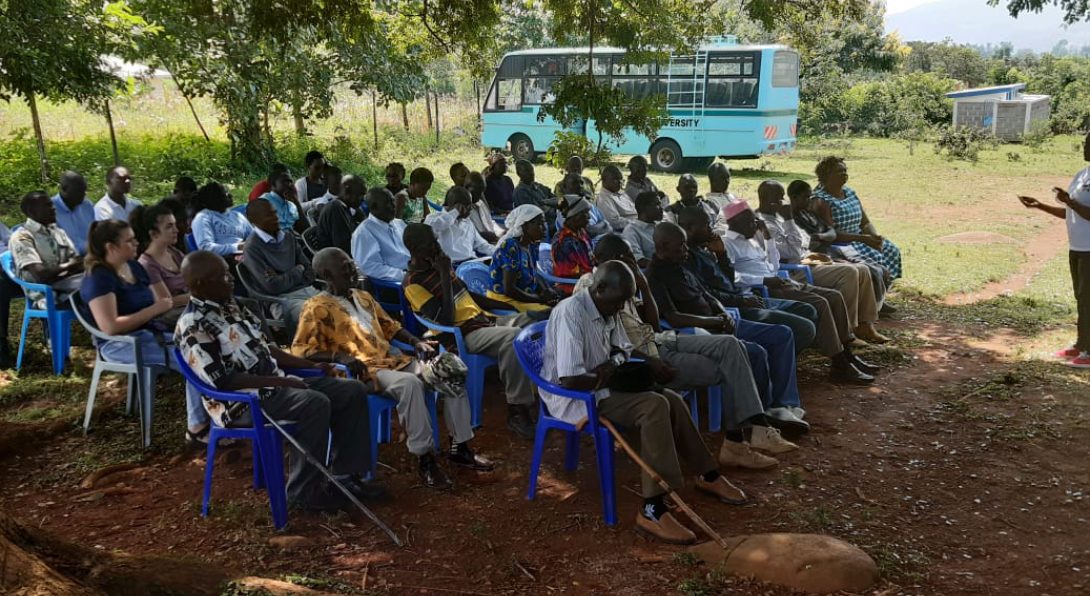
This week started with our community entry at the Chief’s baraza (a public meeting place). We met with the chiefs of the two sub-locations we will be surveying in, along with village elders for those areas. We all introduced ourselves and Dr. Bailey described the study we will be doing with translation help from Louisa and the Public Health Officer (PHO) we’ll be working with. Following the meeting, we went out into the field to conduct some pilot surveys as practice. It turns out it was a good thing that we had an afternoon of piloting, because there were many mistakes that were made in administering the survey. It was difficult because we couldn’t understand the survey as it was being administered, so it wasn’t until we looked through them after the fact that we saw that errors were made. Additionally, after the PHO looked at our map, he informed us that our boundaries were from an outdated map and would need to be changed. This meant that Karissa and I had to completely redo the GIS work we did, re-do the random selection of study areas, and re-assign study areas to each of the teams. I spent the night at Karissa’s because after being out in the community all day, we had to work into the night to make all the necessary changes in order to be ready for our first day in the field in the morning.
Erica's blog
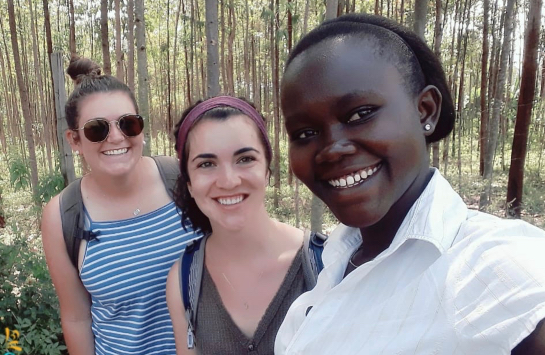
The next morning, the team met at a central point to touch base before beginning our first day of surveying. Two Maseno MPH students were assigned as project leaders, so we had them accompany the groups that seemed to need additional help. Karissa and I also each went with a group to supervise and provide assistance. My group met up with our CHV and followed the map out towards our first section of households, which was all the way at the edge of the map. As we neared it, our Community Health Volunteer (CHV) informed us that we were leaving the study’s designated sub-location and entering a new one – one we didn’t have permission to be working in. After some discussion, we discovered that our map boundaries were wrong yet again. My group and Karissa’s group had study areas that were entirely outside of our allotted area, so we had to do some serious problem solving which was difficult when out in the middle of nowhere with limited cell phone service and teams scattered far and wide. It was extremely, extremely frustrating because of the amount of people we have consulted with over these maps and the amount of times we have had to change them over the past month, only to discover that they are not correct when we stepped out into the field. After putting our heads together, we ended up deciding that we would each survey an area assigned to one of the other teams for the rest of that day, and then reconvene that night to try to figure out what to do. Once my team finally made it to an area that was actually part of the study (which was also no easy feat!!) we started surveying. Once we started, it was a relief. We finally felt like progress was being made. I really enjoyed being there with the students as they conducted surveys. The welcoming nature and the sense of community in the villages, and I think in Kenya in general, is really incredible. Again, people readily welcomed us into their homes with open arms. Everyone also knows their neighbors and community members really well. Even the CHV knew exactly who lived in each house, what they did, where they were from, who their family was, and many other details about their lives.
Erica's blog
After a very long and tiring day in the field, Karissa and I had a phone meeting with Dr. Bailey to discuss how to deal with our map issue and decided to just work in the area we knew was definitely correct and consult the PHO to fix our boundaries. This meant re-assigning the study areas to teams yet again. That night we also went through all of the questionnaires and discovered many errors that needed to be addressed the next day.
In the morning, the team convened at the field again and Karissa and I met with each student individually to go through their questionnaires from the day before and address any mistakes that were made. Karissa, the two other leaders, and I, each went with new teams to assess how they were doing and help them in their survey administration. The second day went much better. The team I was with seemed to be getting the hang of navigating the area and administering the survey, and we didn’t have any major hiccups like we did the day before. Even though things went more smoothly, it was not an easy day. Field work is no joke!! Not only are we conducting in-depth interviews with multiple people in each household, we are also traipsing around rugged, unpaved roads and walking long distances all day long. At the end of each day I was mentally and physically exhausted. We did have a pick-me-up at the end of the day and we had an unexpected surprise! Out of nowhere, Chief (Dr. Bailey’s friend from Nairobi that we stayed with at the beginning of the trip) and his brother Zack walked up to us and gave us the biggest hug! They were in town because their home area is nearby and just happened to drive past and see us so they turned around to say hello! It was great to see them and they were nice enough to give us both a ride back home from the field. After being in the field all day our work didn’t stop, because again Karissa and I spent the night combing through each of the surveys looking for glaring issues. Unfortunately, that night Karissa discovered that one of the teams disregarded their assigned survey area and doubled-up on an area that another team had already done.
On Thursday, Karissa and I both went with the same group so that we could work together sorting out some of the issues that came up over the first two days. Day three was again a bit better than each of the two days before, so we were hopeful that we were heading in the right direction, and there was a bit of improvement each day. It’s safe to say it was a very, very challenging week, so we were excited to be able to enjoy ourselves at Masai Mara over the weekend.
On Friday morning, we woke up before the sun to catch an early matatu into Kisumu to meet with the other students and our driver to head to Masai Mara. Masai Mara is a famous national park in Kenya that is world-renowned for it game viewing. It is the one thing everyone says you must do while you are here, so we had to squeeze it in before our summer was over. July-October is the high season for touring the Mara because of the great Wildebeest migration. Hundreds of thousands of Wildebeests migrate north to Kenya from the Serengeti in Tanzania, so people come from all over to see it. Unfortunately, high-season also means expensive season, so we really had to work hard to try to find something that fit into our student budget. We ended up being able to negotiate with the company we went to Nakuru with and got a pretty good price. We spent all day traveling to Masai Mara, with just a quick stop for lunch in Narok, the town nearest to the park. The drive to get there was an adventure in and of itself. Despite Narok being the closest town to the park, it was still another 2.5 hours away from the entrance, with the last 2 hours being on completely unpaved, almost impassable roads. More than once I thought our car was going to tip right over or get stuck in the massive craters we were navigating through.
Erica's blog
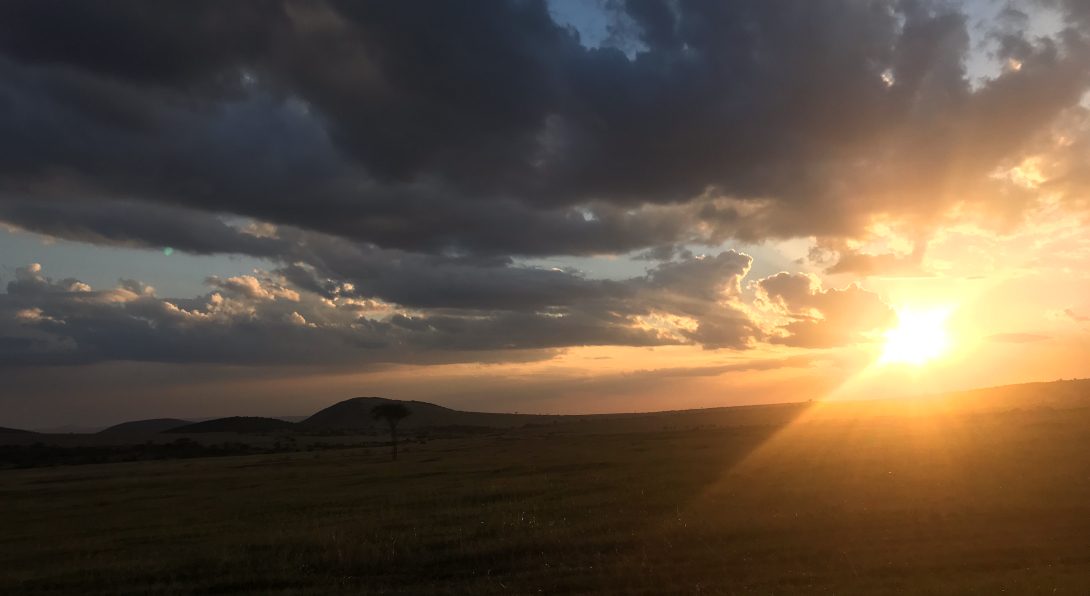
We finally made it around 4pm and quickly dropped our stuff off before heading out for an evening game drive. Almost immediately after entering the park, we saw a crowd of cars gathered around 2 male cheetahs lounging in the shade! That evening we also saw zebras, giraffes, elephants, and an absolutely amazing sunset. Just as we were leaving the park, we also came across a mama lion snoozing in the grass! Our first drive was quick but successful! We went to bed early in preparation for our all day game drive on Saturday.
Erica's blog
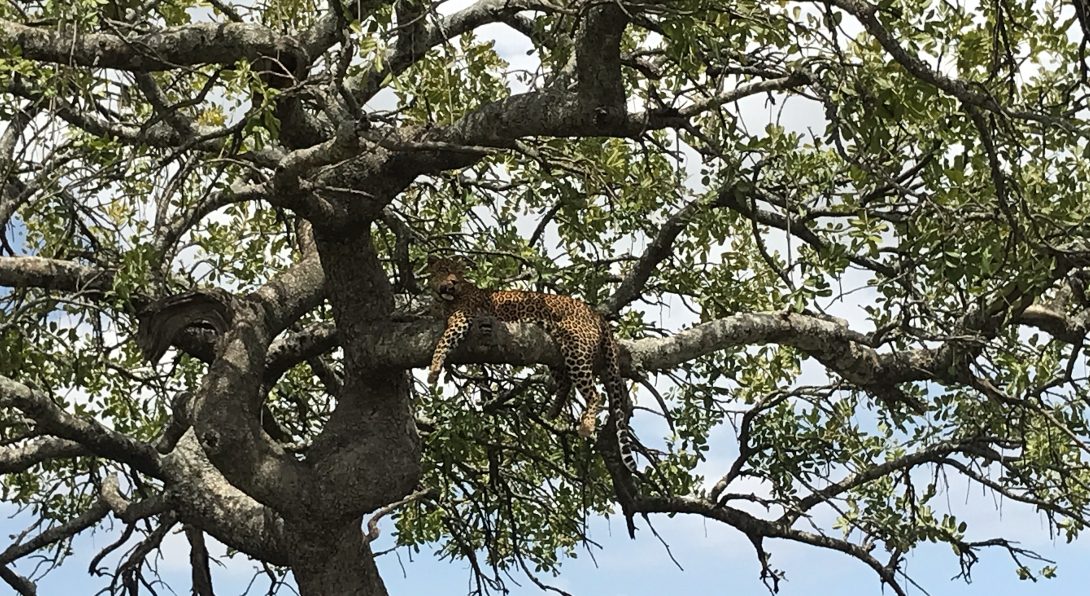
The next morning, we woke up at 5am in order to have breakfast and get to the park by the time it opened at 6:30am. We got so lucky with what we saw on Saturday! We spotted a group of 5 male cheetahs (probably brothers) hunting wildebeests. We didn’t see the take down but did see them running after them and then the aftermath of them enjoying their meal. We also saw many different groups of lions, two of which we were the first to spot and were able to get up close and personal with. We also saw two leopards hanging out in trees, which is apparently very lucky because they camouflage themselves well and can be hard to find. Our driver was the first to find one of the leopards, so we were able to pull up and get an amazing view of it. We also saw zebras, elephants, giraffes, wildebeests, warthogs, hippos, crocodiles, bat-eared foxes, hyenas, ostriches, mongeese, and more! One of the highlights of the day was getting to see the wildebeests cross the river. Apparently it is really rare to get to see, so we felt very fortunate. Thousands of wildebeests followed their leader and stampeded towards the river, down the bank, and into the water, where they fought the current to swim across and climb up the other side. It was truly amazing. We ended the day by parking the car and watching the sunset before heading back to camp for the night.
Erica's blog
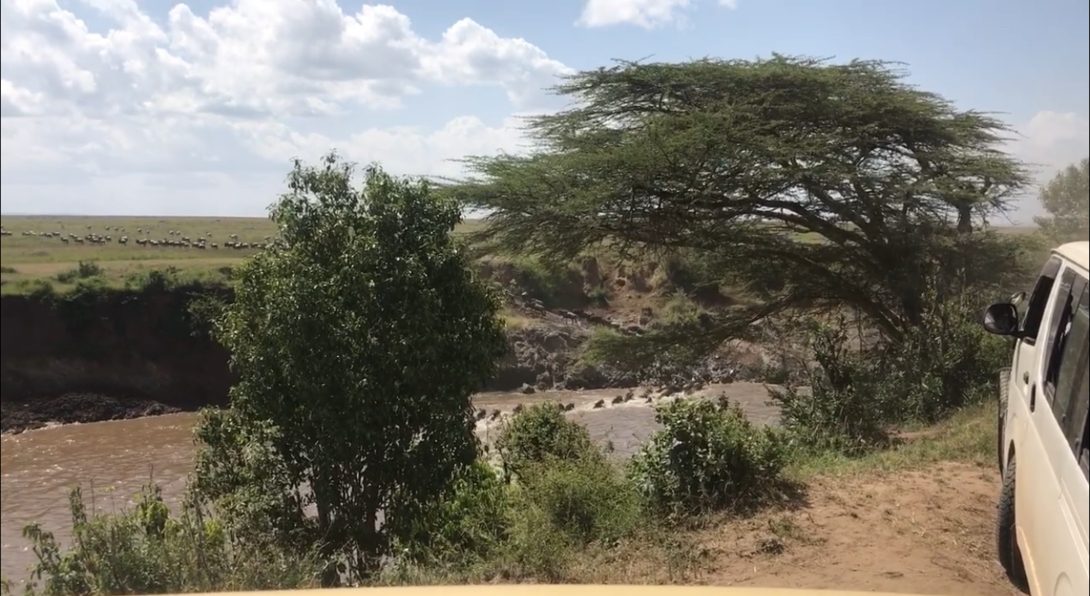
On Sunday, we got up very early again for a quick game drive before heading back to Kisumu. We were lucky enough to see a lone lioness unsuccessfully try to hunt a wildebeest, and three lions hanging around another pack of wildebeests, perhaps strategizing how to catch their breakfast. After our game drive, we started the long journey back to Kisumu. As we made our way back towards civilization, we ran into a (literal) roadblock. A giant truck was stuck in a narrow passage of the road, making it totally impassible. We were parked for an hour along with many other tourist groups trying to leave the Mara, while people tried to unsuccessfully push the truck out. Eventually, our driver gave up and backtracked to find another route around the roadblock. He found one, which ended up being even more of an offroading experience than the main route. We stopped in Narok again for lunch and then had two more mishaps before finally making it back to Kisumu. First, we hit a small impala-type animal. It didn’t seem to phase our driver though, as he didn’t even stop to check for damage. Then, when we were almost back to Kisumu we got a flat tire. We had to pull over at a gas station just before we got into town and fill up with air to make it to our drop off point. When we finally got dropped off, Karissa and I caught a matatu back to Maseno. We had plans to accompany her host grandma to Kakamega (the university she works at) on Monday, so I stayed at her house that night. It was definitely a very long, challenging, exciting, and eventful week. I really can’t believe I only have two weeks left!
Erica's blog
This week we started off with a trip to Karissa’s host-grandma’s University, Masinde Muliro University of Science and Technology (MMUST) in Kakamega which is about an hour from Maseno. Asenath (or “prof” as her students call her) was just appointed as the acting Vice Chancellor, which is the second highest position in the university, so along with that she got a driver, a bodyguard, and a “soldier” to guard her house at night. On Monday morning, her driver and bodyguard took Karissa, Asenath, and I to the university. We met with her previous department, Public Health Nutrition, and got to see her impressive office which was the biggest in the university and had a beautiful view of campus.
Erica's blog
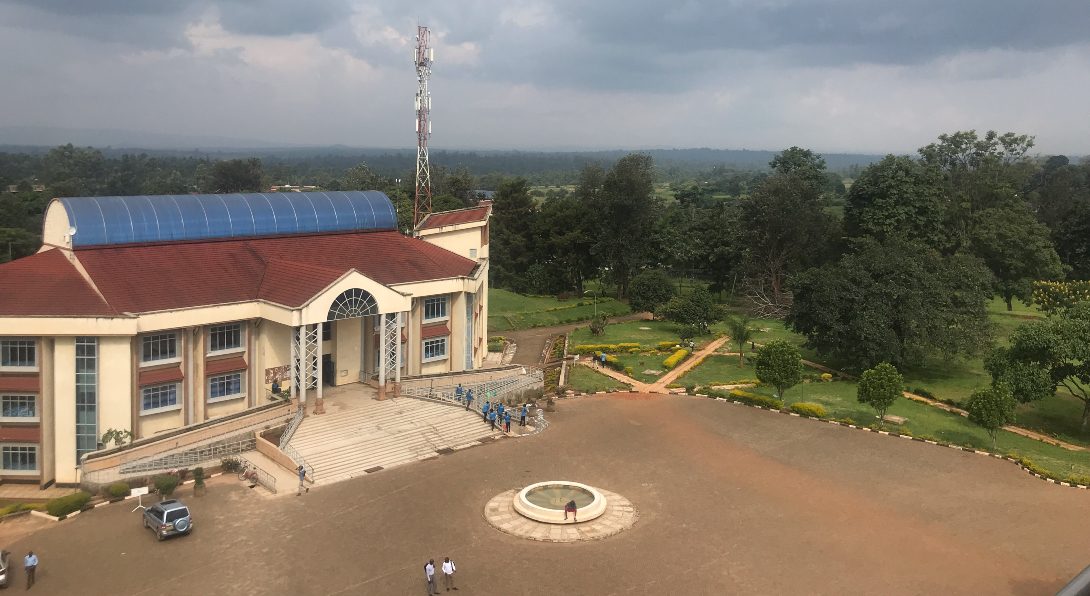
We were introduced to two of the masters students she mentors and they took us on a tour all around the university. We got to see Asenath’s project that she started, which was a mushroom and spirulina research project that is still going strong. They were growing and drying mushrooms and spirulina which was made into flour for porridge and capsules for consumption. The girls also took us by the new School of Music, where the choir happened to be practicing. When they saw that we were visiting, they insisted on performing a special piece just for us, which was incredible!! We also had a private lunch prepared for us with the two girls that toured us around in addition to a few of their peers. Following lunch, a driver took us all the way back to Maseno. It was a lovely day!
The rest of the week consisted of data entry, data entry, and more data entry. The team was still in the field, but the stack of surveys was growing rapidly, and Karissa and I needed to start getting the data entered into the database, or we would never finish. At first, we really struggled with some issues in our database that didn’t come to light until we started trying to enter data. There were certain settings that weren’t quite right and were stopping us from being able to enter data. I’m sure someone who is well versed in Access would have been able to fix the issues quickly and easily, but as neither Karissa nor I had any prior experience, it took us forever to work out the kinks. Finally, by halfway through Wednesday we seemed to have gotten everything figured out and we were able to enter data without any hiccups. We spent the rest of the week entering survey after survey and listening to throwback playlists to try to make the monotony a little more bearable.
Erica's blog
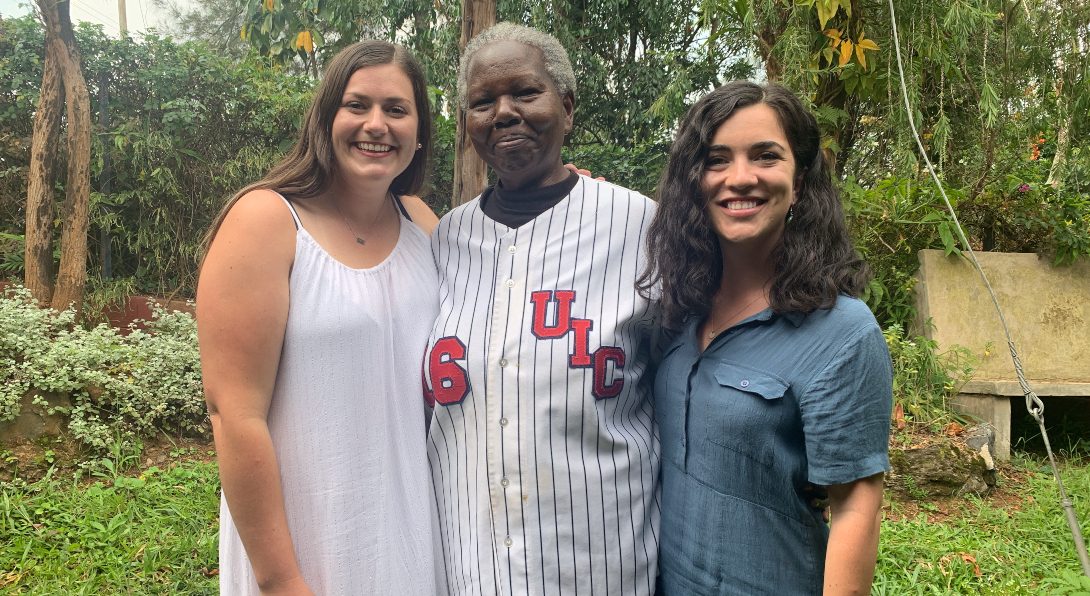
Karissa’s host-grandma wanted to host a party for us since it was our last weekend here, so she had us invite all the students we’ve been working with on the project, as well as Dr. Bailey, Katie, Stephanie, and Gabby. We decided that we wanted to bake a cake for the party as a thank you for everyone’s hard work and dedication to the project, so on Friday Karissa and I embarked on that endeavor. Morna (my 13 year old host-sister) is quite the baker, so I asked her for her chocolate cake recipe. We gathered all the ingredients to bake it at Karissa’s house, but found out that their gas oven only has two settings: “hot” and “less hot” – not ideal for baking. After mixing all the ingredients together we decided to make a small test cake. It came out pretty good, but a little burnt on the edges, so we turned the oven to “less hot” and popped in our giant pan, hoping for the best. We had to check on it frequently because we had no idea what the temperature actually was or how long to bake it for. After the fourth or fifth time checking it, we discovered that it completely overflowed out of the pan and was all over the inside of the oven. We took it out and determined that it tasted totally fine, but looked like a disaster. Using our improvisational skills, we decided to turn it into cake balls instead, which actually turned out delicious.
Friday after work, Patrick treated Karissa and I to drinks and food at the Maseno Club – a restaurant/bar near my homestay that we had no idea existed until now. The three of us sat outside under a gazebo enjoying local beer and food and chatting into the evening.
Erica's blog
Saturday was the party, so Karissa and I both got spruced up a little bit (by which I mean we wore our hair down and put mascara on for the first time since May). We decorated Asenath’s beautiful garden and waited for guests to arrive. The first to show up was Rhoda, one of the students who toured us around MMUST on Monday! It was a wonderful surprise to see her, as we invited her but didn’t expect her to make the long journey all the way from where she lives (past Kakamega). Eventually, many of the other students plus Dr. Bailey, Katie and Gabby made their way. We enjoyed a wonderful afternoon of food and good company. The highlight was when everyone went around and introduced themselves to each other and said a few words of appreciation. Karissa and I both got choked up at all the kind words and felt so appreciative of everyone being so open and welcoming to us while we’ve been here. It truly was a great way to close out our time here.
Erica's blog
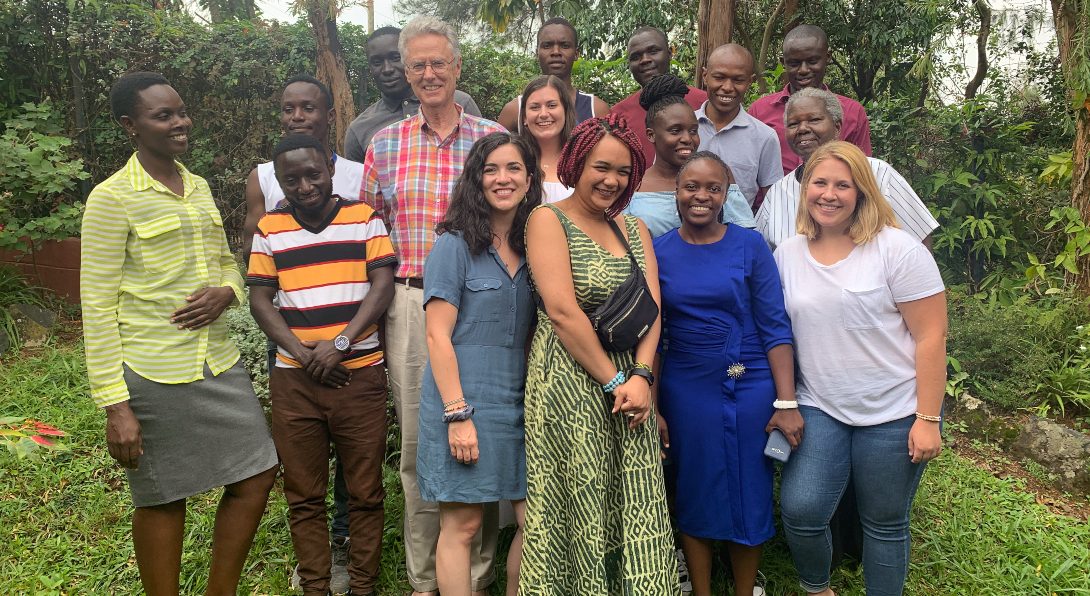
On Sunday, I spent the day relaxing with my host family. Grace’s nephew and his girlfriend came from Nairobi for the day, so we enjoyed a nice meal and good company. This week (our last one!), we will be continuing data entry and hopefully taking a trip to Patrick’s village to see his mother and where he comes from before I go. My family will by flying into Nairobi on Friday night, and then I will be meeting them on Saturday morning to begin our family vacation, which I am incredibly excited for! I truly can’t believe we only have 5 days left. Time has really flown.
Erica's blog
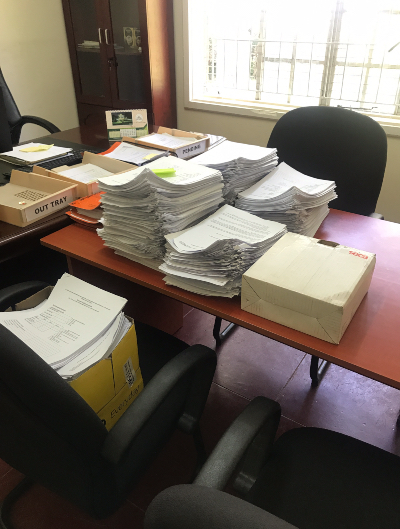
I am writing this as I sit on the plane on the way to Nairobi to meet my parents and sister for our family vacation, which marks the end of my work here in Kenya. This past week has been a whirlwind, full of wrap-ups and goodbyes. We spent both Monday and Tuesday doing more data entry. Louisa roped in a few poor souls to help us, so we trained people in our database both days and then they helped us whittle away at our mountain of surveys. After Monday, we realized that it would be possible for us to finish before we left, so Karissa and I were bringing home stacks of surveys each night to enter at home as well.
Erica's blog
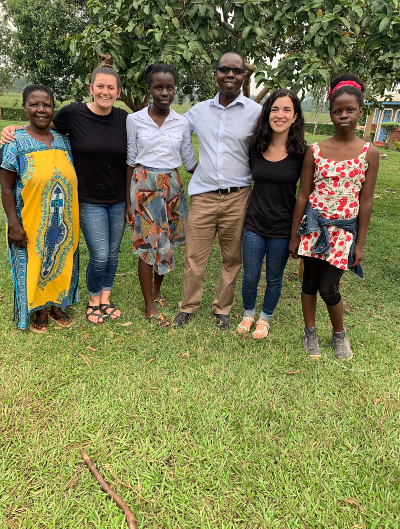
On Wednesday, Patrick took the two of us to his village to see his childhood home and visit his mother. Micha and Morna both joined us, and the 5 of us drove the hour and a half to the village. Upon arrival, Patrick’s mom gave us the biggest hug and sat us down for a huge meal. Patrick also took Karissa and me for a little walk around the village and pointed out land where some of his relatives live and places he was farming or working on projects. His mother’s compound is really beautiful with a huge grassy yard and greenery all around. We also got to meet Patrick’s youngest sister and his niece who both stay with his mom.
Erica's blog
Karissa and I spent Thursday morning doing data entry, and then in the afternoon Dr. Bailey came to Maseno for a wrap-up meeting with Pauline and Louisa. We discussed plans for analyzing the data and how we will disseminate it. Overall, the five of us were very pleased with all that we have accomplished over the summer. After work, I stopped by Karissa’s house to say goodbye to Doris, her housekeeper. She has been the person who was around at Karissa’s house the most this summer, and she has been so, so kind to me so I was sad to say goodbye. Thursday night, Hera, my 15-year-old host sister came home from boarding school and their family friend, Monica, was visiting after graduating from school with a teaching degree. Grace made homemade fries, chocolate cake, and ice cream as a “thanksgiving” dinner because she was thankful for Hera being home, Monica graduating school, and for me spending the summer with them. It was such a sweet surprise. After dinner, the girls and I all squeezed onto the couch and watched some Netflix together.
Erica's blog

Friday was our last day of work. Over the course of the morning, Karissa and I were successfully able to complete all of our data entry! This was a HUGE accomplishment considering the fact that we collected about 600 surveys in total. We were so excited to finish before we left because we didn’t want to burden the Maseno team with leftover data entry as they moved on to the next phase of the project. We also tied up a few loose ends and did some final wrap-up to ensure that everything was ready for the Maseno team to continue with the project once we left. Mid-afternoon, Pauline’s driver took us into Kisumu for a late lunch with her, Lousia, Louisa’s daughter, Olympia (another SPH faculty), and Chi Chi (Karissa’s host brother). We went to a delicious Indian restaurant and enjoyed a massive feast. We spent a few hours at the restaurant, eating, chatting, and enjoying each other’s company. They even gave Karissa and me gifts and really nice cards. After eating, we said our goodbyes and made our way back to Maseno. Karissa stopped by my house to say goodbye to my host family (and to me). It was so sad and weird to say goodbye to her after having literally spent every waking moment of the past two months together. I am so grateful to have been able to have her in Maseno with me for this experience. We got so close over the summer and I really could not have done it without her friendship and support. After she left, Grace and my host family gave me the sweetest goodbye gifts. They gave me a notebook in which they had written some Luo words, and Hera added a calligraphy design with my name to it. They also gave me some earrings, woven hot pads, and throw pillow cases that Grace had handmade for me. Micha even wrote me a card that said, “I miss you. Your the britistest star in the sky. Bye! :)” It took all my willpower to hold back the tears.
Erica's blog
I got up very early on Saturday morning to say my goodbyes to Grace and the girls before Patrick took me to the airport to catch my flight. I really cannot believe the summer is already over and that I lived in Kenya for over two months. It has been an invaluable experience that was both challenging and amazing, and I am so incredibly thankful for my host family, the Maseno team, Dr. Bailey, and Karissa. I don’t think I could have made it through without each and every one of them. Combined, they created an incredible support system not only for the project, but also just in general. I am so proud of the work we did and the amount we accomplished in our short time here. I have learned more than I thought possible and gained a new family on the other side of the world. I know I’ll be back in the future, so it’s not goodbye, Kenya, it’s see you later! Asante sana (thank you so much)!
Sam Dorevitch Bio
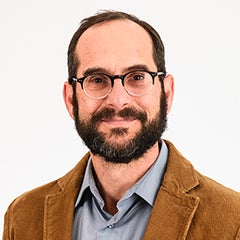
Dr. Samuel Dorevitch works in the Environmental and Occupational Health Sciences division of the UIC School of Public Health, and is working in Kisumu, Kenya for the summer of 2019. Dr. Dorevitch’s research interests include waterborne illness, indicators of water quality, developing innovative methods for measuring pathogens in water, communicating environmental information to the public, and asthma and obesity among inner-city residents.
Sam Dorevitch's blog
Sam Dorevitch's blog
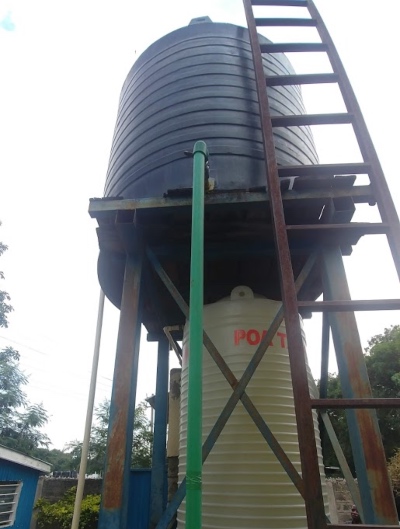
Chicago and Kisumu, Kenya have a lot in common. First, both are on a “Great Lake” – Kisumu is on Lake Victoria, which is actually bigger than Lake Michigan (in terms of surface area). Second, there’s a lot of UIC SPH research going on in both places. As a member of the EOHS faculty, I’ve been doing environmental health research in Kisumu for almost three years, and I’m there now working on several projects. One of the best part of the projects is that UIC SPH students are involved. This summer, two MPH students, one from EOHS and one from Epi-Bio, have been working on a project that will provide clean drinking water to residents of peri-urban informal settlements (“slums”) who don’t have access to safe drinking water. In partnership with an incredible non-governmental organization (the Safe Water and AIDS Project, or “SWAP”), we’ve set up a water treatment unit (see photo) and are ironing out some of the details now. Yesterday, along with folks from SWAP, and a UIC colleague from the College of Nursing (Dr. Crystal Patil), we visited a local water utility to learn about their experience with community-managed water systems. Today we met with officials from the Ministry of Health and updated them on the status of the studies we’re doing, and to receive their input on the water treatment study.
Kisumu is a terrific place to work, and SWAP is a fantastic NGO partner. For students with an interest in Global Health, think about exploring possibilities for doing research here.
Christine Fukuda Bio
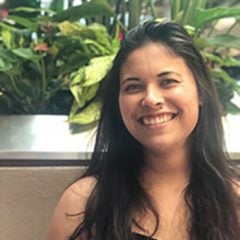
Christine Fukuda, MPH in Epidemiology ’19, traveled to Kisumu, Kenya during the summer 0f 2018. She supported an observational study nested within a larger randomized controlled trial investigating the impact of menstrual cup use in school age girls. The project was recently implemented in April of 2018 and is examining the effects of menstrual cups on the vaginal microbiome, STI susceptibility and sexual behaviors.
Christine Fukuda's Blog
Christine's Blog Post
Three flights, two animal excursions and one massive traffic jam later and we finally made it to Kisumu! The trip there was relatively uneventful (which is probably a good thing) however we did hit a high note right at the start as we were upgraded to Business Class for our first flight. Unfortunately, this was the shortest flight of the three, so the luxury was short lived but definitely thoroughly enjoyed. After another 20 hours of traveling we landed in Nairobi. Chief (friend of Dr. Bailey’s) picked us up from the airport and brought us back to his house for a huge home cooked meal including barbecued chicken, beef stew, vegetables and chapati (Kenyan flatbread/tortilla). Stomach’s full, we very gratefully passed out.
The next morning, Chief took us first to the David Sheldrick Elephant Orphanage in the Nairobi State Park (fun fact: it’s the only state park located in a large city in the entire world). The elephant orphanage houses over 20 young elephants (ages 5 and under) that were rescued from a number of different circumstances, including drought, poachers, injury, etc. Once the elephants graduate from the orphanage, the shelter begins to reintegrate them back into the wild. Until then, the park opens up for one hour each day to show the baby elephants off to the public. In two groups, the elephants come bounding into the watering hole area and immediately swarm the caretakers for large bottles filled with a formula type mixture. Once they’ve drank these down, they mosey around the watering hole area (surrounded by us tourists) and start splashing in the puddles, snacking on branches, and throwing dirt on themselves – classic toddler stuff. The elephants are also very accustomed to humans by now and would walk right up to us so and let us pet them and take selfies and all that. Carrie and Tiffany in our group also enjoyed the unique experience of standing directly behind one of the elephants as it passed gas. It was definitely one of the more comical moments of the morning.
.
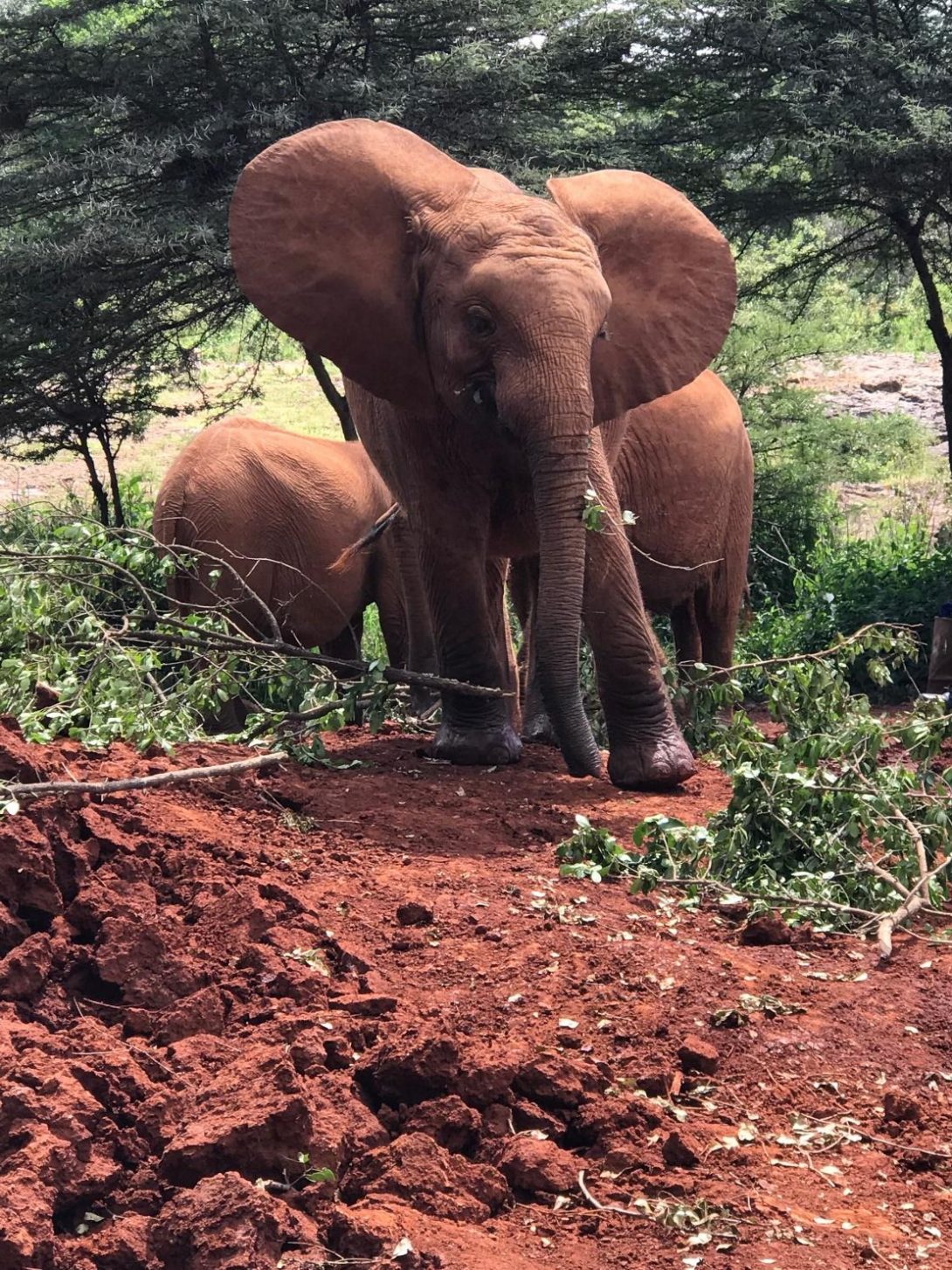
After the elephants, we headed on to the next animal center; Giraffe Manor. Here we saw, you guessed it, giraffes! We were each given a handful of pellets to feed the 5 or 6 giraffes that were all anxiously awaiting their treats. The giraffes were definitely used to this set up because they would position themselves between two people with treats and switch off, quickly snatching pellets from each person. Honestly, it was hard to keep up. We were also informed that a “fun” thing to do is to put a pellet in your mother and have the giraffe “kiss” you for the treat. Not wanting to miss out on the experience, we all dutifully approached our giraffes, pellets in our mouths and accepted the slobbery sand paper-y giraffe smooch.
.
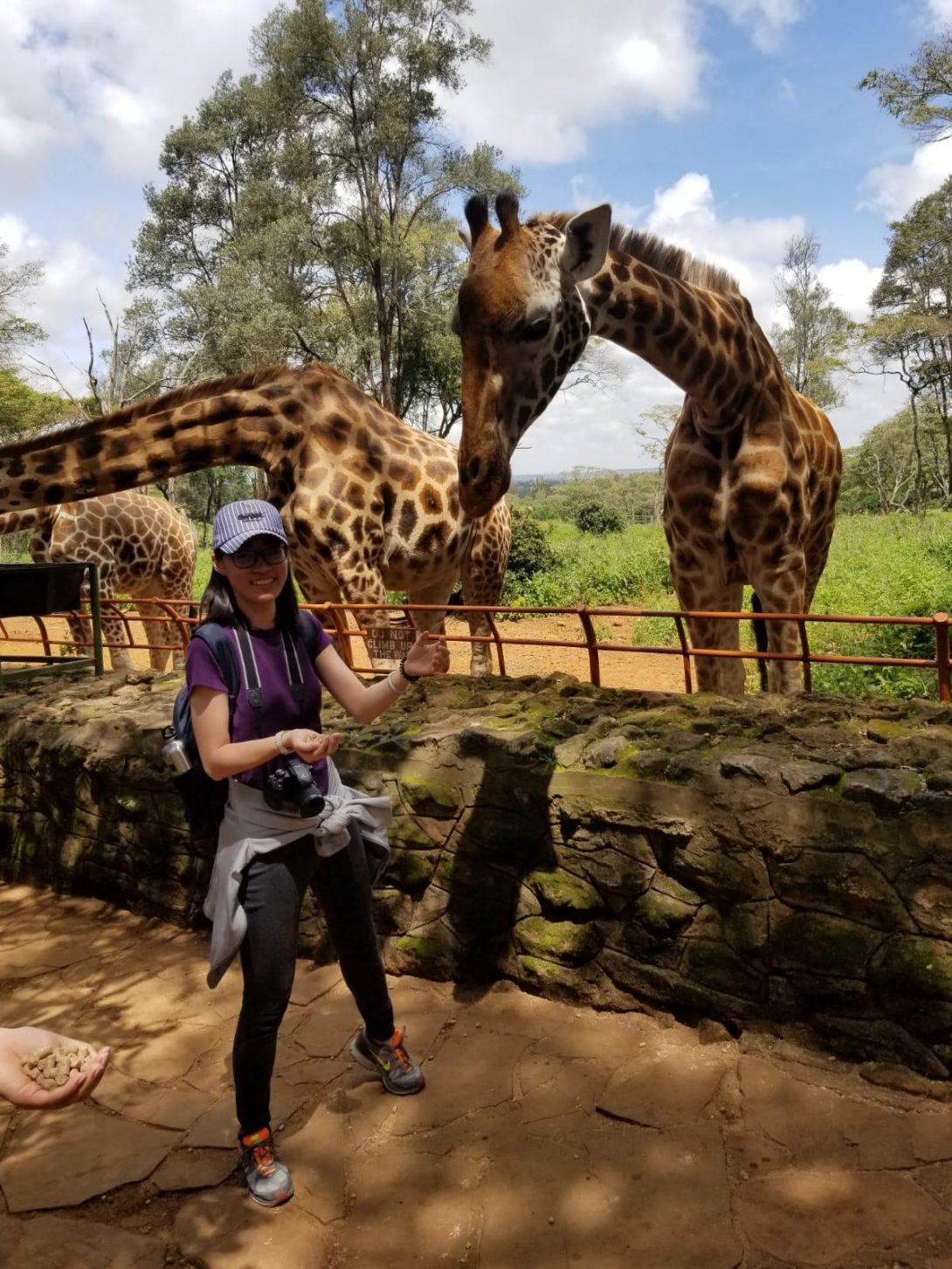
Giraffes in Nairobi
.
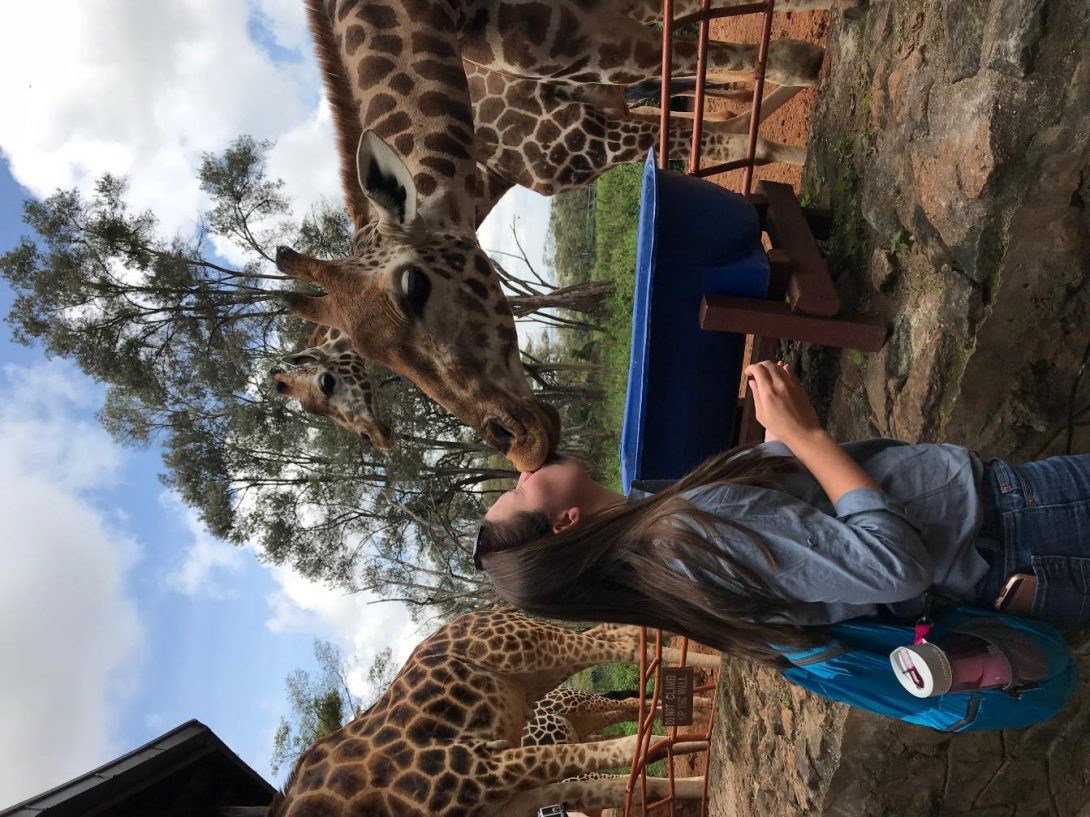
After stopping at the mall to withdraw money and get SIM cards we headed back to Chief’s house. That night we played cards and sampled Kenya Cane (Kenyan alcohol distilled from sugar cane) and taught Chief and his friends and family a few new games. After another delicious meal of curry chicken, mashed potatoes, fried rice and ugali we called it a night. The next morning, we left for Kisumu bright and early at 7am to avoid traffic for the holiday (celebrating Kenya’s independence from colonization). Turns out leaving at 7am doesn’t help if there is a massive multi-mile road block stopping traffic an hour outside of Nairobi. Traffic was so backed up that people had parked their cars in the street and were walking around outside trying to figure out what was going on. Cars also created new lanes of traffic in oncoming traffic lanes, in the ditches on the side of the road and in the surrounding forest areas near the highway. After fighting our way through alternate traffic lanes for two hours, we finally emerged from the forest and made it to the other side. Six hours later, we arrived in Kisumu where we’ll be spending the next two months. Now that were unpacked and settled in, it’s starting to feel like the summer has actually started and we’re maybe on our way to being less like tourists and more like (temporary) residents…maybe. Looking forward to exploring Kisumu and starting work on Monday!
Christine's blog post
We’ve now been in our new home for almost three weeks and we’re finally getting familiar with the neighborhood and city center. All six of us are living in a neighborhood called Dunga, which is about 10 minutes from the city center and is situated right on Lake Victoria. We are all living less than 2 minutes away from each other, however myself and three others are all in one home together with our host parents, Betty and Kolya, Betty’s sister Dinah, Evelyn the housekeeper/cook, Steve the gardener, and the two pups, Snowy and Sally.
.

Our house is right on Lake Victoria, which means that in the evenings our backyard plays host to a few of Lake Victoria’s residents….hippos. Yes, hippos are some of the most dangerous animals out there, however the few times that we have actually seen them, they’ve been pretty preoccupied with eating and very uninterested in us. Our host parents are more frustrated that they eat their plants than concerned about any run-ins, but we’ll still be keeping our distance just to be safe.
.
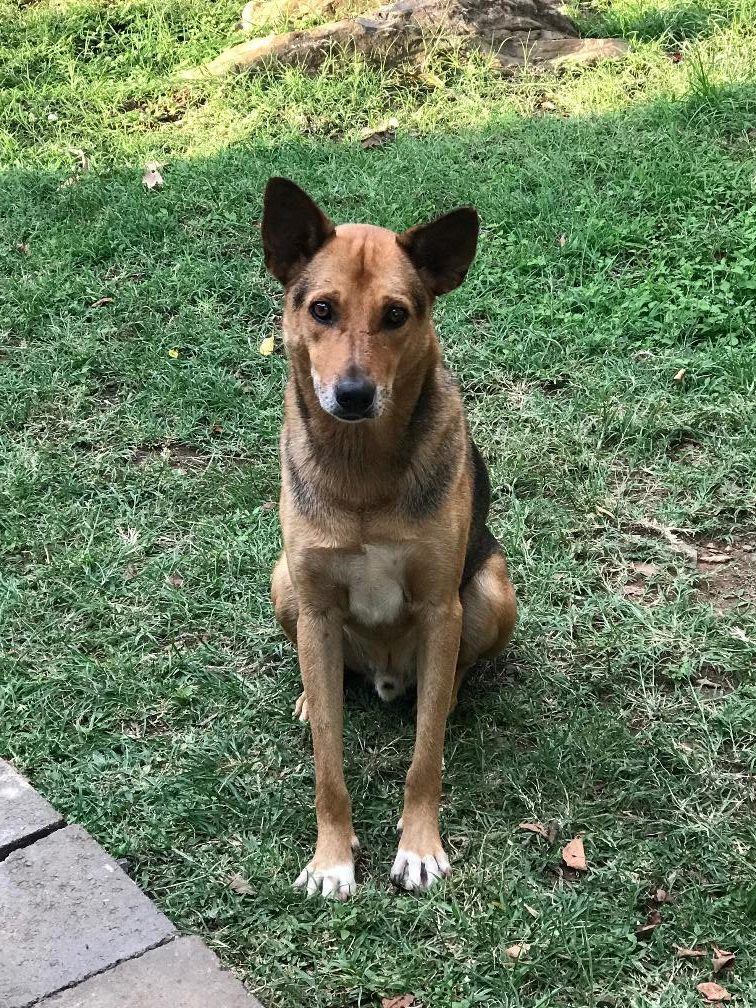
Our neighborhood is mostly residential with a few exceptions. Betty took us around town for a mini insider tour of Dunga and Kisumu the other day. She showed us a few neighborhoods that we haven’t been to yet in Kisumu as well as the common locations for social gatherings and/or protests (Betty is a women’s rights and sexual violence activist so she’s familiar with the protest scene).
.

Busy matatu (bus/van) station in the city center.
.
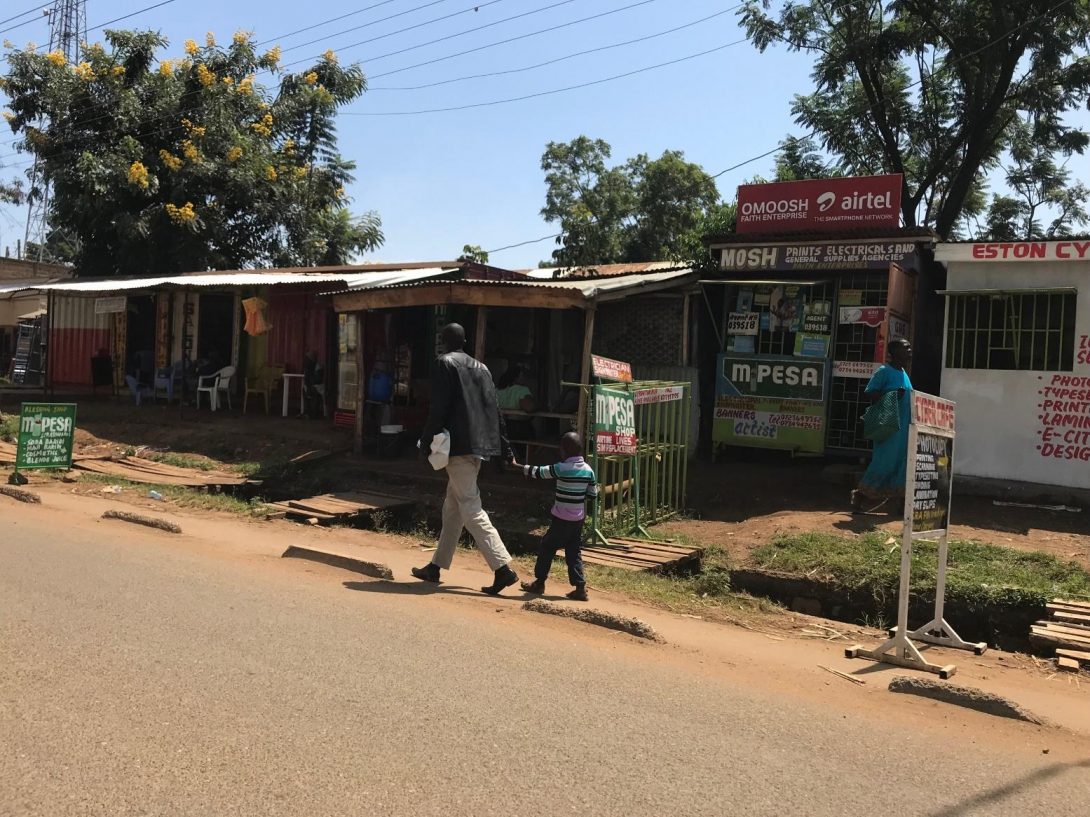
Back in Dunga, she took us down the street from our house to a huge fish cooperative. We received a personalized tour from a friend of Betty’s of all the happenings in the co-op. Our guide walked us through the various types of fish that can be caught in the lake. The big two are Tilapia and Nile Perch but they also have others including small anchovy like fish and catfish. Every morning the fisherman bring in their catch from the previous night and sell it at the co-op, where it is then prepared and transported to various markets for consumer sale. The fish can be sold fresh or frozen, dried or fried. We saw all three processes happening at the co-op and even sampled the fried variety. Not bad!
.
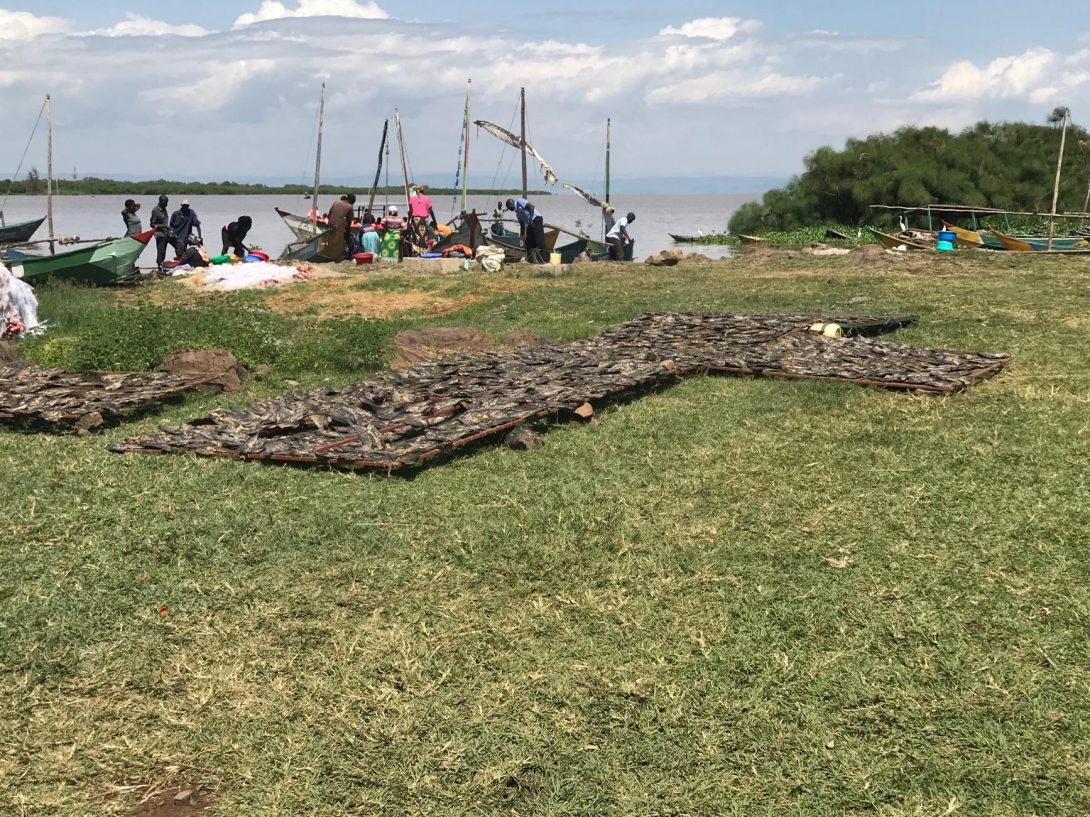
Fish drying out in the sun
.
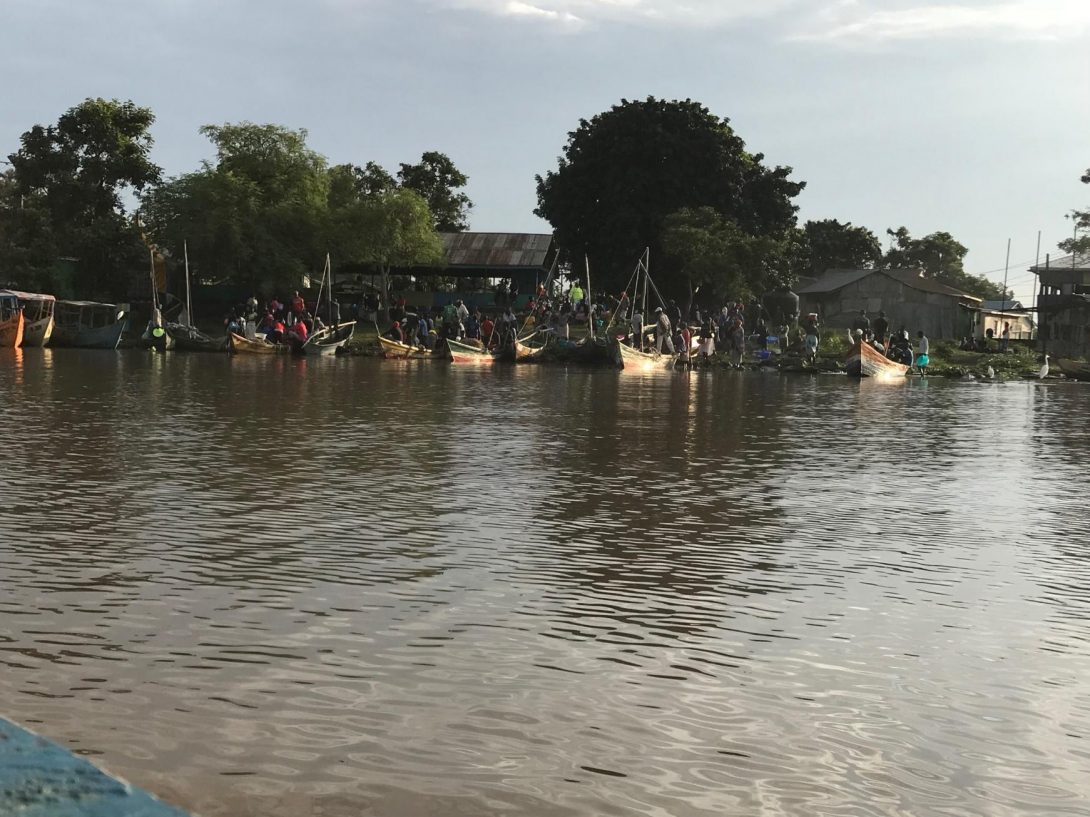
After we finished up at the co-op we headed to Dunga Hill Camp for lunch. This is a restaurant/bar set on an actual hill that overlooks the lake. We found that they have $5 pizzas here so I’m sure we’ll be back frequently.
Kisumu has definitely started to feel more like home but there is still much to see and learn! Additionally, one thing that we are definitely still getting used to is the attention received from being a mzungu (Swahili term for foreigner). Everywhere we go in Dunga or in town or literally anywhere, we can count on at least one (usually more than one and most especially little kids) shouting “mzungu! mzungu!” followed by “howareyouu?” (yelled as a single word) as we pass by. We also noticed that we are often recognized by people in unexpected places – i.e. the gas station attendant, grocery store security guard, etc. The attention and recognition was a little unnerving at first, but we soon realized that this comes with the territory of mzungu-hood and we’ve come to embrace it. We also realized that we actually react in a similar fashion when we see other mzungu’s that we haven’t met yet, although we try to keep our ‘mzungu howareyouu’ exclamations to a minimum.
.
Three posts and 7 weeks in, I suppose I could talk about why I’m actually here! I’ve been working at the UNIM clinic in Kisumu on the Cups and Community Health (CaCHe) Studylead by UIC’s Dr. Supriya Mehta.UNIM clinic is a part of the Nyanza Reproductive Health Society along with Anza Mapema and is a hub for various research projects as well as clinical services. UNIM provides infant and adult voluntary medical male circumcision (VMMC) services as well as STI testing and counselling. The CaCHe study is just one of the project supported by UNIM’s staff and laboratory team.
.

Community Health educational mural
.
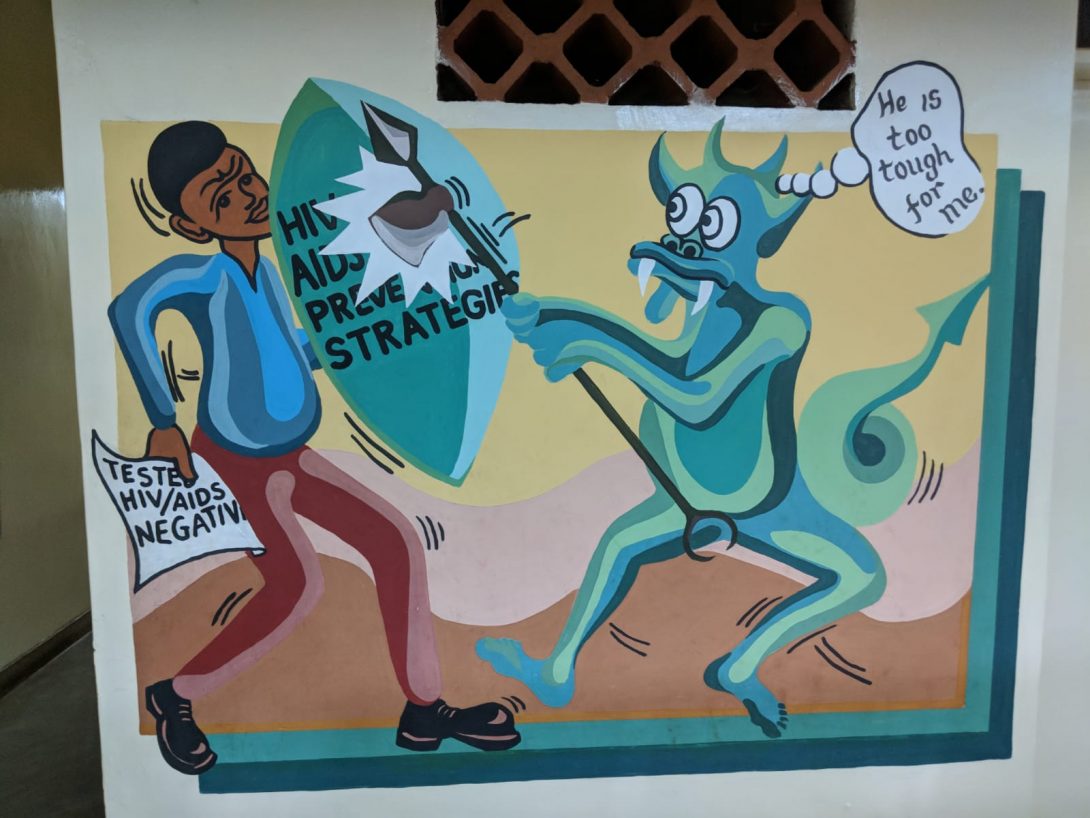
The CaCHe study is a sub study of the Cups or Cash for Girls (CCG) randomized trial. The CCG study includes high school age girls in Siaya county(rural Western Kenya)and aims to find ways to improve girls’ attendance and retention in school due to issues associated with menstruation. The study has four arms: cash transfer -girls receive 1500 Kenya shillings or $15 per term to be used for any purpose, moon cups –girls receive a menstrual cup, combined -girls receive moon cup and cash transfer, and control –girls receive menstrual hygiene education (included in all study arms). The CaCHe sub study operates only in schools in the cup or control arm and the study aim is to determine if using a menstrual cup impacts the vaginal microbiome such that it impacts susceptibility to STIs. Additionally, in many low-income areas, menstrual hygiene management (MHM) is a large concern and acquiring menstrual products can sometimes involve coercive or transactional sex. Therefore, this study also aims to examine menstrual cups as a sustainable menstrual hygiene product and its impact on sexual behaviour such as sexual debutand number of sexual partners. The study involves school visits that take place in 6-monthintervals and consist of Health Days, trainings and Results Days. Health Days include nurses and community health workers from KEMRI (Kenya Medical Research Institute) as well as staff from UNIM. On these days, the girls are introduced to the study and are taken through the process of informed consent. The girls undergo blood testing for HIV and HSV-II and then take four self-collected vaginal swabs for BV, Trichomonas, Chlamydia and Gonorrhoea. Following the visit, a field team operated by SWAP (Safe Water and AIDS Project) comes to the school to implement the study arm. For cup schools, the girls receive education regarding puberty and MHM as well as the three bars of soap, the menstrual cup itself and training on how to use it. For control schools, the girls receive education regarding puberty and MHM and three bars of soap. The third visit involves dissemination of results and from the samples taken on Health Dayas well as any required treatment. Follow up testing will continue to take place every 6 months for a two-year period.
.
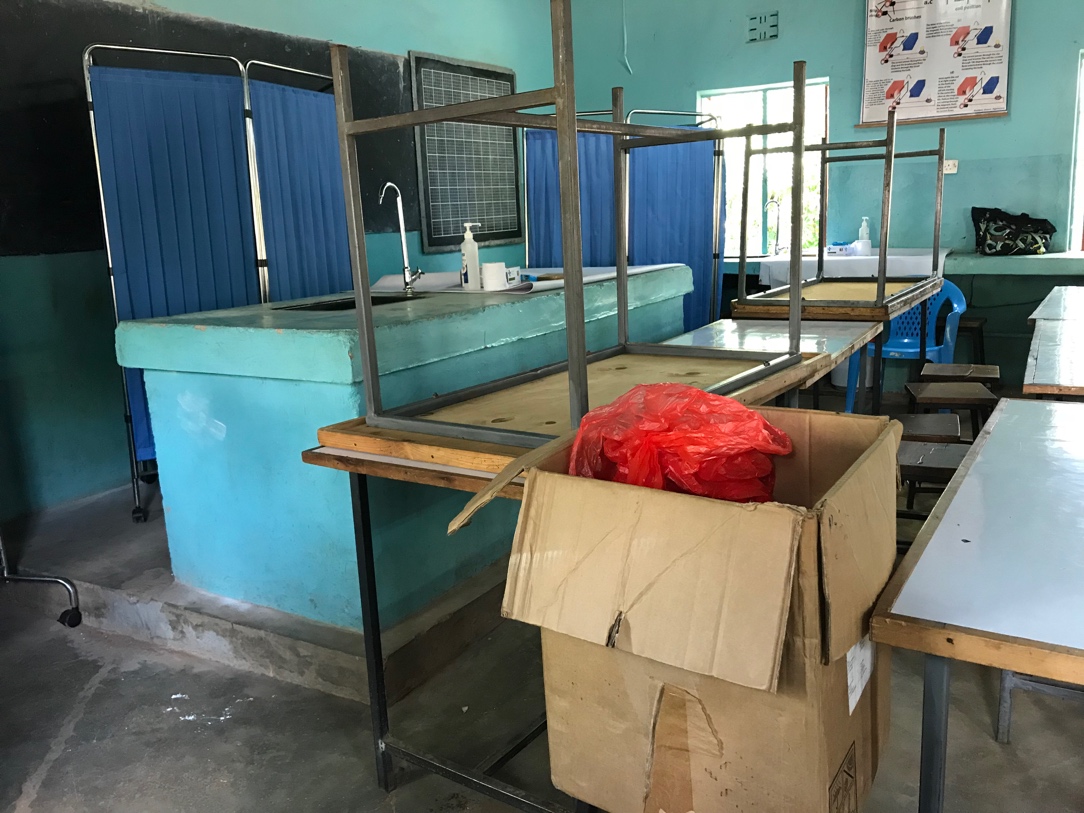
The CaCHe study started recently with the baseline visits in May.When I started here, they were finishing make up Health Days or Mop Ups. I had the opportunity to attend a few Health Day mop ups and attend two of the SWAP training. We are now moving into the results dissemination and will continue that process this month. As well as attending field visits, I have been helping to create and manage the databases for the incoming study data. I am learning a lot and definitely enjoying my time here. It has been exceptional having the opportunity to go into the schools and observe the project first hand. This has also been a great opportunity to fully appreciate the importance of this study and the extent of the potential impact that the results could have on menstrual health management in Western Kenya and beyond.
Carrie Nacht Bio
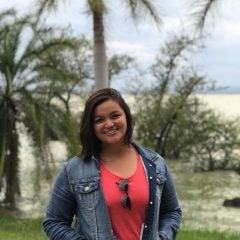
Carrie Nacht, MPH in Epidemiology/MBA student, completed her fieldwork in Kisumu, Kenya working at the Nyanza Reproductive Health Society at the UNIM clinic. The project she will be working on focuses on anti-microbial resistant strains of gonorrhea in patients around Kisumu, aligned with her career aims working in sexual and reproductive health. Carrie spent her spare time in Kisumu staying active with her housemates, catching up on reading, traveling around Eastern Africa and attempting to learn Swahili.
Carrie Nacht Blog
Carrie's blog post
This summer I will be participating in the Kisumu, Kenya program that is run through UIC’s Global Health Practicum. I chose this placement for the simple reason that it is everything that I wanted in my field experience. I am enrolled in the Global Health Program, so this fits the global requirement needed for my field experience. I additionally plan to pursue a career related to sexual/reproductive health, so working at the Nyanza Reproductive Health Society (NRHS) fits perfectly into my personal goals. I also have experience working internationally and plan to pursue that in my future career, so going to Kenya to work fits well.
Before getting to Kisumu, we flew into Nairobi where we did a lot of fun excursions for the day that we were there. We went to the David Sheldrick Wildlife Trust & Elephant Orphanage to watch the baby orphan elephants get fed and hear the stories of how they arrived in the orphanage in the first place. The orphanage operates by finding abandoned elephants around Kenya and the surrounding countries and helping them get back on their feet. Elephants need to be nursed for 2 years, so if their mother dies they often die. So this organization created a formula meant to mimic their mothers’ milk and feed it to them until they are properly grown. They then proceed to introduce the elephant orphans back into the wild, until the elephants are fully independent and can survive in the wild on their own. The entire process takes somewhere between 10-15 years.
.

After the elephant orphanage, we went to go feed the giraffes at The Giraffe Centre. It was so fun! Giraffes are massive creatures and extremely intimidating when you’re standing right beneath one. They’re definitely well-trained on how to eat out of your palm, they just dip down and scoop up the pellets of food, leaving a lot of saliva behind. And, much to the dismay of my mom, I also tried feeding the giraffe a pellet of food out of my teeth.
.

Giraffes in Nairobi
Carrie's blog post
This past weekend, we went to visit the islands on Lake Victoria, which is the pride and joy of a lot of Kenyans. I have heard “Lake Victoria is the second biggest lake in the world!” at least 10 times in the past month.
The journey was half the fun. The first leg of the journey was taking a matatu (bus) from downtown Kisumu to the Luanda Kotieno Ferry. We finally experienced a matatu and it was just as fun as everyone described: it is meant to fit 15 people including the driver, but we had 25 individuals in the bus for the hour and a half ride. There was no live poultry, which is apparently unusual; often there are chickens in the van, or else on top of the roof.
.

Matatus are the bus above, which operate by filling the vehicle with as many people as possible and dropping them off wherever they want on the way to the final destination. They also pick up people whenever there is an open seat to maximize how much money they can get on one ride. There is a guy who takes fares, tells the driver when to stop, and recruits people to get on the bus. He often opens the sliding door and hangs out the side of the van while the van is driving to see if anyone wants to get on the van. These buses top out at 100 kph/60 mph!
Upon arrival in Mbita, we stayed at Bimoss Beach Resort & Campsite, which sits right on Lake Victoria.
.
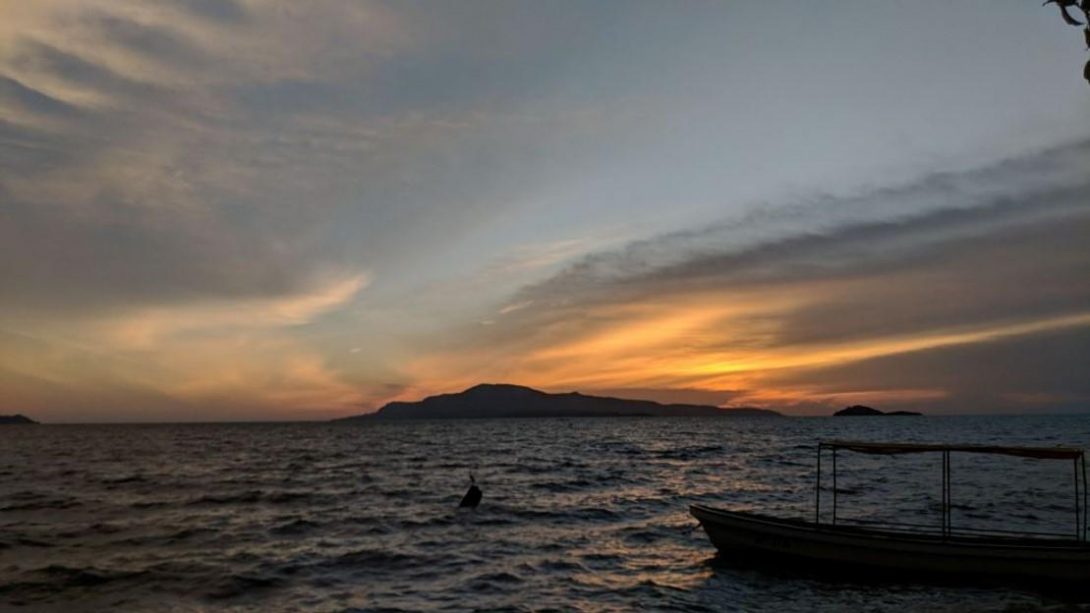
Sunday morning we started off the day with breakfast and a boat ride. We went out and saw these islands in the lake that are only inhabited by birds. Johannes, who drove the boat, said it was called the Lone Planet, Bird Island, or Basa. The island was swarming with egrets, hammerheads, king fishers, and even a few eagles. We also saw a few monitor lizards, and had an encounter with a cobra in the water that was a little too close for comfort!
.
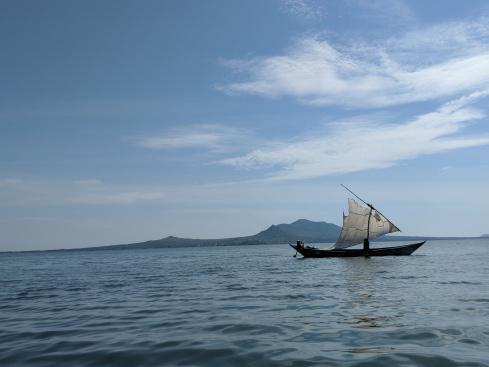
Lake Victoria
.
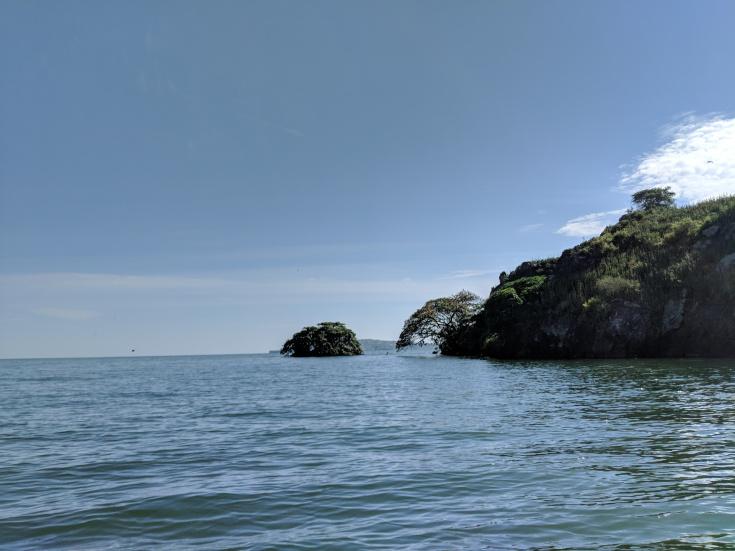
Beautiful views
Nicholas Davis Bio
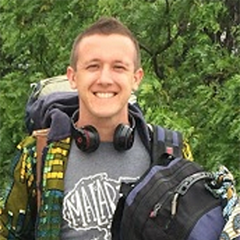
Nicholas Davis, MS in Epidemiology ’18, traveled to Kisumu Kenya in the summer of 2017. He worked at the Nyanza Reproductive Health Society (NRHS) with a project called the Anza Mapema Study. Anza Mapema is a project that focuses on the sexual health of gay and bisexual men who have sex with men in Kisumu and the surrounding region. This project will include linking HIV-positive MSM to care for HIV, including antiretroviral therapy (ART) and provide ART adherence programs to encourage the continuation of therapy. In addition to working with outreach and adherence programs, Nico will be working with staff to diagnose and treat STIs other than HIV.
Nicholas Davis Blog
Nicholas' blog post
Today we explored the Nairobi area with our host, Chief, and his wife, Vickie. They took us to an orphaned elephant sanctuary where they are raised and reintroduced into the wild after 2-3 years. The first picture shows some of the orphans playing in the water/mud to stay cool. We saw a total of 18 elephants, and one enjoyed himself by throwing water on anyone that he could. Afterwards, we went to a giraffe sanctuary where we were up close and personal with some of the residents. As you can see in the picture, it was very up close and personal for Ed and I. Ed was the oldest and largest giraffe, and he apparently loved kisses.
Afterwards, we went to a mall with Chief where we got sim cards for our phones and had a nice lunch outside. After lunch we all went up to see a gorgeous viewpoint of Nairobi. This city is very large, and has some really neat buildings. I have really enjoyed the past day, but am excited for the 6 hour drive to Kisumu tomorrow. I will spend the next 2 months in Kisumu with a family and working at an HIV clinic. That is all for now, but keep following. We will begin work at the clinic on Monday. I will try and post 2-3 times each week with pictures in every post.
Thanks for following, and keep up. I will begin posting more frequently.
Nicholas' blog post
Karibu, which means welcome in Swahili. Finally in Kisumu, but more specifically Dunga. It is a small fishing town on the outskirts of Kisumu’s bustling streets. Two other UIC students and myself are living with a wonderful woman named Betty. She is originally from Nairobi, but moved to Kisumu about 22 years back. In the picture you will see Betty’s house. It has a wonderful kitchen and living room. Behind it is a guest house where the 3 of us are staying with another Kenyan college student as well. We each have our own bedroom and between the 4 of us there are 2 bathrooms. It is more than an RPCV (Returned Peace Corp Volunteer) could ask for. It is quite amazing to stumble into a different lifestyle of East Africa from the Peace Corps life. All of us share the kitchen and living room. There is also a garden to the right of the house where Betty grows Papaya trees, amaranth, kale, and beans. The giant mango tree to the left is producing phenomenal red mangos at the moment. We also have a guava tree, passion fruit tree, and ata tree. I haven’t had ata in years, since Moçambque. If you are curious what ata looks like, google sugar apple of east Africa. In terms of food, we eat breakfast and dinner together in the main dining room. To the right of the picture, behind the tall reeds is Lake Victoria. I will keep this post short and sweet. Tomorrow we start work at the health center. Thanks for following, and keep up with the posts to come.
Our first night in the house, we were talking to Betty and heard loud grunting. As we all looked out the window, Betty calmly said that we have hippo visitors that come into the yard a few times each week. We looked and looked but could not see a thing. We continued to hear the grunting. Betty informed us that the hippos are very docile unless they have a baby with them. We typically leave them alone, unless they get into Betty’s garden. This is when Betty pulls out the good ole, trusty flashlight. She said that a few good shines at the hippos and they go running back through the reeds and into the lake. In the picture you can see that the garden’s fence has been crushed under the weight of a hippo. They apparently love papayas, but so does Betty. The roof on the other side of the garden is our guest house. There are a plethora of birds, baboons, and other animals. Check back later, as I will blog about animals as well. Once I get some good pictures, I will expand my writing.
Nicholas' blog post
Today was my first run while in Kenya. It reminded me of my marathon training in Moçambique. The hilly, dusty roads were quite a way to make me feel… well… not quite at home. I ran 2.5 miles out through some neighborhood roads, then ended up near the local fish market. The view of the picture is what I looked at while I was halfway through my run. You can see the boats to the right and market on the left. Lake Victoria is 2nd to only Lake Superior. This means that I have lived on 3 of the worlds largest lakes. Lake Michigan, Lake Malawi, and Lake Victoria. The run was very peaceful, except for dodging the herds of cattle that wander the dusty streets of Dunga. The children were all walking to school, and I must have said “good-morning” and “Hello” at least 100 times. It was very nice to see how supportive people were of my jogging. Many would say that jogging is good for the health, and that they may join me one day soon. There apparently is a jogging group that I will be searching for while I am here. It would be nice to train with some others. I will keep everyone updated on my running.
Nicholas' blog post
Work has begun. It is quite nice to be in a familiar environment again. Despite being in Kenya, the work day reminds me a lot of Mozambique. The low stress environment with a lot of laughing and smiles makes the day a pleasant one. I am working with an amazing group of individuals, and the goal of the clinic is to provide timely and reliable healthcare to the MSM (men who have sex with men) community. Many are HIV positive and many are HIV negative. Some abuse drugs, some abuse alcohol, and some do not use any substances. They are just ordinary men trying to get healthcare in social situations that do not allow them to live normal lives. Each individual has a story, and after the first 2 days I can see that the staff really care about who these people are. It is not just a job. It is an opportunity to work with a marginalized population in the community to promote growth and social stimulation. It is a chance to model their lives after the way they portray healthcare, an opportunity for everyone to be mentally and physically sound. It’s a chance to practice the foundations of public health with new colleagues in a new setting. I am not exactly sure what sort of details I can be sharing at the moment, so I will end the work blog. I will, however leave my followers with a rooftop view of Kisumu. It is a small, bustling city on the Northeastern side of Lake Victoria.
Nicholas' blog post
For now I will share a bit about the organization where I am working. The clinic is called Anza Mapema which is part of the Nyanza Reproductive Health Society. Anza Mapema is a clinic for gay/bisexual Men who have Sex with Men (MSM). Among the MSM community, HIV and other STIs are at high prevalences. The community is also marginalized by stigmatization and fear of living in the surrounding communities as a gay/bisexual male. These men that attend the clinic are provided superb care by a well trained staff. They are offered the opportunity to enroll in studies that ultimately can provide them with antiretroviral therapy (ARTs), STI treatment, and general health care. The staff is what makes Anza Mapema a success. They are hard workers with great communication skills. They are constantly walking around the clinic and asking each other questions. They are interacting with the patients as if they were their own brothers. You can see the compassion in each individual. As I continue my time at this clinic, I will share some more stories and photos. I have only been here a week, but I can tell that Anza Mapema will be a difficult place to leave at the end of July.
Nicholas' blog post
To the right we see a well shaded patch with space to sit a group of people. This is exactly what Anza Mapema uses this space for. Every Wednesday a group of 12-20 men gather in this space to battle their addictions to drugs and alcohol. I have had the chance to sit in and join for the past 2 weeks. Each individual brings a different aspect to the group. Some are quiet while some are loud. Many relate to each other, and some seem out of the loop. The group, however, runs smoothly and everybody gets the help that they need. Last week, the counselor discussed the idea of goal setting, and reaching the goals that one sets. We discussed the idea of a SMART goal. One that is Specific, Measurable, Attainable, Realistic, and Time-bound. Each individual was to write down 3 short term goals that would lead to a long term goal. Our counselor, Gottfried, has an amazing personality and is full of patience. He has the promise of helping each individual fight to achieve their goals. As I continue my 2 months here, I will be attending every coffee Wednesday, because I can see how badly these men want to move forward in their lives.
Nicholas' blog post
I was invited to train tomorrow morning with Palos FC, apparently one of the top soccer clubs in Kisumu, Kenya… I had absolutely no idea how good these guys would be. I was assuming that they were going to wipe the floor with me. Either way, I was excited to get some touches on the field with some top notch athletes.
These guys were really good. I am proud to say, however, that I held my own for the entire 2 hour training. The sun was very hot, and I had to play in regular gym shoes, but I had a blast. I was on the lower end of the spectrum, but mostly because of my fitness. My ball skills were among the top. When we played small sided, I kept up nicely. I fell behind when we switched to full field. They play a bit differently. They do not take their time. The style of play was attack, attack, attack. This was exhausting. I could not see them lasting through an entire tournament with that play, but then again they are young and in tip-top shape. Great experience.
There were 3 players that I really liked: Leone, Josh, and Solomon. These 3 had great personalities, and were very friendly. Leone was actually the one who invited me to join for the training. We played small sided keep away games with touch limits from 3 touch down to 1 touch. I had no problem showing off my skills. I was relieved to see that they would not be absolutely crushing me. My ball ability was well in the top range for their team. Large field play, however, was a different story. They made me feel 80 years old. Even though they are only 19-early 20’s, they were in much better shape than I. Marathon training has helped me to run long distances, but I can feel that my agility has slowly disappeared.
Take home of the day… marathon training does not equal soccer training!
Nicholas' blog post
This past weekend, I went for a weekend trip to Bujagali Falls in Uganda on the Nile River. Let me tell you… it was gorgeous. We left Kisumu at about 1:30am, took a motorcycle taxi to the bus stop, and hopped on the bus for Uganda. Around 4am, we reached the border and left the bus to proceed through immigrations. I was traveling with my friend, Amanda, and always forget that this is her first time on the continent. I sometimes forget to warn her of things that may seem completely unusual. In this example, Amanda got off the bus and was aggressively approached by a man speaking very quickly in Swahili. He was holding out a huge stack of cash. I could see Amanda’s confused look as she began reaching for the stack of money. I quickly shouted, “He is trying to exchange Kenyan Shillings for Ugandan Shillings.” She began to realize the situation, and we pushed on past.
We stayed at a river camp in dorm-style rooms. From the camp, we could see the Nile River in all of it’s glory. Down the hill was a rope swing attached to a tree branch. The very first day, we walked down and met a 17 year old boy named Alex. He was a potter from farther up the river. He had never completed school, and was now in the area teaching pottery to younger children. We had a blast over the next hour or so with Alex. We took turns swinging from the rope into the River. In the picture, you can see Alex and myself enjoying the rope swing. The following day, Alex showed up again. This time he opened up his backpack and handed Amanda and I gifts. He had given us items that he had made. I received a beautiful cup, as you can see in the first picture. He gave Amanda a necklace and a pair of earrings. I was floored. It was a genuine kindness that a person almost never sees in their lives. I quickly ran up to the room and grabbed a new deck of playing cards from Auburn that I had. Giving Alex money ran through my mind, but he clearly wanted them to be gifts. I ran back down and offered them to Alex. I told him about their significance, and he seemed thrilled. I only wish that I could have offered him more. This act made my entire trip worth it. The rest was icing on top of a well crafted cake.
Nicholas' blog post
Let me tell you about my friend, Kevin… The awesome guy next to me. Everyday at 7:00am, Kevin takes myself and Amanda to work. It is about a 25 minute ride from where we live. Our house is in an area called Dunga, and Anza Mapema is in a neighborhood called Tom Mboya. During the trip, we pass through dirt roads that are hazed by red clouds of dust. I began to enjoy Kevin’s friendship, so I decided to give him a gift. The pair of sunglasses that he is wearing. The gift was 2 part. #1 I really like him and wanted to gift him something #2 I could see him squinting through the dust as he drove us to work. I figured this gift would be practical, and literally may save my skin. Now, Kevin is a 26 year old that drives his boda boda about 10 hours a day, 7 days a week. He is a working man. Orphaned at the age of 10, Kevin jumped through a couple of local orphanages. He described them as a shelter with occasional food that let him get through life until he was old enough to begin working. He never finished school, but his English is wonderful. Everyday, I am expected to speak a new phrase in Swahili with him. If I don’t, he offers a 10 word sentence as my “word of the day”… I guess the word ‘word’ gets lost in translation… The other day, Kevin invited me to play some soccer with the other boda boda drivers. It was a blast. We spent about an hour just playing small sided soccer on the little dirt patch outside of the local school. This was much different and relaxed than the training with Palos FC. I was actually in better shape than every single one of the boda boda drivers. They are a fun group of guys, but I guess you would have to be in order to drive a motorcycle 10 hours a day. Word of the day- Boda Boda. A motorcycle such as seen in the picture.
2nd word of the day- Piki Piki. A taxi motorcycle which literally comes from the English word ‘to pick’
Nicholas' blog post
Anza Mapema is a clinic for gay/bisexual men in Kisumu, Kenya. They are HIV positive and HIV negative. They have quarterly visits with the doctors, and regularly get tested for sexually transmitted infections (STIs). Counseling is offered, and many group therapies are provided for the men. Why do we offer coffee Wednesday? First off, addiction is a disease. Whether it be drugs, alcohol, food, sex, etc. addiction is classified as a disease. Anza Mapema is a health clinic, and to offer its best services, the clinic must treat the disease of addiction. Every Wednesday, a group of approximately 20 men get together and discuss their addictions. Some talk, and some listen. The counselor, Godfrey, goes over the 12 steps of Alcoholics Anonymous. He gives an amazing description of each step. The men have taken it upon themselves to open up each session with the serenity prayer. They chose this, because it does not mention any particular religion or spirituality. It is a prayer for help. Everybody can relate to it. They are extremely open men. Addiction is a huge problem for them as well, not only because of the poor health outcomes. Many are on HIV medications, TB medications, or have sexual relations with people that put them at high risk. Their addiction, often leads to missed doses of medication, increased risky behavior, or forgetting to use condoms. This puts them at a very high risk of contracting a life changing disease. Anza Mapema helps them fight their problem, and to live the healthiest life possible. Each week takes these men a step closer to complete health. This is public health, and the work that we do. So cheers, to Coffee Wednesday!
Nicholas' blog post
Yesterday was a great reminder just how clueless we are in our bubble of a country. This is not meant to be a stab at our lives or the style in which we conduct ourselves. This is meant to be a moment of learning. We are not as progressive and forward thinking as we believe. We like to think that individuals from our country go to Africa as a way to teach people who need to learn some social or scientific construct. This is not the case. I am learning more here in Kisumu, Kenya than I am teaching. I was fortunate enough to attend a school assembly with hundreds of high schoolers. The entirety of the gathering was focused around the education about HIV/gender/sex/equality/social stigma. To me, one thing that social life in Kenya is great at doing, is stepping outside of the comfort zone. This is a country where individuals speak at least 3 languages. They are open and encourage foreigners to learn about their cultures, politics, strengths, and shortcomings. We, however, hold a large population who push against learning or utilizing any language besides English, value our own comfort over the lives of struggling individuals, and often forget about humanity. We forget that other, better countries exist in the world. We would never even imagine a developing nation that may be pushing the social progressive attitude farther than we could imagine.
The students discussed social stigma of gay, bisexual, transexual, HIV positive, and other individuals. They discussed the use of condoms, PrEP, PEP, birth control, and the role of media in stigmatizing populations who utilize these. This, to me, was amazing. I can’t even imagine the red tape that would exist to discuss some of these topics in a school of teenagers without enraging parents/leaders and “compromising the virgin minds of our youth”. Im not saying that we are bad. What I am saying is that we can use this as a learning experience. I am saying that if hundreds of high school students can listen to an hour and a half discussion about gender/sexual differences and the acceptance of individuals, then maybe we can normalize some of these as well.
ART – antiretroviral therapy used in treating HIV
Adherence – Consistently and regularly taking ART medication
Viral Load – The number of HIV viral copies in the bloodstream per milliliter.
CD4 – A specialized Thelper cell of the immune system that is brought to the front lines of tissue damage
Discordant Couple – When in a relationship, one person is HIV positive and the other is HIV negative
Washikaji – A peer with very high adherence that is trained to help other patients strictly adhere to their medication
Let’s move into a very public healthy blog post. I am going to tell you about the first ART Adherence Group Therapy session that I participated in. First of all, the above words are commonly thrown around in the public health world of HIV/AIDS. When an individual is diagnosed with HIV, they are put on ART in order to prevent the virus from taking over their CD4 cells, and compromising their immune system. When the immune system is compromised, and the level of CD4 cells drops below a critical level, the patient is often diagnosed as having AIDS. When a patient has HIV, the amount of viral copies in the blood stream grows from 10 to hundreds, to thousands, to hundreds of thousands per milliliter of blood. Being on, and adhering to ART will reduce the viral load of an individual to a point that we consider undetectable, or less than 20 copies. When an individual has an undetectable viral load, they are essentially not able to transmit the virus. It is not impossible, but the chances are extremely low. Therefore, if we keep patients 100% adherent to ART, then the chances of the virus being transmitted are extremely small.
Anza Mapema has nearly 100 men who are HIV positive. Many of these men have been very adherent to ART, and thus have undetectable viral loads. Many, however, do not take their medication. When they come back for testing, viral loads are regularly seen about 100,000 copies per mL of blood. Our counselor leads an amazing group of adherent and non-adherent men. These men work together and discuss their lives. They tell their histories, how they got HIV, how they work on taking their medication, and even what challenge they face. Many men feel stigma through their families and friends. The community is not always kind to HIV positive men. They are shunned for being infected, and are thus afraid to take their medication when others are around. Many do not like the side effects, or feel that they are perfectly healthy without ART. One individual stated that he used to run from his own shadow. He had been in denial about being HIV positive, and therefore neglected taking his medication. I have witnessed individuals too weak to walk, arrive at Anza Mapema and seek help. This group is extremely important. It is a safe zone where they can discuss and learn. They are not ridiculed or reprimanded for poor adherence. They are encouraged by the peers to use their medication. They help each other, and those who are extremely adherent are considered ‘Washikaji’. I remember one question that sparked my curiosity. Our counselor asked how many of the men were sexually active and in a discordant relationship. About 80% responded yes, and of them about 75% said they have disclosed their HIV status to their partners. This was sad, and also happy. It was so sad to see that ~25% of those men felt too stigmatized to disclose their status. I worry for the health of everyone involved. The happy side, however, is that 75% said they have disclosed their status and are still in a relationship! This is amazing. This shows some character of their partners. These men and women show true love. I hope that all of these men can focus on their medication adherence as a protection for themselves and their partners. I leave you with this, and hope that some public health has sunk in.
Thank you for following! Keep checking for more public health, running, and adventures!
Nicholas' blog post
Sorry for the absence from my blogging. We have had intermittent electricity and I have been very busy in the data side of my work. I will talk about this lifestyle in a separate blog. This blog, however, is to talk about Movie Monday. This week, we decided to show one of my favorite films. We screened the movie ‘Rent’, and held a short discussion afterwards. For those of you who don’t know, ‘Rent’ is a musical about drug addiction, living with HIV/AIDS, LGBTQ rights, and homelessness. It follows a young group of friends in New York City. I must admit, the film did not go over as well as I had hoped. They loved the story and found many of the social issues very relatable, but they found the idea of a musical to be quite dull. They were not very engaged with the music. It was a lot of fun to discuss the film, however. Many points were brought up, such as the lack of confidence among the LGBTQ community to dress how they feel. The group found it very exciting that an individual would feel comfortable enough to wear a dress, as a man. We explained many phrases and words that were new to them as well. ‘Drag Queen’, ‘Twinkie’, and ‘Hicksville’ being three of the memorable words.
Nicholas' blog post
Let’s go back to my Marathon training for a quick blog post. The past 2 weeks, I have run nearly 75 miles. I put in a 36-mile week and then about 39-miles the following week. This included a 13.1 mile run on Sunday. During my training, I have experienced a plethora of animals, with goats and cows being the most common. As we can see in the picture, the cows are very docile. They do not react to much. They often lay in the middle of the dirt road while cars/trucks/motorcycles zoom past. They run the show, and people treat them like royalty (since the cows are such a huge source of income). The goats often stare me down with their little eyes as they chew on some freshly picked garbage or grass. Once, while running sprints at the steepest hill I could find, I began to hear a deep, hearty roar. It was a lion! My heart nearly leapt from my chest before I realized the local ‘zoo’ called Impala Park was situated directly behind me. Fortunately, the lion is in a cage, and has never been known to escape… yet. I guess that in itself is motivation to run faster. I have 2 more weeks in Kisumu, and my running continues.
Nicholas' blog post
From what you have read, up until this point, I have been experiencing the world around me. I have been exploring the sights and sounds of Kenya. I have been training my body for the upcoming marathons that I will be running. I have been making friends and eating delicious food. Let me tell you, briefly, about the other side of Epidemiology. Since I have arrived, I have combed through 3 years’ worth of medical records for just shy of 1,000 individuals. I have been looking at dates, test results, treatments, the whole shebang. Every day, I open up drawers of files and drudge through the monotonous task. I have created enormous datasets looking at sexually transmitted infections and diseases. As I spend hours a day with my face crammed into a computer, I can only hope that the data extracted will be of some use.
Nicholas' blog post
Let’s talk a little about where I have been living for the past 2 months. We live in a small bay on Lake Victoria that is called ‘Kiboko Bay’. The name is very fitting, because Kiboko means hippo in Swahili. This is a very popular hangout for the hippos to spend their days. In the picture we can see 2 adults and a baby. The reason why these hippos are so special is because they feed in our yard on a nightly basis. After dark we can hear the splashing and grunting as the hippos enter our yard. We peak through the windows to see the group grazing on the delicious grass. They are our neighbors, and we treat them as such. Nobody chases them away, and nobody gets annoyed by them. They are welcome at the house. I take that back… the dogs are not fans of the hippos. Occasionally, the hippos wander too close to the house and the dogs go crazy. They begin protecting their territory and barking. It is quite funny because the hippos tend to ignore the 4 dogs. There has only been one occasion when I woke up at 2am to a fight between the dogs and a large hippo. I peeked out of my window as I heard growling and hippo grunts. I saw 2 of the dogs in front of the hippo while the other 2 nipped at its legs from behind. The hippo eventually moved farther away from the house and the dogs seemed content. Regardless of the situation, the giant hippo did not seem threatened at all. It seemed annoyed that these pesky dogs were bothering its meal time. All in all, the kiboko are quite nice neighbors.
Nicholas' blog post
Let’s jump into the adult stuff. These infections are more common than people would like to admit. Many individuals feel shame or major embarrassment when presented with the topic. Sexually Transmitted Infections (STI) include, but are not limited to, chlamydia, gonorrhea, syphilis, HSV2(genital-herpes), HPV (Human Papillomavirus), genital ulcer disease, and trichomoniasis. At Anza Mapema, I have been extracting data on sexually transmitted infections among the men in the study. I will be running a number of analyses on the data dealing with diagnosis, lab testing, and treatment. On the other side of the clinic, we have the staff who are very hands-on in the prevention of STI transmission. In the picture, you can see the boxes upon boxes of condoms that we have in stock. We routinely give participants and peer educators condoms for use and distribution among the MSM (men who have sex with men) community.
Prevention and timely treatment is key. I was fortunate to get my data gathered and to run a preliminary analysis. I made a 30-minute presentation to the clinic on the topic of diagnosis/treatment of STIs in Anza Mapema. I used the epidemiology skills that I have learned at UIC to integrate biostatistics with communication. I am hoping that the results I presented will be beneficial to the staff here in moving forward and improving the treatment of STI positive men.
Nicholas' blog post
Swahili of the day:
Kwaheri- Goodbye
Mpaka Baadaye- Until Later
Anza Mapema- Start Early
The last day at work with Anza Mapema. We had a feast! Amanda and I pitched in and bought food for the office. Everyone joined together and cooked an amazing meal. We had goat, chicken, fish, ugali, rice, chapati, sakumo wiki, and salad. I was basically forced to load up my plate with a mountain of food. I will say, I did not put up a fight when I was told that I had to eat it all. As you can see, it was quite a large amount of food. Of course everything was delicious.
The fish, however, was phenomenal! After lunch, we were surprised to see that everyone had pitched in and bought us a cake and a couple of bottles of champagne. The cake was covered with a passion fruit frosting and halved passion fruits. It was delicious, until Violet decided to take a glob and spread it across my face haha! After that, it was an all-out frosting war. Even Dr. Bailey (UIC professor and advisor) was wearing some frosting on his face. It was quite the last day of work. Many of our coworkers had some very nice words to say. We thanked everybody for their hospitality and the amazing experience that we gained from them. In the group picture, you can see that we are quite the amazing group of people! Thank you, again, for everything. My time here is almost finished, but my work with everybody at Anza Mapema is just beginning. I will be working closely with everybody as I begin writing my thesis proposal for my MS epidemiology program.
Obehi Ilenikhena Bio
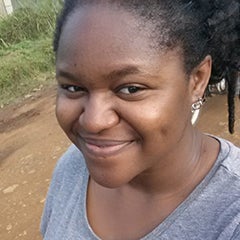
Obehi Ilenikhena, MPH in Environmental and Occupational Health Sciences ’18, completed her fieldwork in Kisumu, Kenya. She worked for the Safe Water and AIDS Project (SWAP), which seeks to improve the quality of life of the vulnerable in the community by building their capacities and supporting them to develop profitable health oriented micro enterprises. Her research covered implementation and evaluations of approaches used to improve access to safe and reliable drinking water in communities.
Obehi Ilenikhena Blog
Obehi's blog post
After leaving Nairobi at 8:30pm, we set out to the Western part of Kenya. You know the stereotypes you hear from people in the west as an African: “are elephants living side by side with you?” “Do you see lions everyday? Or do you play with monkeys?” Well, that is definitely not the case in Kenya or anywhere in Africa. However, I fell into that stereotype when I asked Chief, our host in Nairobi, on our car ride to Kisumu, if Zebras were considered pets. Well, he laughed and quietly said sure, “if you want it to be.”Of course, as an African, I can make this silly joke. Why? Because for a second, I was a tourist in a foreign land.
9Baboons, Zebras, donkeys, snakes, etc. were commonly found by the road side as we drove by to our destination. “Now, these animals are in certain parts of the area” as Chief stated, “in an hour, we will see baboons on the road.” And surely, that we did.
Anyways, animals were not the only attractions. We saw the Rift Valley and popular lakes, one of which is called Lake Nakuru. According to Chief, flamingos are common in those areas. After taking our oictures of the fantastic views, 2.5 hours into the ride, we stopped at a mall in Nakuru, called Westside Mall; not too far from the lake Nakuru and the Rift Valley. It is the hub of Nakuru, the fourth largest city in Kenya. A modernized, commercial mall in the heart of the Rift Valley. “Nakuru”means “dust or dusty place” in Maasi language.
Well, after our short stay (bathroom stop at a fancy KFC- Kentucky Fried chicken and Java House), we were back on the road. We saw different plantations, one in particular, tea. I have not seen so much tea vegetation in my life. Tea is a major cash crop grown in Kenya and one of the people’s favorite pastime. Everywhere we went, restaurants, Chief’s, in Kisumu, “would you like some tea?” “Coffee?” “Tea?” I had to cave in and what do I know, Kenyans grow some sweet tea. Anyways, it was a beautiful site to behold and I believe it is one of the county’s tourist attractions, Nandi County.
Finally, we arrive at about 2:13pm Kisumu. More precisely, Dunga. Such a friendly welcome at Dunga in which I will talk about next blog.
“KARIBU”= WELCOME
KWAHERI = LATER
Obehi's blog post
So, I have officially started my internship at SWAP. What an amazing two days experience before the weekend. I already have learned so much on the different projects that SWAP embarks on. It is crazy how one small NGO is able to do so much with limited resources, staff and funding, yet they are able to uplift a community within their scope.
I jumped right into action on Wednesday after introduction day on Tuesday, May 30th. First of all, by now, you should know that I have emphasized on Kenya’s beauty. On my way to site visits, I was able to see what Kenya has to offer, also the lack of what it yet to offer. Going deep into the villages and how one village has one health center that is understaffed, or one village having one source of clean water is amazing how the people of these communities are surviving.
They are resilient people, yet there is so much to be done. I have come to learn that Kenya is a country that is heavily reliant on donors and NGO. The question is once donors and NGOs decide to stop funding these projects that sustain a community, then what?
What is the government doing for its country in order to have a fallback plan? At the moment, there is a lot that needs to be addressed, but a lot of donors, sponsors, NGO are the main source of provision or are the one entering the community to help it live. However, with the recent U.S. administration and lots of donors pulling out of Kenya or stopping its funding due to the current election period in Kenya. The question is how sustainable can Kenya be?
It has been a week and four days since I have been in Kenya and one week and two days since I have been in Dunga, Kisumu. What an experience. Kisumu is a big sub-county in the Siaya county. I leave, literally behind the second largest lake in Africa, Lake Victoria.
Though, I cannot see the lake with my eyes due to reeds growing in the backyards, I am able to hear the ripples of the water at night, the grunts of hippos that live in the water, the calls Hadada Ibis birds make over and over again “HADADA” and the howls of local dogs at the wee hours of the morning. We do see hippos at night at the backyard grazing which is pretty neat. It is always too dark to get a good picture, but hopefully one day I will.
Dunga is home to some of Kenya’s prestige, yet it is home to some who are looking for an affordable place to live. A mixture of modernized home and rural is Dunga. With cows, chickens, goats and sheep, with local dogs parading the street, you assume you are in the village. The next turn you make, you see famous tourist sites, like Hippo Point, Kiboko Bay Resort, Yatch Club, Dunga Hill Camp, the Dunga beach, the famous fish market, Impala Sanctuary, etc. I don’t know about you, but these places do not sound rural. At these famous site, you can lookout at the Lake and enjoy the most beautiful sunset.
One morning, on my way to work, one of the boda boda guys who usually gives me a ride to work started chatting. At the end, he said he is glad that we are in town because we are doing a lot for the community, also, it is good to see different faces almost every month because he gets to talk about something different. Getting familiar with a boda boda guy will take you far. Not only will they respect you, they won’t take advantage of you, being new in town and all, they are familiar with lots of places. So, advice. Get to know who they are. They will be your best friend within the short amount of time you are in town.
Obehi's blog post
Each division has a Field Experience Advisor who can meet with students to discuss their interests, brainstorm possible projects, and answer questions.
Saturday, 8:30am, it is time for a hike.What a day! So, my colleagues (A and N) and I (3 in total) took a boda-boda (motorbikes-50ksh/~50 cents) to our professor’s home, Dr. Bob. Upon reaching, we almost immediately leave as we jumped into his Toyota pick up truck.
We left Kisumu headed for Kakamega Forest Reserve. It is a tropical rainforest located in the Kakamega and Kisumu Counties. It is also close to the border of Uganda. So, we set out on our hour and half journey and got to our destination at about 10:15 am. Before we set out into the forest, we stopped at Rondo Retreat, which is at Kakamega village.
After dropping off the car at Rondo’s. We begin our walk into the rainforest. It rained the night before, hence, wearing white sneakers was not the best idea I set out to do. 2 minute into the rainforest, I got stuck in the mud and almost fell, luckily, my stamina was good. Hehe. We continued into the the muddy, wet rainforest. We hear sounds from left and right wondering what made that noise when suddenly Dr. Bob stops and looks up. What do we see, a blue monkey hanging in the forest canopy.
We continued our walk after taking pictures and trying to find other blue monkeys. We spotted some berries, guava and other fruits. Also, spotted some faunas that were beautiful. Anyways, about forty-five min into the hike, I tripped on a huge branch and an hour into our hike, we finally got to the edge of the hill. Whoo! We stopped to rest (Dr. Bob knew I was struggling to keep up, so he suggested we stop). Finally, we are out of the rainforest as the sun shines its radiance on us. Five minutes later after the rest, my heart rate is back to normal, but, we begin again. This time, we are climbing higher on the dry, sunny hill, out of the forest.
As we climb up the hill, my heartbeat was beating fast and my breathing was almost to the point of wheezing (I am so not fit). I get half way and stop to rest, when Dr. Bob comes by my side to check up on me. By this time, I could see the nice view and decided to stop. However, that was not the case, Dr. Bob did not want me to sit under the sun. So, he urged me to climb up the hill just a little bit farther to rest underneath the shade.
Looking up the hill, I thought, yea right. “Dr. B, please go ahead. I can rest here until you guys get down.” “O, it is just a few climb up, I will help you.” Not to be a party pooper, I took his challenge as I screamed up the hill. Remember my white sneakers, those shoes had no traction whatsoever. So, I kept sliding and screaming. I decided to climb with my hands and with the guidance of Dr. Bob, I finally got to the shade. Yes. Success. As I was catching my breath, my two colleagues took a walk inside of a old gold mine, now bat cave, as Dr. Bob kept me company.
The journey wasn’t over. Though, the view from the cave/shade was beautiful, it wasn’t as beautiful as getting to the top of the hill. Regardless of the view, I love my life so much. so, I set to rest under the shade, while Dr. Bob and colleagues went to the top of the hill to look at the view from the other side. As they were gone for about 20 min, I had a battle of my own, chasing away annoying flies and bees. I sprayed my eucalyptus and lemongrass concoction and that seemed to take no effect to chase away the annoying pest, instead attracted them closer to me.
Anyways, the gang were back and we headed back to the Rongo. Though, going down the steep hill was no joke, and my whole body was shaking intensely. Luckily, one of my colleague lent his shoulder as support and we walked sideways downhill. It was a success.Though, there was more screaming and cursing involved hehe.
On our way to Rongo, we spotted some Colobus monkeys. We got to the retreat center and cleaned up. Then, had a nice and filling lunch: salad, spaghetti bolognaise and banana pudding. We chilled underneath the shade outside the huge garden space of the reserve. An hour and half later, we set out back to Kisumu in the rain.
Before our ride back, we quickly stopped at Kakamega Forest Reserve, a stone throw away from the Rongo, and there are rented bamboos huts in the middle of the forest. Inside the bamboo huts is really cool. I believe that the reserve is eco-friendly due to the environmental projects we see before getting to the hut. If you love monkeys and want to watch them being natural, this is for you. The keeper of the compound explains the prices if you want to be more adventurous with the monkeys.
One night =9,000 ksh (~$9)
Gate fee= 600ksh (~$6)
Meal preparation = 1000ksh (~$10.00)
Overall you spend less than $30/per person at this reserve
Overall, it was a fun experience, even though, muddy hiking or elevation is not my thing. I still enjoyed my time and enjoyed the day with Dr. Bob, A and N.
—
After landing in Nairobi, the next day, our host decides to take us to acouple of places, just to unwind, get a few things and get settled in Kenya which will be our home for the next 2 months. So, off we go.
First stop, David Sheldrick’s Elephant Orphanage. Gate fee, 1000ksh ($10.00). Our host and his wife took us to see the baby elephants that were orphaned due to numerous causes. Hearing their stories, mostly human cause, made me realize that as humans, we need to be compassionate to ourselves and every other living creature. We need to not let our greed cloud our judgments.
Anyway, this orphanage is a haven that protects wildlife and conserves habitats in Kenya. Depending on the state an elephant or rhino is found, they are sent back into the wild after recovery. Though, in my mind, I do not think that is possible for these animals to survive in the wild because they are being domesticated as they rely on humans, so their chance of survival is 20% or less in the wild. However, for the time being, it was nice to see the elephants enjoy themselves in their relaxed environment.
There were some mischievous elephants that just wanted to put on a show, hehe, but it was a nice moment with the elephants as people were able to see them in their domesticated form. Though, I did not touch one, they came really close at certain times.
Next stop, Giraffe Centre in Lang’ata (Karen county). Gate fee (children under 3= free; 3-23 years old 500ksh [$5], >23 years old 1000ksh with student id [$10]). A, N and myself said we were older than 23 years old, so we paid adult price. Our host chided us for not stating that we were younger than that. Hehe. Anyways, once we entered the center, we were given pellets to feed the giraffe. We meet Kelly, Ed and other giraffes.
By now, you should get the sense, that I am not a big fan of animals, so I did not feed the giraffe. I did manage to stroke Ed’s neck it with my index finger, hehe, while he was being fed by other people. If you got close to the giraffes and you are not paying attention, you get headbutted by them. Hehe. Overall, it was a nice visit as some people tried to get slimy kisses from giraffes. Ew.
Lastly, we drove to the mall to get exchange money, get a sim card/phone line and eat at ArtCafe. Then, we stopped on a hill roadside to see the city center of Nairobi. Such beauty.
I am really sad that I lost my videos and pictures, luckily, N was able to upload some photos. Hence, photo Credit: Nicholas Andrew.
Obehi's blog post
SWAP has couple of water kiosks that provide clean water in a low-income community. In collaboration with Stanford University and other partners, there is ongoing research where Stanford has provided SWAP with four refined prototypes of venturi chlorine doser.
These dosers will be installed in four different water kiosks in Kisumu, Siaya county. In partnering with SWAP, the SWAP team is responsible for evaluating the device’s long-term dosing consistency of chlorine (treated water) and community acceptance. Then, they send the data collected to Stanford. In layman’s term, SWAP is helping Stanford in these local communities get access to clean water.
What is Venturi Chlorine Doser?
The dosing device automatically doses water with chlorine at the tap and the purpose of the dose is to provide consistent and correct dosing across a range of flow rates and at various types of community water points.
At each station, there is a kiosk owner and all they have to do is refill their chlorine tanks with a small bottle of chlorine that is provided to them, since the doser automatically dishes out the “right” amount of chlorine. The objective is to make a convenient device for the kiosk owner, so that they don’t feel burdened to not provide clean and accessible water to the community.
If this project is successful, the device would offer a new way for water treatment in low-income areas. That is to say that, there will be little required from the community members to change their behavior in terms of where to get clean water from. There is hope that it would become a widespread acceptance in the community.
What SWAP team does is send two field water testers to the four sites, one person is in charge of two sites, and everyday, they conduct water tests on the device dosing consistent chlorine at these community faucets with differing sources and flow rates. The results collected will be sent to Stanford where they begin to plan for the next stage.
What’s the Purpose of this Research?
Kenya was going through a drought and some places did not have water access (clean water). Water was being rationed to flow few hours a day. Currently, that is not the case. Since it has been rainy for some months, most collect rain water and there are less people at the kiosk. What I learned and have noticed is that there are stores that sell chlorine-water treatment purposes, yet I see those chlorine still fully stocked. Most people do not take the extra step of purchasing chlorine or chlorinated water (treated water) at the kiosk because of the smell and taste of chlorine.
Cholera Outbreak
Chlorine residual stays longer after water leaves the tap to prevent contamination. My concern is that there are people that fetch water from the untreated sources, when a treated source is available and are aware of this fact but they continue to purchase untreated water. Earlier this year, Kenya went and is still going though a bad season of cholera outbreak.
Cholera is caused by drinking contaminated water. With the option of buying treated water ranging from 2ksh (2 cents) to 5ksh (~5cents) for 20L of jerry can, you wonder why the outbreak is still rampant. People stick to old habits. I asked Jared, the lab manager, about some of the questions I thought of as I visited the sites and he states that due to limited resources, they cannot conduct a community assessment, which I thought would be a great way of understanding why the community stick to the old ways.
How does water testing work?
Now, the purpose of this study is to provide clean water to the community and making sure that the dosing device automatically doses water with chlorine correctly. So, at these sites, the field water tester uses a portable device called a colorimeter. A reagent (DPD free chlorine) is added to the water being tested. It reacts with the chlorine in the water and turns the solution pink which is proportional to the amount of chlorine in the water. The instrument measures the absorbency of light at a certain wavelength and converts it into a concentration of free chlorine in the sample.
This testing is done daily, so that at the end of the research, the next stage is planned to know how to properly design a prototype that doses out the correct amount of chlorine without the smell/taste affecting people from getting treated water.
Are there other options?
Chlorination is not the only way of disinfecting water. Before coming to SWAP, I was working with a professor (aka my boss), PhD students, a recent undergrad in microbiology and my water management professor. They are conducting a study on using ozone to disinfect water and that is to be a prototype that would be used in Kenya with SWAP’s assistance. In addition to using a solar device to disinfect water, there are other ways to make sure that one has access to clean water. The question is how sustainable and affordable will they be and how well will these low-income community receive these new gadgets? Time will tell.
Obehi's blog post
Sunday is Funday!
We decided to explore some more on Sunday and no better way to familiarize yourself in town without knowing where the market is. Not the fancy supermarket, but the let’s get down to business market. This is where your bargaining skills come in handy, so you don’t get rusty.
In Kisumu, Sunday is where everything and everyone gets down. Vendors, retailers, wholesalers and whatever “-rs” there is, Sunday is the day to be out. Claimed to be one of the largest open markets in East Africa, this place is not a place for a child. If you are not ready to buy, step aside, because the next customer is awaiting.
So, “Diya,” our host relative, took us to the Kibuye market. From the house to town, we rode on bodaboda (bike) which cost about 50ksh to Jubilee market, where we then jumped in a matatu (bus) for 10ksh to the market. Upon arriving at the market, the weather changed from breezy to hot and humid.
N trying to bargain
Diya showed us around the market, where to get clothes, shoes, food items, etc. There is a section for everyone and we were not about to leave empty-handed. We priced and haggled, but no avail. We searched and didn’t find what we wanted. We walked and sweated, but our thirst could not be “cured” by drinking water. Fine, I am not a poet. But, we itched our throats to bargain and at the end, we came out defeated.
Okay, fine. I came out defeated. I didn’t get what I want. I wanted a skirt and sandals, but the skirts were either overpriced, too big, too small, or not what I wanted. Also, who knew Kenyan women had small feet. I do not have freakishly long feet, but I could only find my size in bathroom slippers!
It was a fun experience. We chatted with the vendors, some made fun of me for not buying, others tried to get me to purchase what I didn’t want after calling me madam and stating that if I purchased their goods, I will look younger. They spoke to me in Swahili or Luo and I realized that I innately have deer-doe eyes because I was confused as to what was spoken. My mzungu (white) colleagues fared better than I because the vendors communicated English to them. Oh well, this is a learning lesson. I will do better and come back home with my skirt next time.
Obehi's blog post
Can ozone disinfection provide clean and safe water?
K, a colleague from UIC is in Kenya for two weeks and he is doing some quick research on using ozone to disinfect water.
Simple research question: after ozonation, how long will E. coli remain in the water?
.
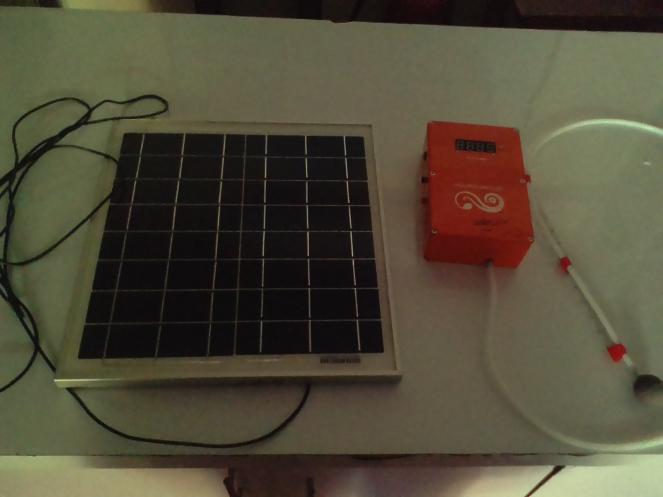
So far, the easier method being used to disinfect water is by chlorination. However, by ozonation, that can change. Ozonation is layman’s term for when oxygen (air) gets mixed with O2 from the device that produces it, and it turns into O3. Using solar as a source of power, we turn on the device and place an aerator in the clay pot of water we are testing. It then bubbles and we leave that to do its work for about 2-3 hours.
.
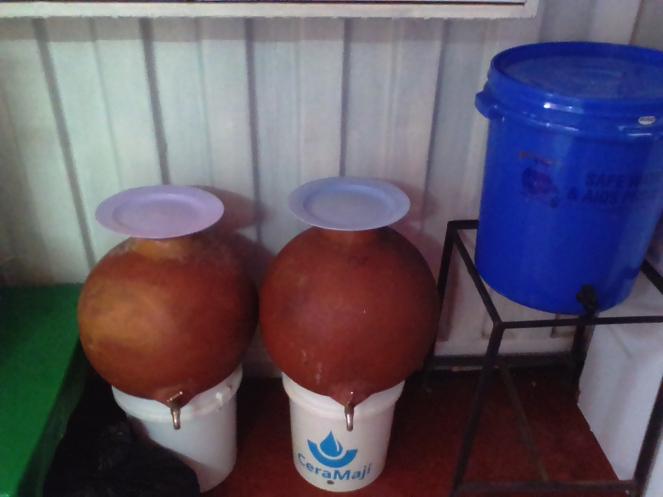
First, the water source is from River Kisian, about a 30-minute drive from SWAP. About 80L is fetched because we want to have at least three different samples of disinfection, ozonation, chlorination and control. Ozonation is what I explained above and chlorination is the simple technique of placing 2 caps of waterguard in the water, stir up and allow to sit. Meanwhile, the control is just untreated water which sits for the duration of the trial. We conduct the test every day, but do new trials every other day; meaning, we fetch water every other day from the river because the trial takes 24 hours to get the results. We want to know after ozonation, do E. coli activity occur when the water sits out for a duration of days? How long can the water sit out for, for people to use? In terms of chlorination, water can sit out for at least 3 days.
.
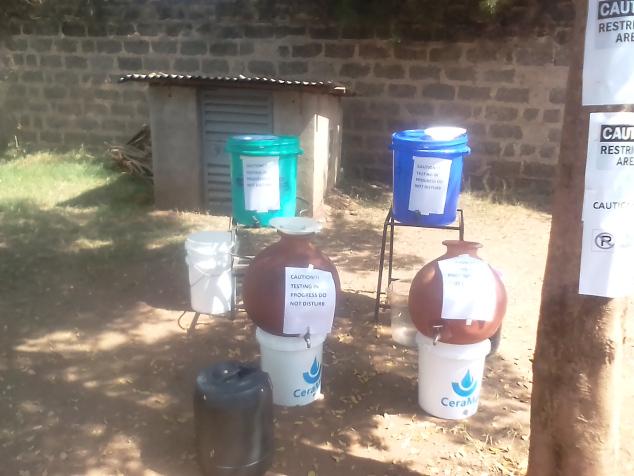
We try to replicate people’s lifestyle by using clay pots that are common in most rural homes and sitting the water out for at least a day; K is on a time-crunch. Also, the cultural belief is that when people see water bubbles/hot/boiling, they believe that their water is being disinfected. Ozonation does a similar chemistry, only it doesn’t get hot. Besides, boiling is not a sure effective way of disinfecting water. There are some bacteria/viruses that have a high boiling point. I digress, but, one challenge we faced was when it rained. Water from the river was highly turbid (due to heavy rain which can cause run-offs into the water-defeats the purpose and most don’t fetch water from the river when it rains, they collect rainwater). So, we took a pause on the study and will resume again on a good day.
.

Once this study turns out to be successful, this method of disinfection can be implemented in rural homes. People can easily disinfect their water without them having an excuse of stating that the water tastes or smells funny (an effect of chlorination). Though, while ozonizing, it produces a funky smell, so we did the study outside the lab. People will be advised to disinfect in a well-ventilated area.
.

While we are not fully there yet, we are halfway there and K and Dr. D are making huge efforts in making sure that we get the right results. We conducted community assessments and it turns out that people are ready for this device to be installed in their homes/community. Most do use chlorination, others allow their water to sit out, but with this new method of disinfection, they are eager.
Of course, there is more to this, but this is a simple, non-boring explanation of ozonation and how it will be implemented in regions that are prone to water-borne illnesses.
Obehi's blog post
Who knew the equator passes through Kenya? Now, I know. Apparently, “Kenya is among only 13 countries in the world that the equator passes through and with some of the most impressive landscapes and wildlife on earth.” (Africa geographic).
.

So, doing fieldwork, my colleagues and I went to a different county, Vihiga county; Vihiga county borders Nandi to the East, Kisumu County to the South, Siaya County to the West and KAKAMEGA County to the North. We stopped at Luanda constituency in Vihiga to assess the water kiosk located in the market, as we plan on installing chlorine doser at some water kiosk sites that do not treat their water.
.

On our way back to the worksite, B, our driver, asked if I had been to the equator. Coming out of Luanda, we hit Maseno, which is a town in Kisumu county. Less than 20 minutes from where we left Luanda, I saw the sign, EQUATOR LINE.
.

We stopped at the roadside to take a picture when a guide approached us and told us about the “magic” of the equator. “The equator runs across Kenya almost in the middle, passing 6km north of central Kisumu. Here you are able to stand with one foot in the Southern Hemisphere and one foot in the Northern Hemisphere as you face the mystery of the line that separates them.” (Africa Geographic).
.

In the southern hemisphere, the water runs clockwise and in the northern hemisphere, it runs counterclockwise and in the center, it doesn’t move. Pretty cool. So, for 100 shilling (<$1), the guide did a quick demonstration which I think is cool. There are different places that you can cross the equator line and the location we stopped at is one of them. Hence, the description of Vihiga county.
.

Delicious meal: Chapati and Fried Tilapia
.

Afterwards, we stopped for lunch before heading back to work. The results for the fieldwork came out to be disappointing because we did not get kiosks or sites that met the requirements and it was raining and cloudy for the most part. I think that this was the highlight of the day that made our mood brighter.
Obehi's blog post
Transportation by Bodaboda is a cheap way to get around, but also a way to test your negotiating skills. So, in my previous blog, I mentioned how easy your life will be if you become short-time “bffs” with a bodaboda man. Having a trusted bodaboda guy will save you the hassle of negotiating prices anytime you go out. Just tell them your agenda for the day and when you would like them to be available. They are easily reliable.
.

I have made friends with some of them; however, calling them and making arrangement is bothersome on my part. I usually just hop on any bodaboda, but before I do, I ask for the price. From Dunga (where I stay) to work is 50ksh. If I don’t go with my regulars, I get charged 70-100ksh. I look at the man and tell him flat out, “I am paying 50, don’t think I don’t know you are trying to do.” I say this all the time, so they just smile and tell me to hop on and off I go. Usually from home to town is 50, but if going further it can be 70-100ksh. You just have to negotiate if you believe the price to your location is unreasonable.
.

From work back home, the bodabodas try to charge me 70-100ksh and that’s due to the fact that my work is located in a richer suburb, so they assume I should have the money. Even though I’ve made friends with all of them and they greet me by my nickname every morning I come to work, they still insist I pay 70ksh. If they keep insisting I pay 70 instead of 50, I walk to either a different bodaboda stop or just walk home. It is not about the money, but sometimes, the bodaboda charge more than they should just because they can. Therefore, you just have to be smart and stick to a strict negotiating manner, or you get ripped off.
.

There are also other ways of getting around. Hopping on a tuk-tuk (three-wheeled bike) which is a little bit more expensive, about 200ksh can take you to places that are a little bit farther. I haven’t taken a tuk-tuk because my personal travels are within town.
.

Another form of transportation is a matatu (bus). This is when you are going to places farther than town. I use this when I am going to the field, but hardly. It depends on where you are headed, but the price usually ranges from 100-200ksh. You just negotiate with the conductors. If you don’t speak Swahili or Luo (Kisumu is mostly Luo tribe), then just pay the amount because the conductors are harder to negotiate with.
.

Lastly, a bicycle is an option to get to your nearest destination. They are the cheapest form of transportation, but sometimes, they charge the same price as a bodaboda. As you can see, if you don’t have a car, there are quite a few options of getting around. If you are super rich, you can board a taxi and call it a day. Otherwise, live like a local and enjoy the adventure.
.

Passenger on a Bodaboda and a Bicycle
Obehi's blog post
So, I told myself that I won’t become one of those tourists in Kenya that does a safari trip, but then I caved in when my co-workers told me the beauty of the Mara. N, my colleague, found a booking company that would help us arrange for the safari trip. I am not too sure of the company’s name, but there are tons of company in Kisumu for this trip.
Anyway, we booked the 3-day safari package. Since we are students, we did not want to pay the full price, so N tried to get us the student package. Normally, in order to guarantee a student discount, you are to book a month in advance, maximum 2 weeks. We booked our trip a week in advance and still got the discount! Also, the more people you have, the less you pay. In total, we were six tourists that would board a safari van.
.

It is best to do these trips on a Friday, that way, you enjoy your weekend. Also, July-October is the best time to see wildebeests migration. We did our tour towards the end of June, so the migration had already begun. The wildebeests migrate from Tanzania to Kenya.
On Friday, we met with the agent and paid the fee of 12,300ksh (~$120). Then, we boarded the tour bus. From Kisumu to the Mara, it takes about 6 hours. Now, the safari trips come in packages. The more you pay, the better the accommodation and tour van. Like stated, we are students and did not want to spend more than we can afford, hence the price. So, upon arriving at the Mara, we lodged Mara Sida Camp which was a three-minute drive from the Mara. That means we lodged outside the Mara.
.

After paying the gate entrance fees (we ended up paying $45 instead of the initial $80 as we showed our student ID), we learned the rules of the Mara. At the entrance of the Mara, it is guarded by park rangers and soldiers. There were also women selling some Maasai items. Be warned! They swarm you like flies and you have to be ready to say no and hold your ground or buy something. They are pretty affordable than in town, but you can still negotiate the prices.
When we began our first tour in the Mara, I was in awe. Words cannot express my emotions on how beautiful the savanna was. We toured for 2 hours coming across wildebeests, Thomson’s gazelle, common-ground zebras, cheetahs, lions, elands, birds, acacia tree, etc. Below you will see many pictures from the tour!
.

Gazelle in Masai Mara
.
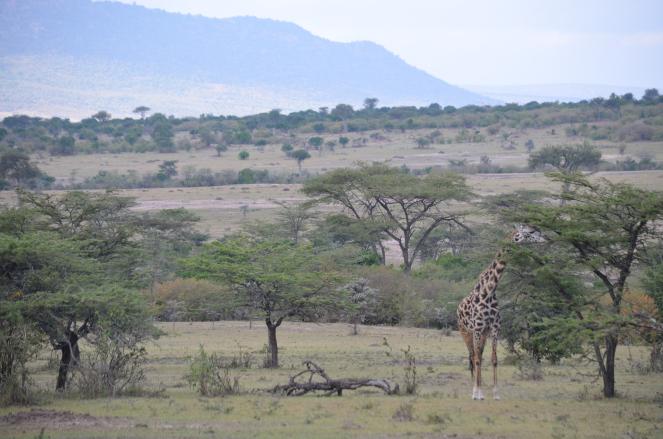
Giraffe in Masai Mara
.
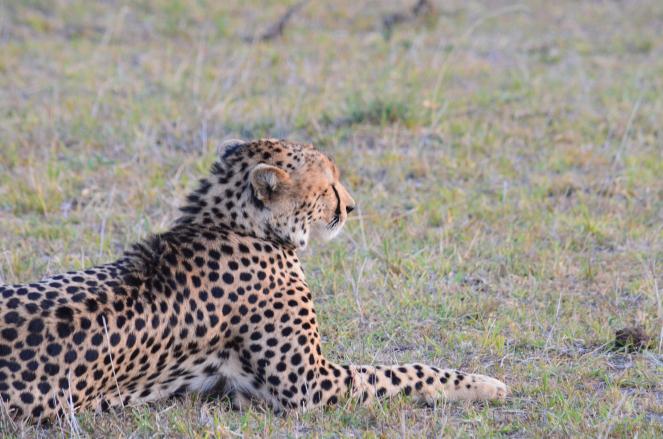
Cheetah in Masai Mara
.
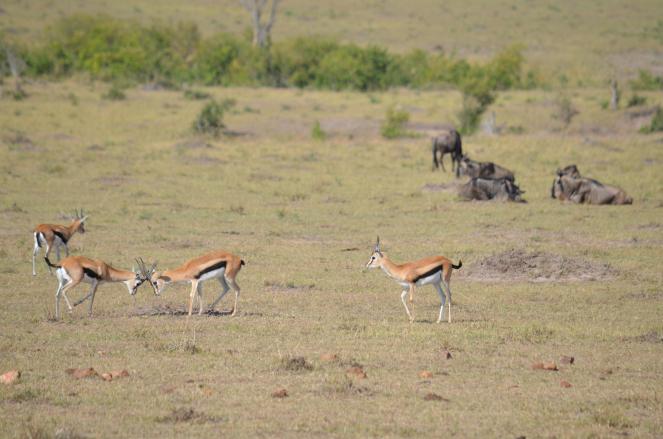
Herds in Masai Mara
.
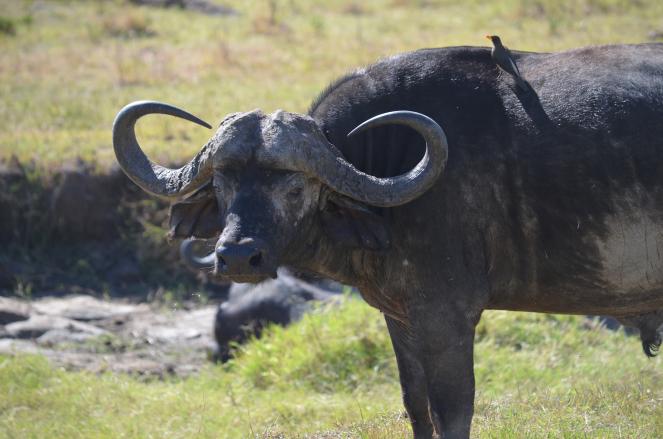
Masai Mara
.
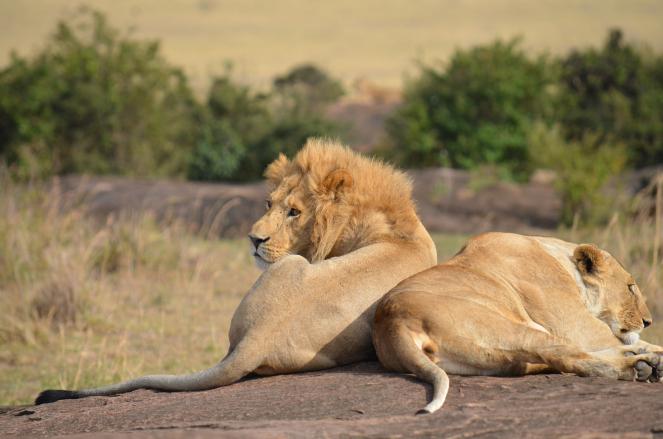
There were a lot of tour vans/buses that surrounded these animals, so the animals were on high alert. There was a group of loud private tour cars and we felt it was best to drive away from the crowd before we saw a person get attacked by the lions and/or buffaloes. Buffaloes are unpredictable, so it’s best to stay far away.
Around these animals we were told to be quiet as not to draw attention. We drove off and came across a wounded lonely hippo. We got closer to get a picture, when hippo sensed our presence, stopped, stared at us.
.
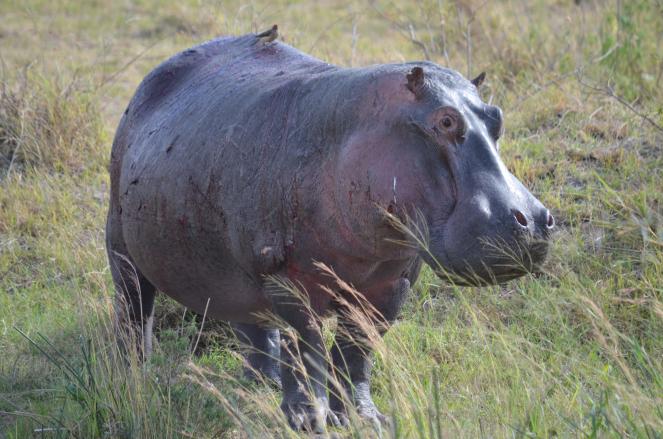
We continued the drive deep into the savanna and it is just beautiful the way the mountains and plain lands mesh. Wildebeest, zebra and Thomson gazelle co-habitat. We continued to drive when we spotted a small landing site where planes come in. I guess you can fly into the Mara because not too far were some camps inside the Mara.
.

More herds in Masai Mara
.

After our day adventure, we rested for a while and at about 4:30pm, Lucas had arranged for us for the Maasai security guards to give us a tour in this Maasai region. First of all, the Mara (reserve) is located in the Maasai land. Secondly, since this is their home, they are the security guards found in most camps. The reason being that they are experienced in knowing how to “deal” with wild animals that occasionally come into town. It is a clash of humans and animals. Anyway, our tour guide, Makeno was a delight. Not only does he speak English, but he was funny.
.

Many do not know, but the Maasai of the 21st century are now integrated with the western ways. So, they are advocates for education, especially for the young ones. Hence, they have a community center and a school inside the center. I am not sure if this is in every Maasai unit, but, this was the case in this particular town where we were lodged. Upon entering the village, we were greeted by Makeno’s younger brother, John, who is a university student just visiting home. He encouraged us to take pictures and/or record our interaction with them.
They performed a lovely welcoming dance, taught us how to make fire and we were split into groups to go into their homes where they told us more of their lifestyle in modern age. Afterwards, they persuaded us to buy some items, which we unfailing did. Though, they are pushy bargainers, so you need to know how to bargain, or you end up paying the price they call at you. At the moment the exchange rate is ($1/100ksh). So, paying them in Kenyan Shillings or dollars was the same. I did some transactions in dollars and shillings. Most items can be found in the Maasai market in Kisumu, but the prices vary, (though, I found them to be similar, recently).
.

*Touring the Maasai village costs about 2,000ksh and that’s because the money goes to the community center. Thankfully, Lucas spoke to them and they gave us a discount of 1000ksh. I know this because I confirmed with a different guide who said he charged his tourists the regular price.
.

On Sunday at 7:30am, before leaving, we had a “photoshoot” with the Maasai guards and I gained a “husband” in Makeno as he took a huge crush on me, haha! We headed out of camp, after having breakfast, heading home. We had the option of touring again before leaving, but Saturday’s day-long tour was enough. If we had decided to tour again, we would have spent an additional $45 for a two-hour tour. Overall, we had a great experience. Our tour guide, Lucas, was the best! I will find out more details about the booking and update the information. Lucas, a vet in his field, is the best. He has been doing this tour for 9 years and he loves it. If you love your tour guide, it’s best to appreciate them after the tour. He knows a lot about the animals and what there is to know about the reserve.
Overall, it was a pleasant experience and I am glad I went. Make sure you hold a scarf or long-sleeved shirt. On our way, it was hot and dusty, but at night the temperature dropped. Also, it gets cooler in the van when touring.
*Total money spent on this trip $168 as compared to the $270 I had budgeted for. WORTH EVERY PENNY. As a student, DO NOT FORGET YOUR STUDENT ID in order to get the discount and do ask for a student discount or you pay the foreigner’s price.*
Obehi's blog post
This post is mostly for students planning on doing their internship in Kenya. Most specially, students from UIC doing their Masters in Public Health.
.

Being a Global Health and Environmental Health student focusing in water quality, I had to fulfill both requirements. So, I applied to the UIC SPH Kenyan Program. The program varies depending on your focus. Since I am focusing on water quality specifically, I wanted to learn about water quality in an African country (new potential career path); I was placed with SWAP– Safe Water and AIDS Project in Kisumu. This NGO has other non-water related project as well; so, it is a well-rounded organization. I think UIC students do their internship in Western Kenya, mainly Kisumu, due to the relationship built with the organization by UIC.
.

The school took care of basic worries (housing and food). We did a home-stay with a family that has worked with a professor from UIC (Dr. Bob Bailey) and the UIC SPH. The home stay provides meals, except during weekdays when we are at work. You can decide to take lunch from home if you don’t want to buy food outside. However, if your work takes you out of the office constantly to do fieldwork, it is best to buy food outside. Besides, you need to eat local food to truly enjoy the country.
Anyway, the only thing not covered by the school is when the budget tip comes in.
Upon arriving at Nairobi, we got picked up by an arranged contact that has worked with Dr. Bob. Therefore, we didn’t spend money on a taxi.
.

He showed us part of Nairobi. P.S. Nairobi is a little bit more expensive in terms of eating out.
1.Giraffe sanctuary: 1,000ksh entrance fee (~$10) for people older than 25 years old.
2.Elephant sanctuary: 1,000ksh
3.Lunch (depending on what you ordered- >800ksh (>$8 depending on where you go).
2 months Budget in Kisumu
1.Transportation and Food combined for 2 months= $500
2.Flight: $1,200 maximum. If you spend more than that. You booked late.
3.Visa: Kenyan visa (can be bought in Kenya $50 or East African visa $100 if you plan on going to other East African countries.
4.Activities: Safari trip ($300 max, look for student discounts when booking. You don’t need luxury style of touring). Other trips: ~$250 if you take buses to your destinations. Total $550
5.Miscellaneous: making/buying an African print outfit, buy gifts for people, etc. If you budget your spending well, you don’t need extra money. Be smart about how you spend. Live within your means.
TOTAL = $1,000 FLIGHT
Make sure you have an account/card in the US that doesn’t charge international fees at the ATM. If you do, it’s best to bring what you need and exchange the cash as you need. DO NOT EXCHANGE ALL YOUR MONEY AT ONCE BECAUSE RATES FLUCTUATE and the bank withdrawal gives you less than a money exchange center. So, change your dollars according to your needs.
.

Two months is almost over and I have spent about $700 and that is due to buying gifts for everyone in the US.
.
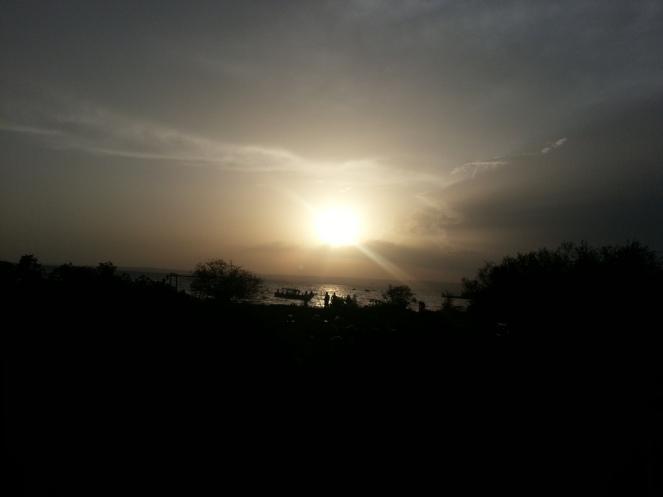
So, don’t freak out if this is your first international work. Due to the good relationships built by the school, we were received well. I work with hardworking and funny people at SWAP and they are more than willing to help. Don’t be lazy and do your work. Converse, be friendly and open-minded and I promise that you will not want to leave Kenya after your internship experience is over!